The project is developed in an old house in the neighborhood of Palermo. A complete reorganisation of the space was carried out, generating two accesses to two spaces of different uses that complement each other according to the hours of operation of the restaurant.
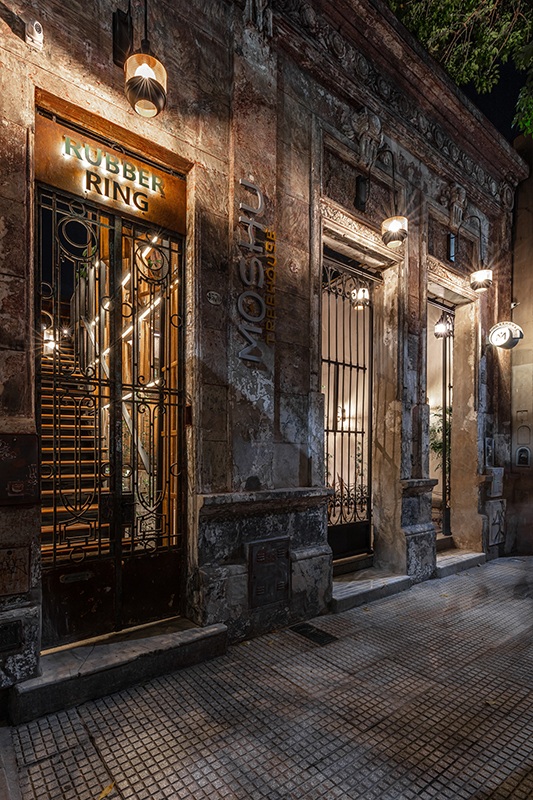
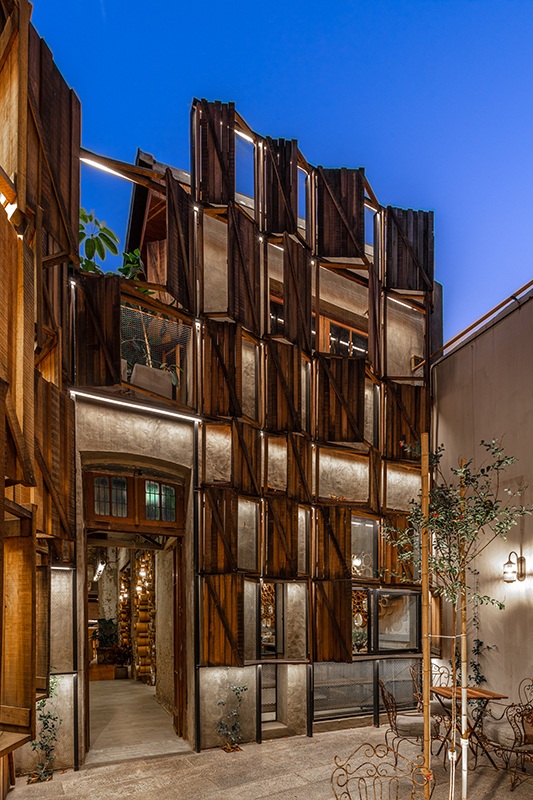
Considering the history of the old houses of Buenos Aires, the courtyards have always been a space of congregation. So the first great design strategy was to create an access courtyard immediately after the façade as a symbol and blow of effect. This allowed to have a new façade of its own language, and as a consequence to preserve the old style of the main façade. From the point of view of operation, the patio is fundamental for the take away model and also explores outdoor post-covid use.
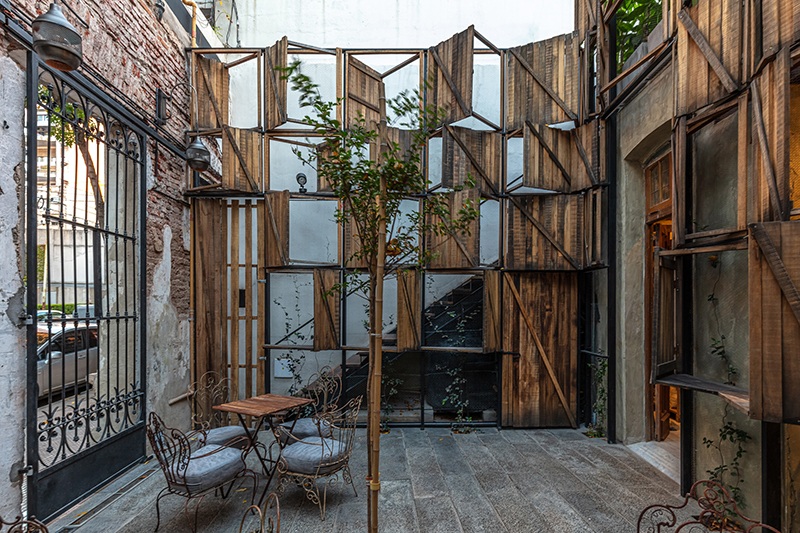
The proposed language was the result of a deep analysis of the elements that define the gastronomic proposal, a proposal that boasts of a type of American pastry. Hence the reference to the old way of "cooling the cake by the window" and its corollary proposal to use multiple windows on the façade of the entrance courtyard.
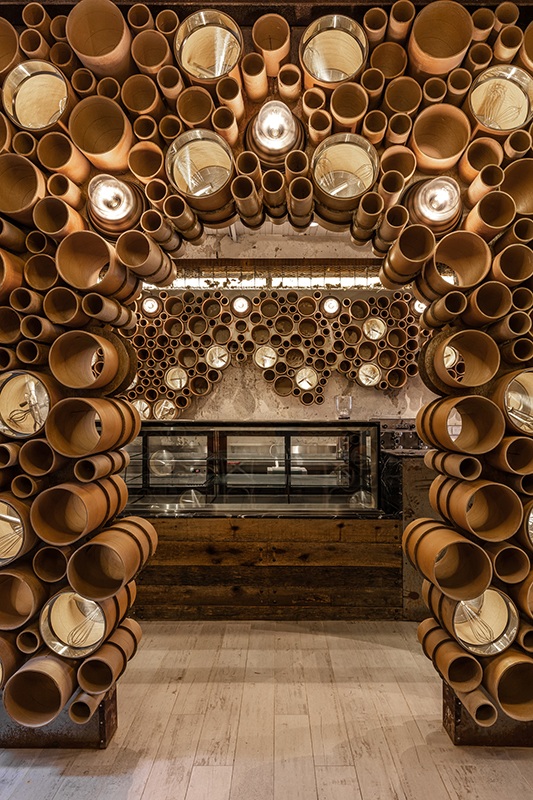
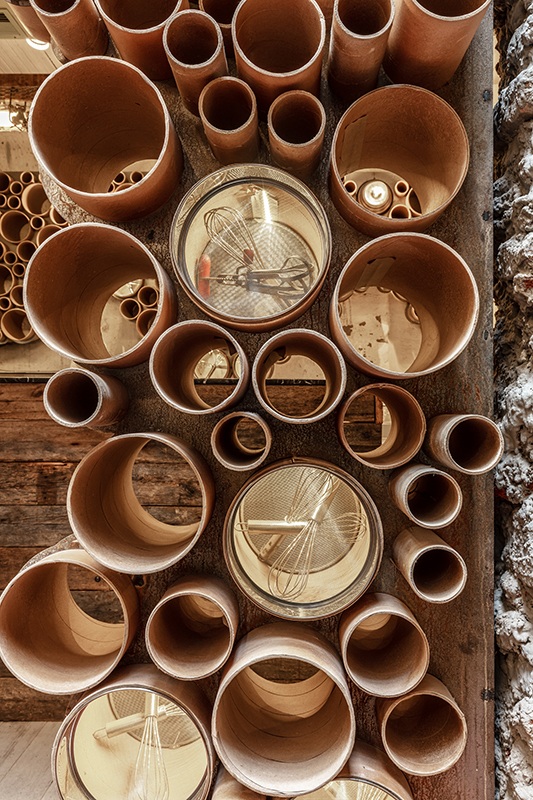
Another determining element has been the abstract representation of cakes built by cardboard cylinders, as a system of "skins" that cover certain areas such as the entrance arches and the bar back, a place that attracts all eyes in the purchase process.
These "cakes or cakes" also include two traditional symbols of pastry, the strainer and the whisks, both elements we condense into a single piece as a symbol.
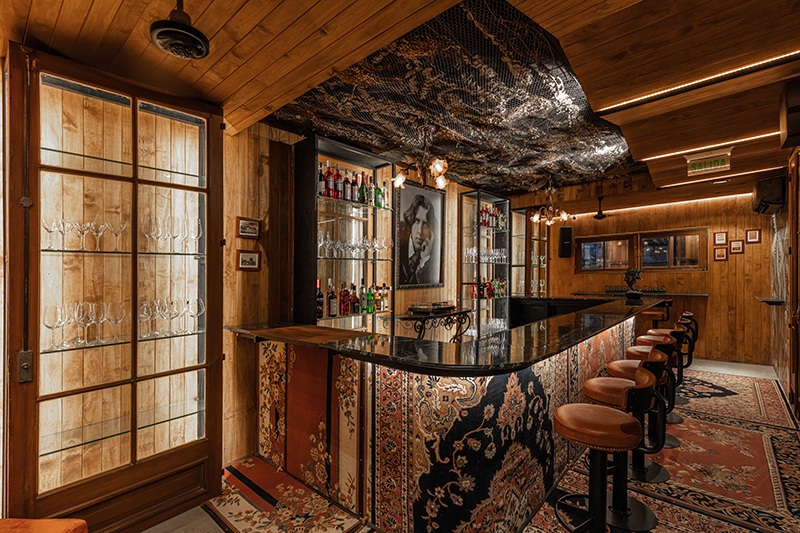
The language of interior architecture is a vernacular composition of the typical demolished industrial style. From this word "demolished" started the idea of using elements that simulate an "under construction" area, that is, scaffolding woods, construction irons, metal fabrics. All neutral materials that make up a universe of constructive sieves and background a demolished house where dry vegetation takes possession of an old house that seems to be in a state of abandonment.
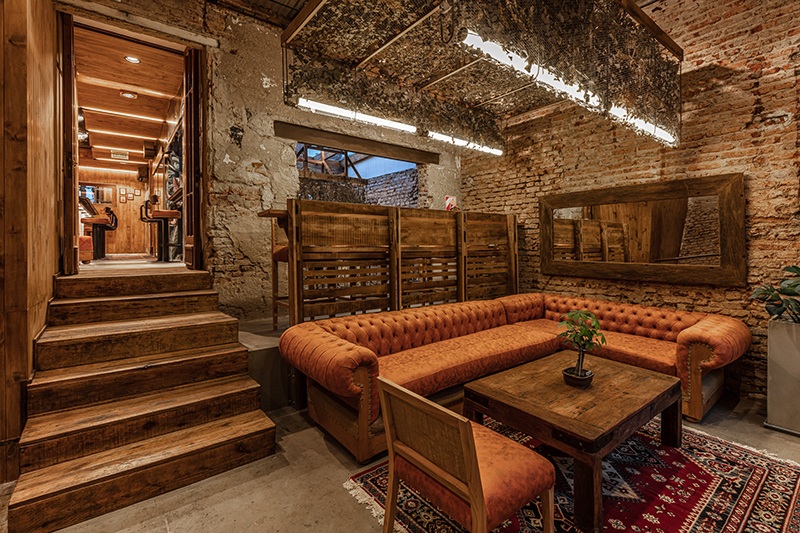
Lighting has become a distinctive element built with wooden structure supports and surrounded by dry vegetation, as a poetic act of how vegetation can take an abandoned wooden scaffolding structure.
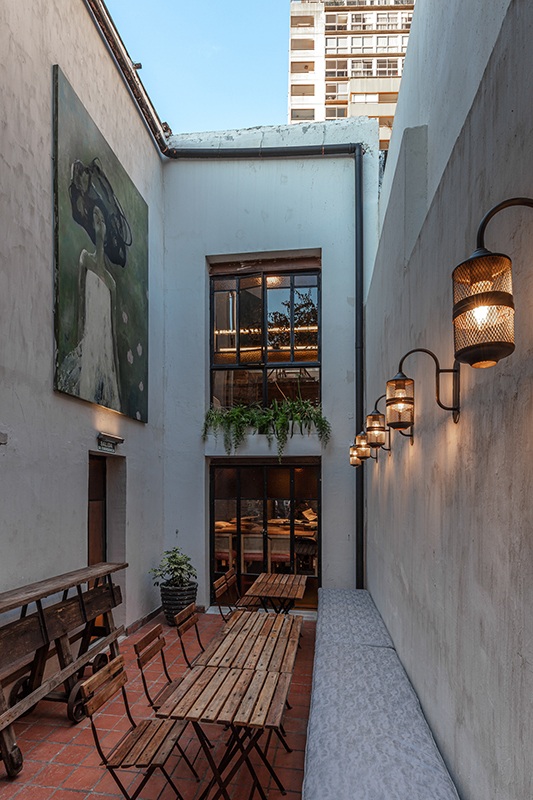
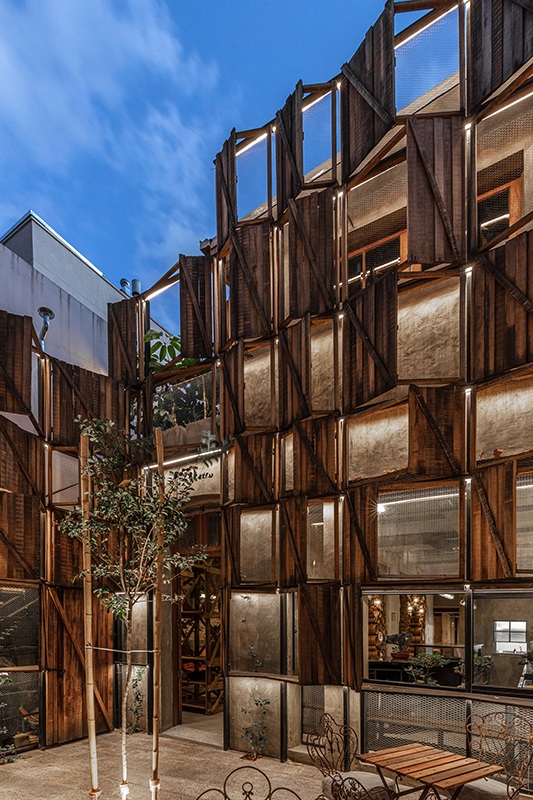
On the first floor, crossing the symbolic wooden windows and a large vegetation that climbs through them, we find a private room where the high cocktail bar takes presence. We emulate through the symbolic Lagerstroemia tree in the center of the courtyard and the use of wood around the courtyard the idea of the house in the tree. Hence its name Moshu treehouse.
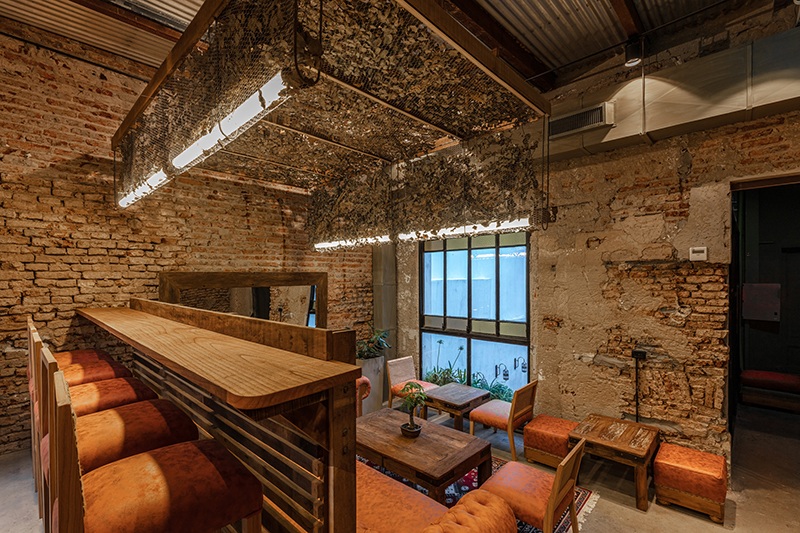
About Hitzig Militello Arquitectos
Hitzig Militello architects carries out commercial projects, fundamentally interior design, locally and regionally in Latin America, as well as in Europe, the Middle East and the USA. With a special focus on the hospitality industry (gastronomic and hotel) as well as the development of spaces for tech startup workspaces. They came to position themselves as true creators of brand identities, obtaining international recognition for their concepts and executed work.
If you’d like to feature your project here, get in touch to find out more.
If you’d like to become SBID Accredited, click here for more information.
This week’s instalment of Project of the Week series features a dual café design by 2021 SBID Awards Finalist, 4SPACE Design.
SBID Awards Category: Restaurant Design
Practice: 4SPACE Design
Project: Coffeetea
Location: Dubai, United Arab Emirates
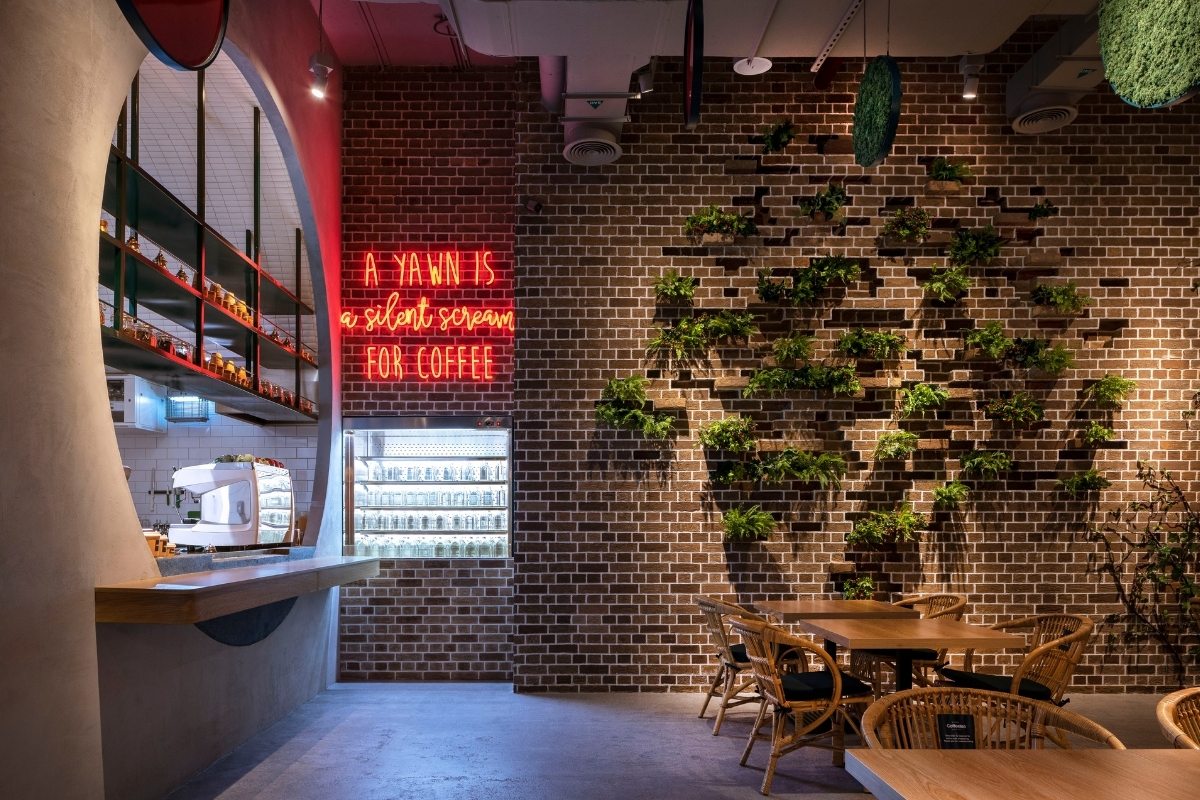
What was the client's brief?
The client wants to elevate the interiors of Coffeetea's new branch in Dubai International Financial Center (DIFC) that will reflect its branding identity and the story behind the name “Coffeetea”.
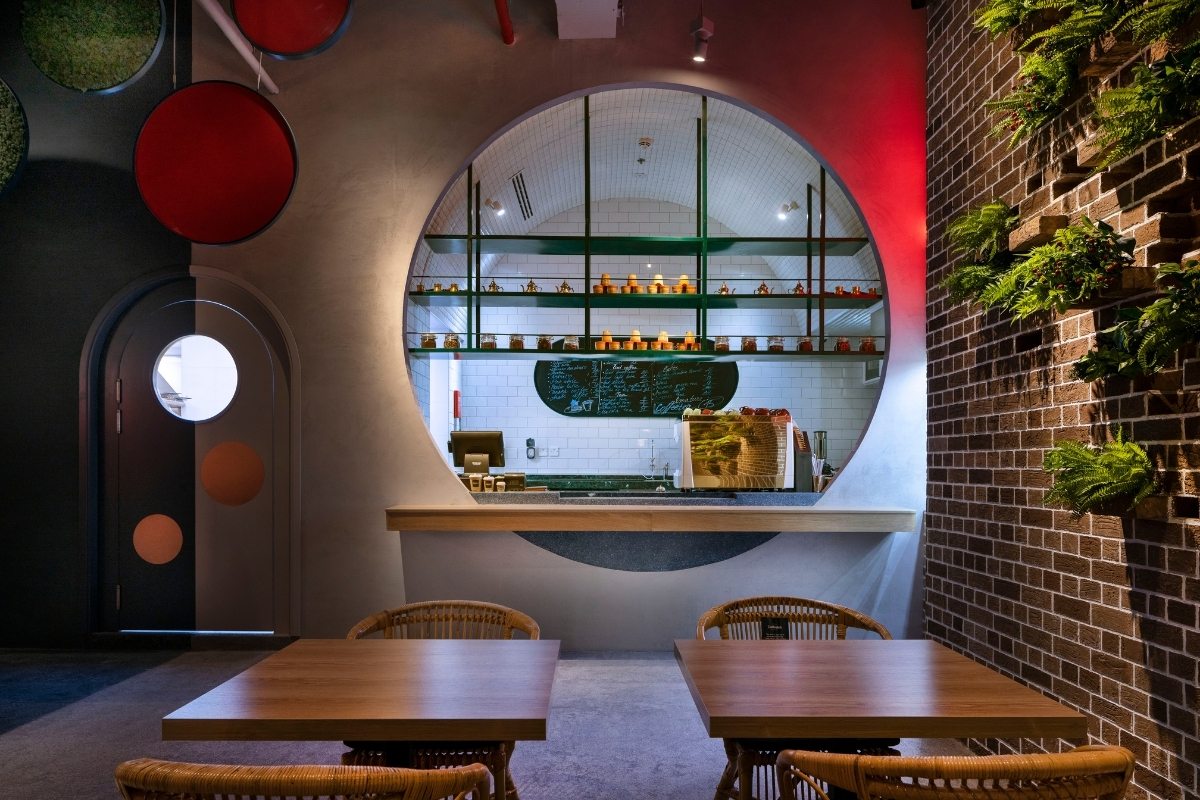
What inspired the design of the project?
Coffee, tea, or both? Give it a gentle stir and get ready to indulge your taste buds in a unique blend of taste and flavors. This unique perspective gave 4SPACE an idea on how to elevate the interiors of the new branch of Coffeetea located at the financial hub of Dubai, DIFC.
This 200 sqm café has a split concept that is derived from having a split personality between a coffee lover or a tea lover. The green represents tea and the brown represents coffee. It’s a very literal translation but the result is outstanding. A distinctive visual style that creates an inviting destination and international appeal. This café is designed to offer an experience that disconnects customers from the hustle and bustle of everyday life. The ceiling design was inspired by the coffee bean in its original form while it’s on the Arabica Tree; the green preserved moss replicates the leaves while the red glass characterizes raw coffee beans. On the floor, we used a German Technology called Stein Art, an exclusive sandstone that gives the space a distinctive mood.


What was the toughest hurdle your team overcame during the project?
Aside from the tight deadline, the client has a tight budget as well. As designers, it is our responsibility to look for alternative solutions that will suit the client's budget but are still aesthetically appealing and functional.
We sourced materials which are available locally and are sustainable (with low VOC). We made sure that all the materials being installed are durable and as per the original design intent.


What was your team’s highlight of the project?
The symmetrical pattern of arches on the wall and the floor provides layers and design features that are very minimalist and refreshing. The façade projects a sense of grandeur welcoming the customers with a vivid and nostalgic color palette. There’s a feature for brick walls with recessed plants in the shape of a tree that promotes a biophilic approach. To add the feeling of an outdoor backyard, a window with droplets was created to deliver a cozy ambiance. The contrasting hard and soft colors and design details reflect the characters enhanced by the branding integrated into the café through the signage.
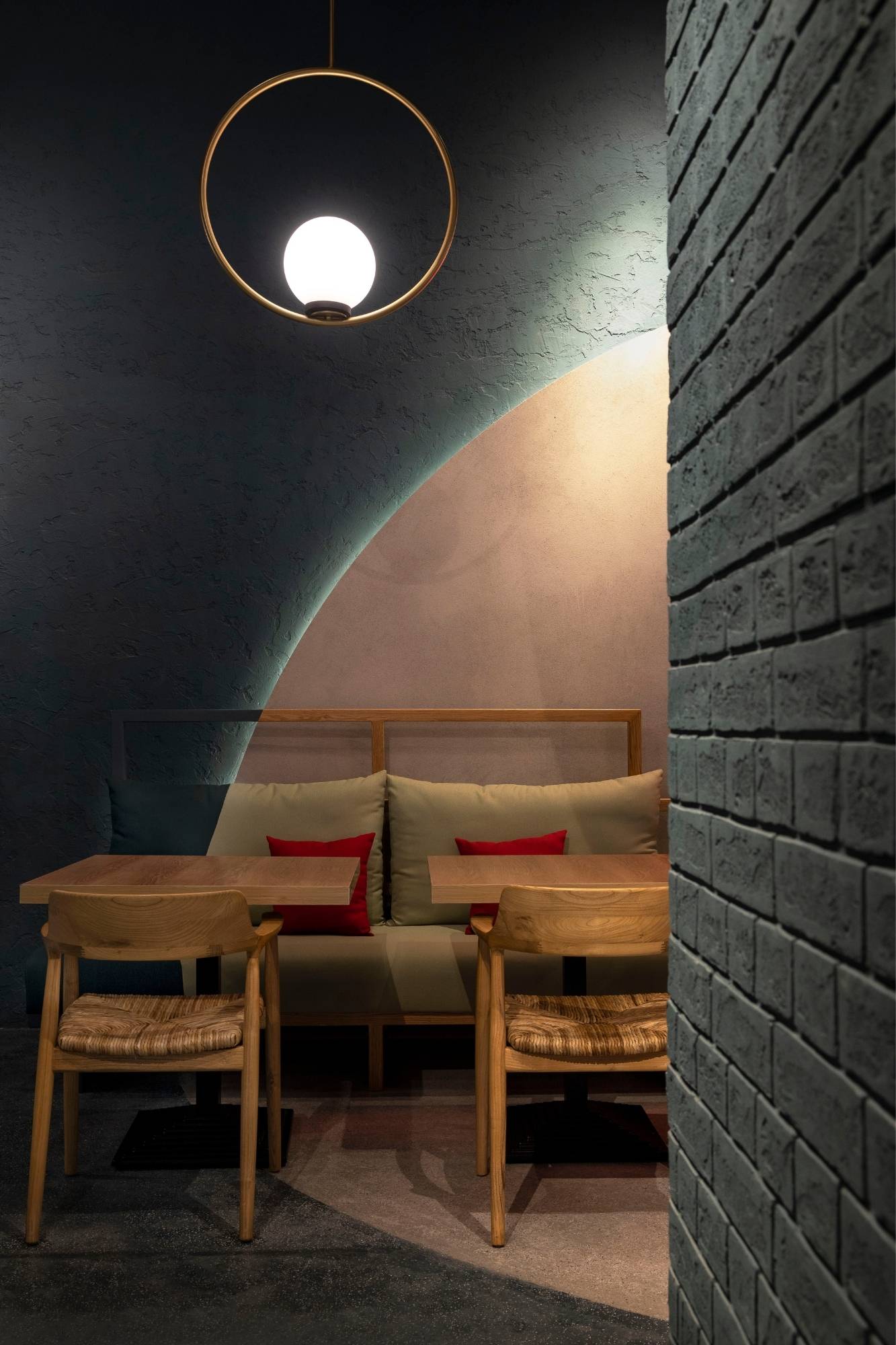
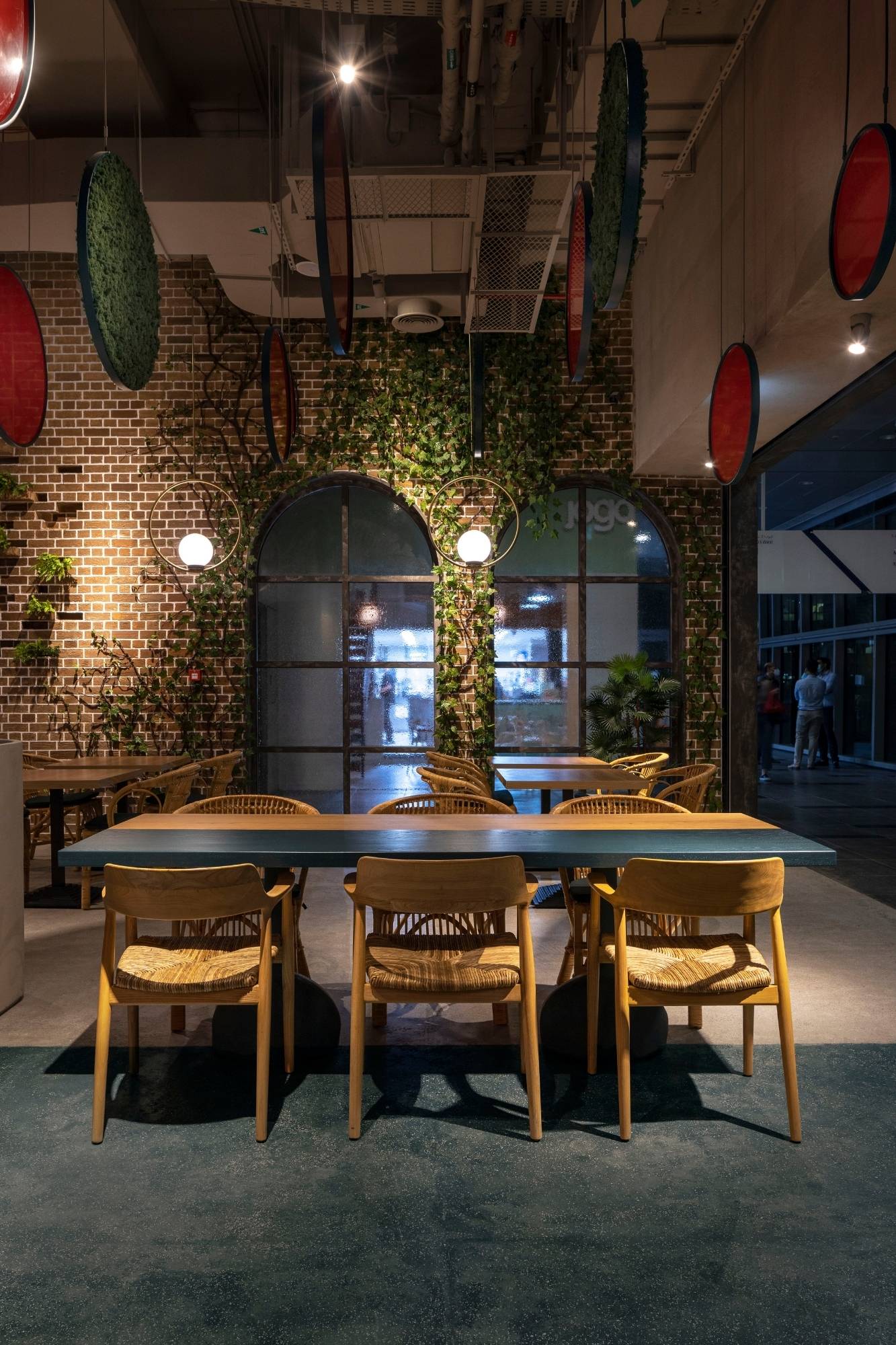
Why did you enter this project into the SBID Awards?
We’ve been participating SBID awards for 7 years, and our Co-founders are both SBID Members. We believe on its vision and so we are always proud to share our projects to the SBID audience, this time it is “Coffeetea”. 4SPACE have designed and created an imaginative and evocative space that has a relaxed and indulgent atmosphere; a hospitality experience infused with local café culture.
Questions answered by Firas Alsahin, Co-Founder, 4SPACE Design.
Kactus is a contemporary café in the heart of Saudi Arabia’s energetic capital, Riyadh. 4SPACE has designed this eatery in highly Instagrammable colours of vintage pinks and greens. The textures and fabrics used to create interest are oak, steel, leather, terrazzo, bold curved mirrors, a wall full of letters, and plenty of cacti. The café is an expression of international and contemporary lifestyles that celebrate youthfulness and culinary abundance. Kactus is an impressive 230 square metres of glorious space that nods to the 1950s and cleverly blended with industrial touches with corrugated wooden walls and clever pipe lighting.
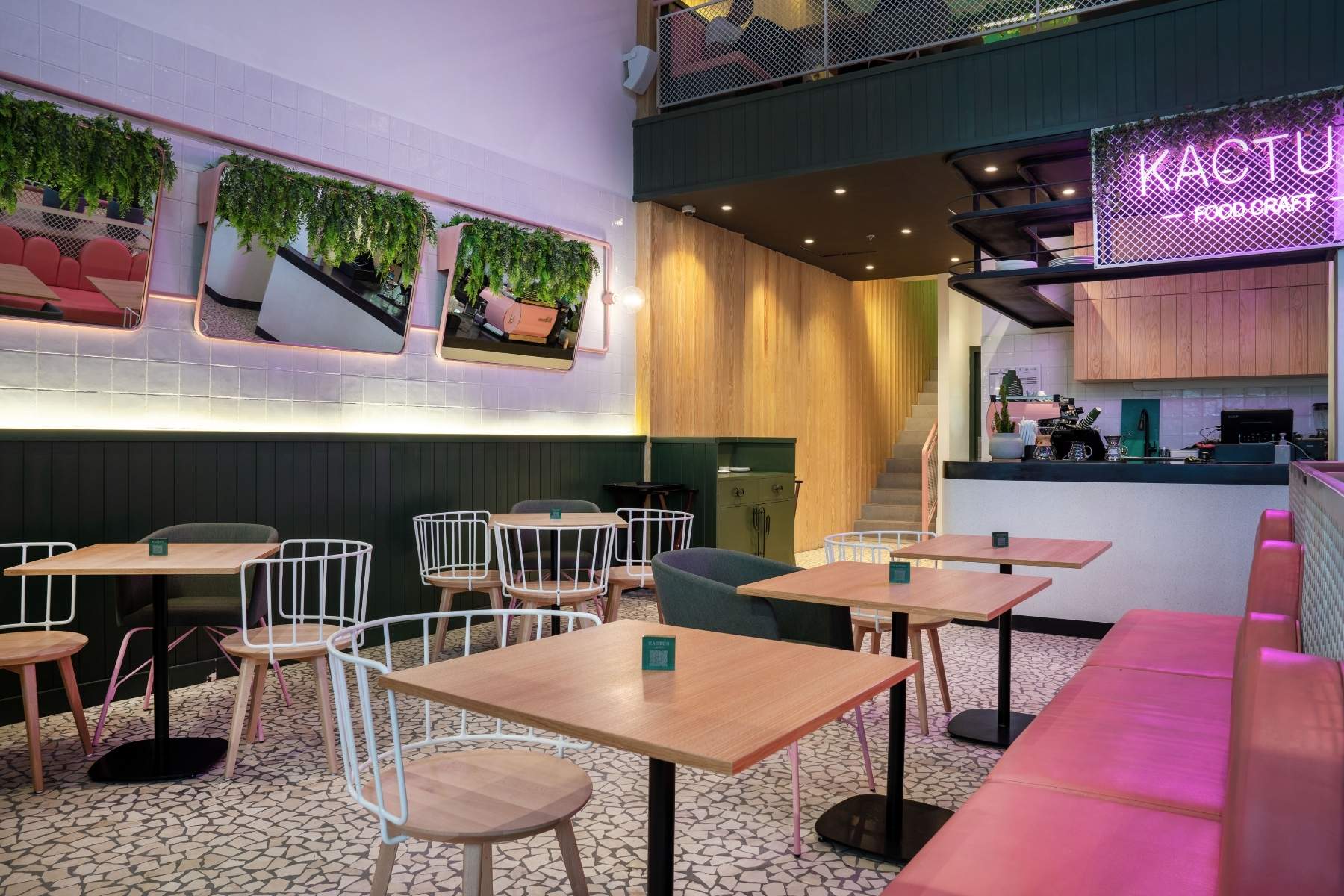
Project brief
The client’s brief was simple. They wanted Kactus to look bright, fun, lively, quirky, inviting and comfortable. The use of various textures allows a sense of depth and discovery to keep diners coming back to their favourite city spot. Cactus plants are used throughout the design and are the central focus of desert biophilic living.
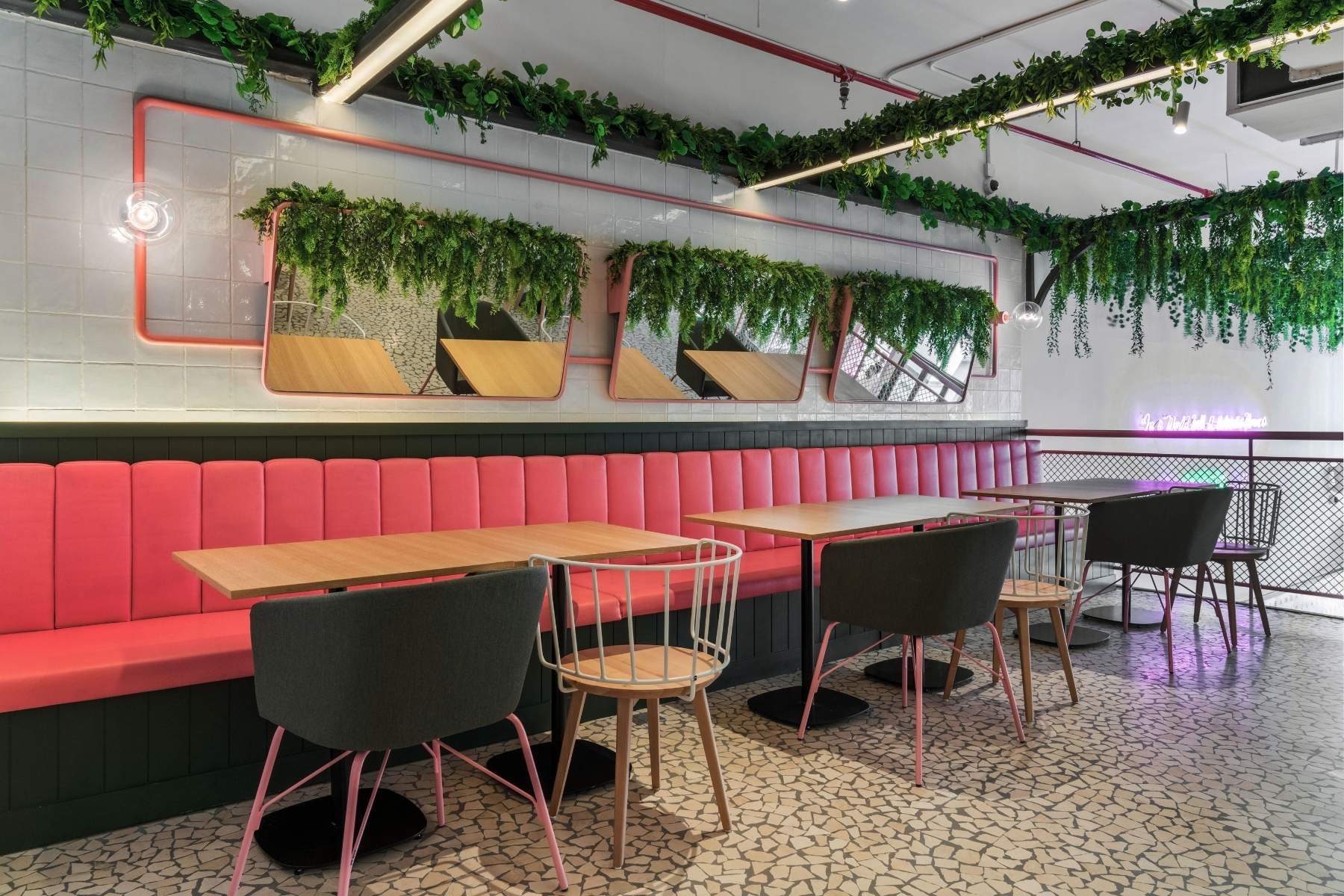
Concept
Kactus has a modern, chic, tasteful, and contemporary design and was wholly inspired by the fascinating xerophytes. The cactus is a collection of interesting plants that have adapted to live in extreme conditions and harsh environments. Cacti are found in arid, hot deserts across the world. Xerophytes have curious, almost animated features to prevent water loss, including thick, fleshy leaves covered in waxy, spiky and hairy coatings. Kactus allows patrons to connect to nature within a city environment. 4SPACE has paid attention to the unique requirements of desert biophilic design to create a refreshing atmosphere. Think baby-boomer years in Saguaro National Park and towering green desert sentinels that pepper endless landscapes under flushed pink skies.
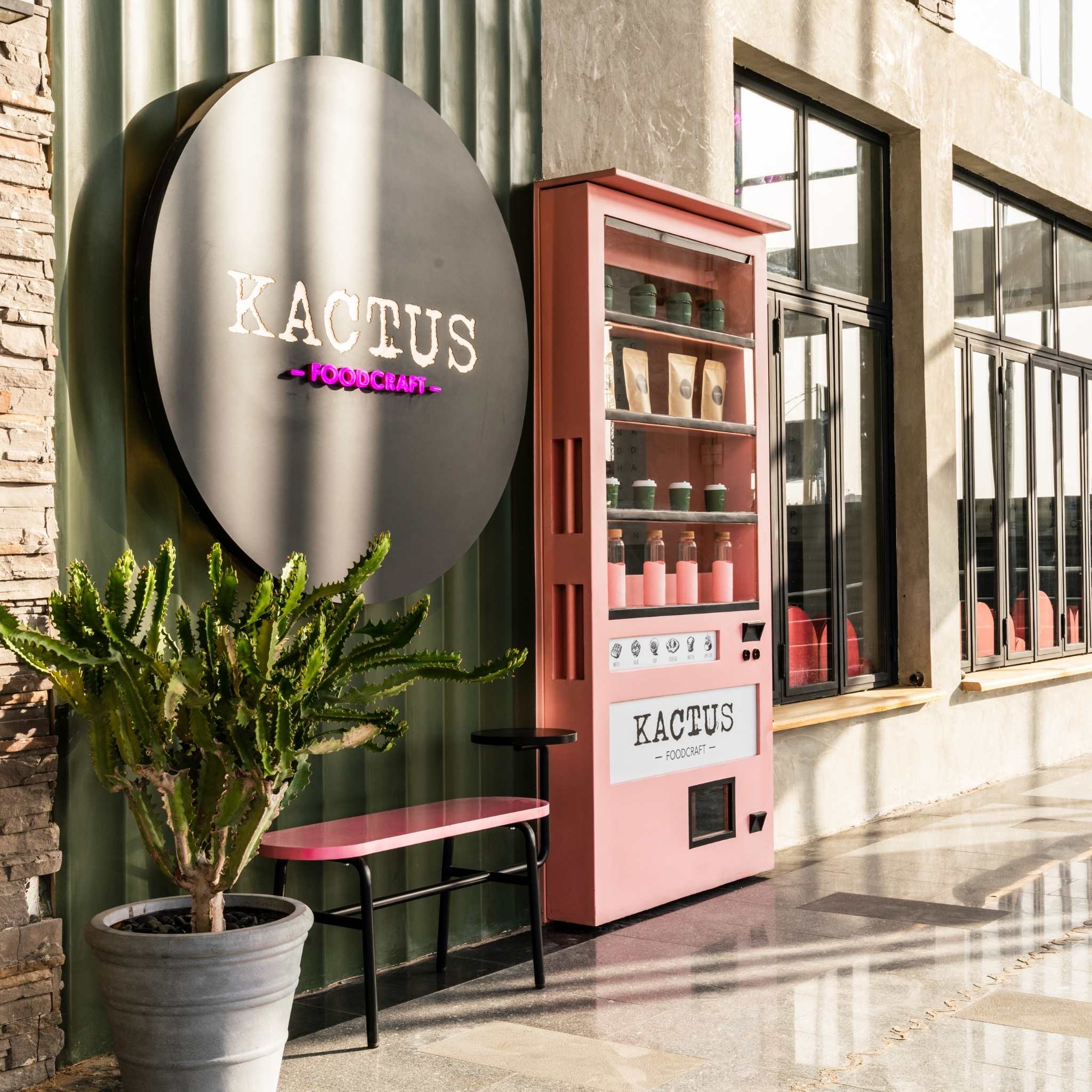
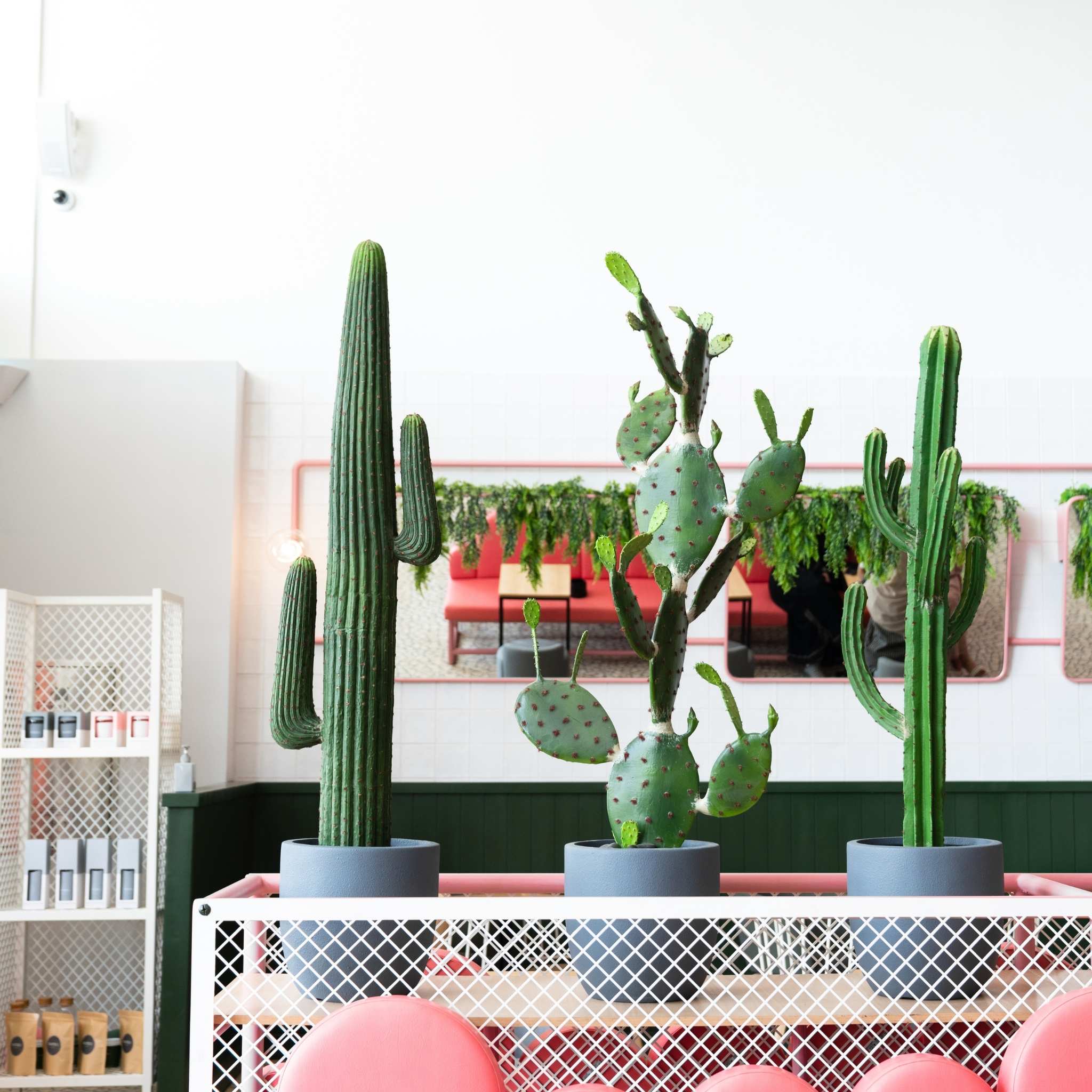
Various design elements
4SPACE has highlighted an open ceiling concept with beams, hanging plants, and linear lighting at the mezzanine level. The walls and ceiling are kept clean and white and provide an unadorned backdrop for strong accent colours. A seemingly haphazardly placed lens mirror installation provides a central focus. Clever placement of a pink vending machine door, the expansive crossword wall and cacti of various heights, shapes and sizes provide a beautifully screwball vibe.
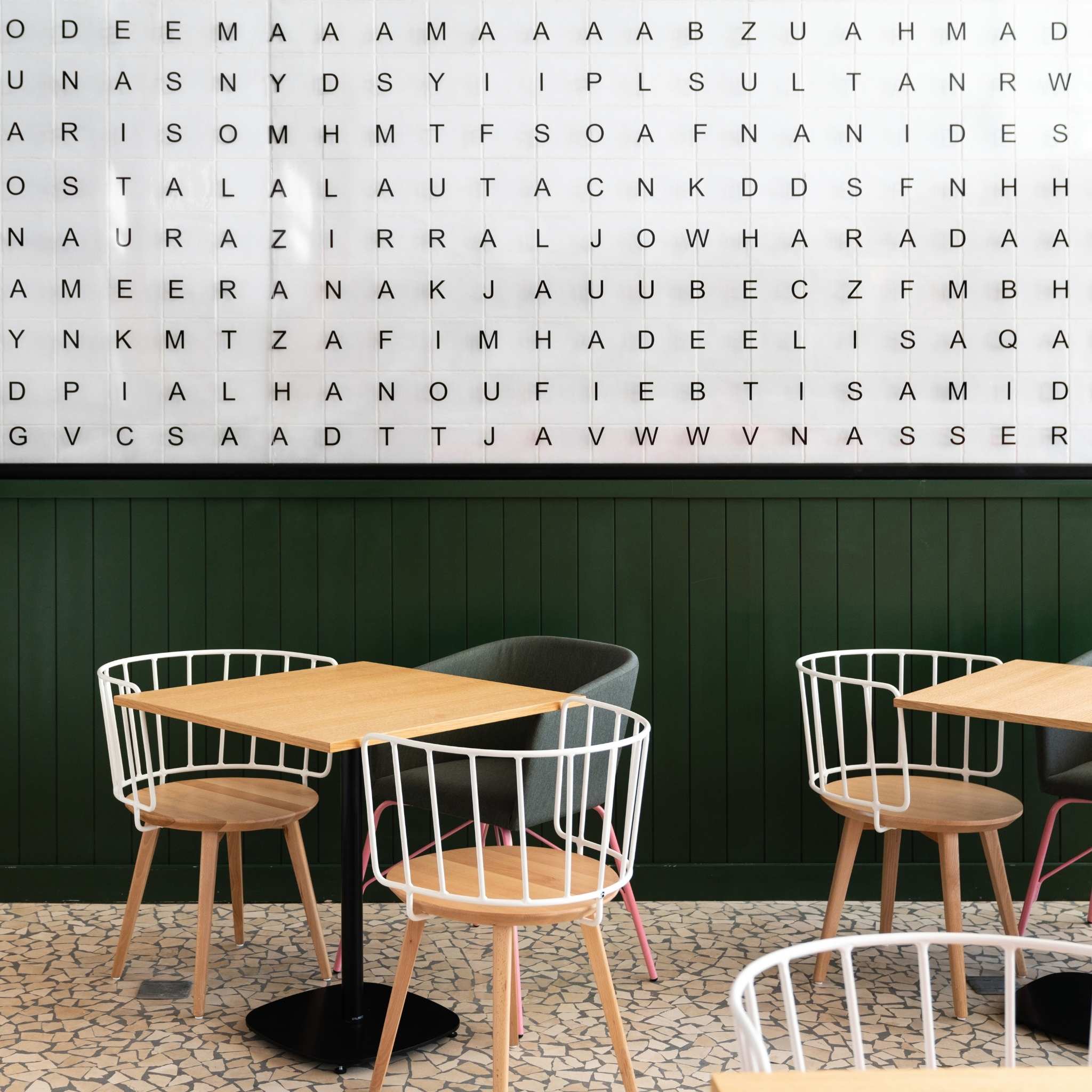
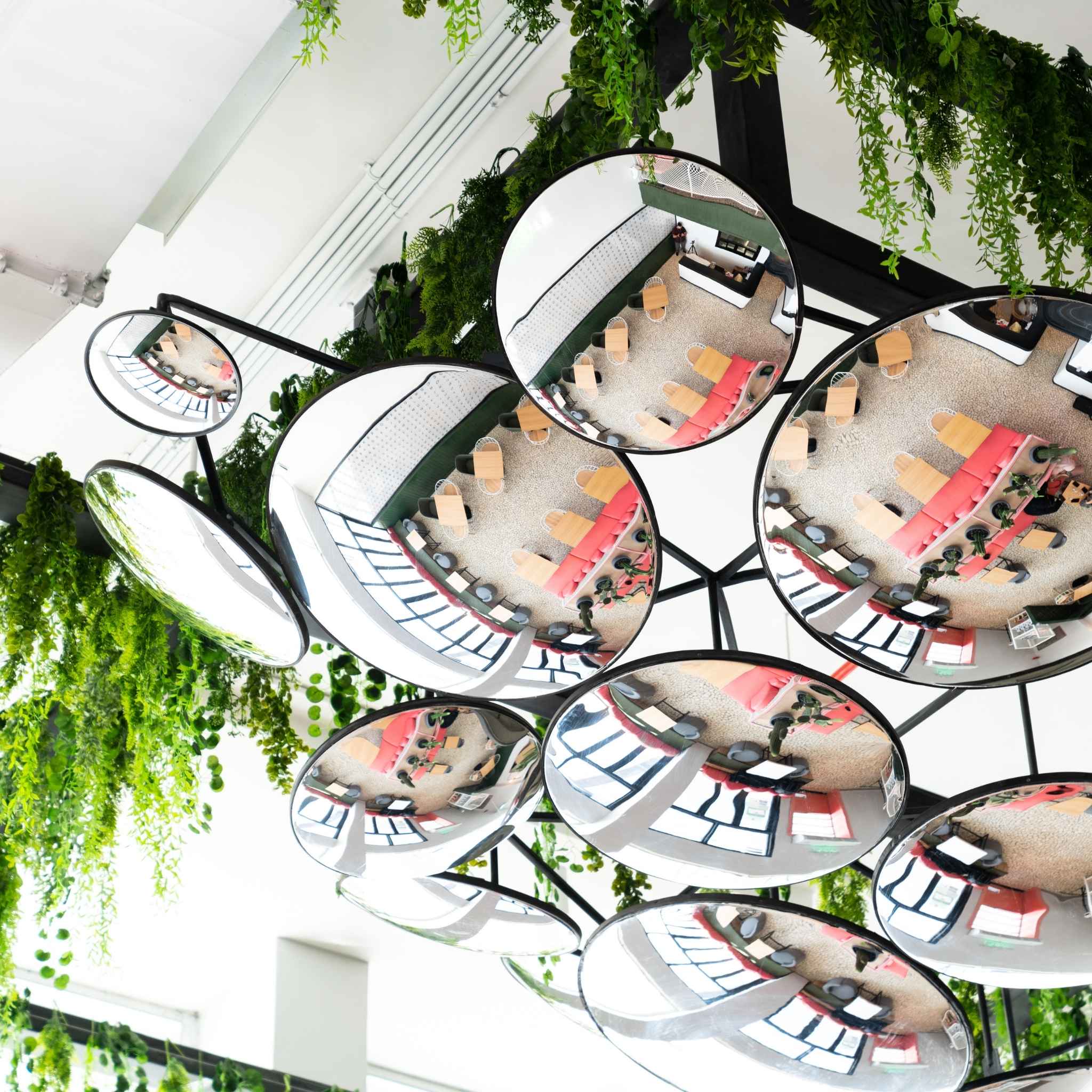
About the execution and ambience
4SPACE carefully selected expert artisans to fit out Kactus; they communicated frequently with their contractors to ensure a snag-free delivery.
The design is bright, fun, lively, quirky, inviting, comfy and minimalist.
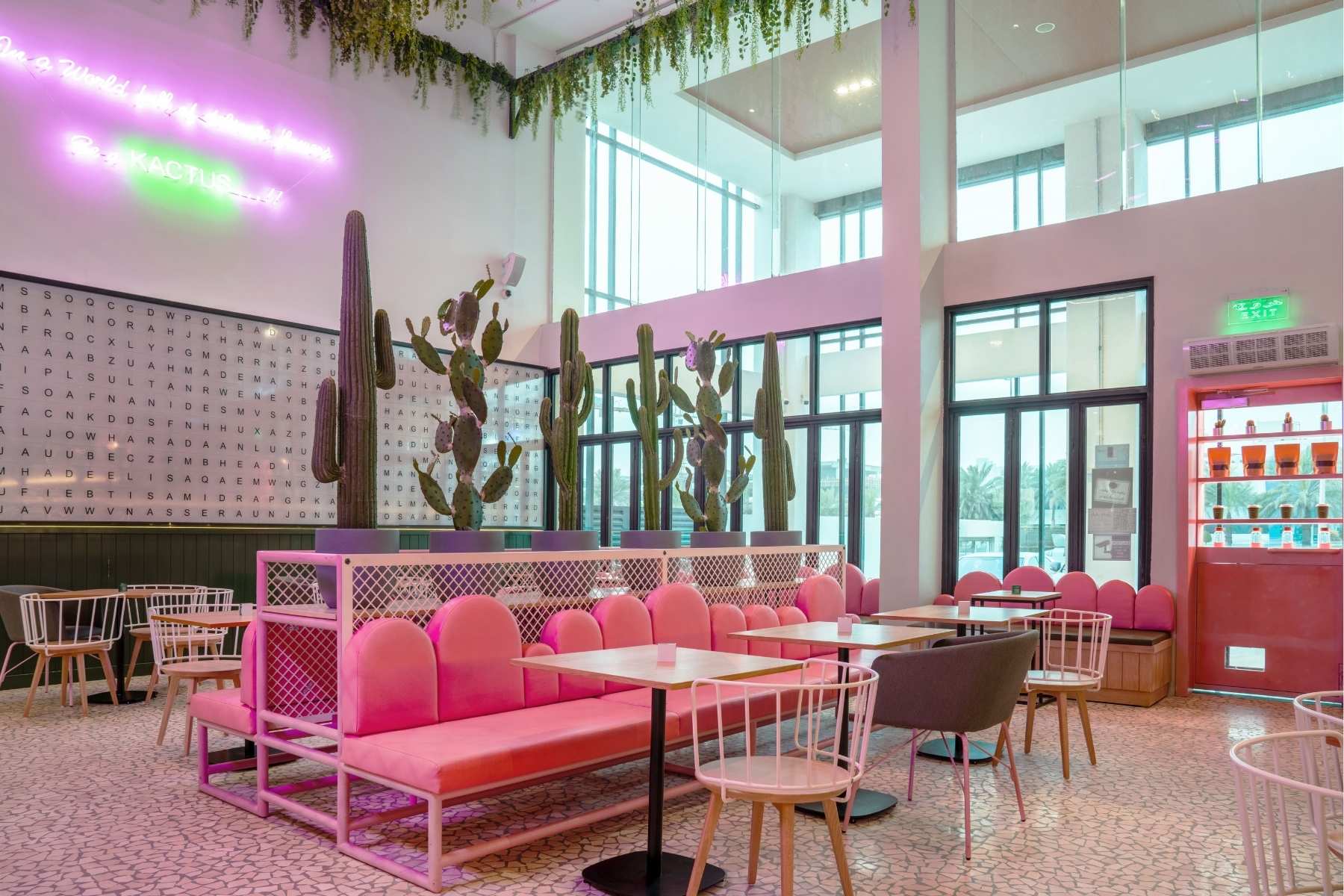
Challenges overcome
The pandemic gave 4SPACE various challenges to overcome. Long-distance communication was necessary to manage contractors in Saudi Arabia. International product deliveries were also a challenge due to reduced shipping and logistics.
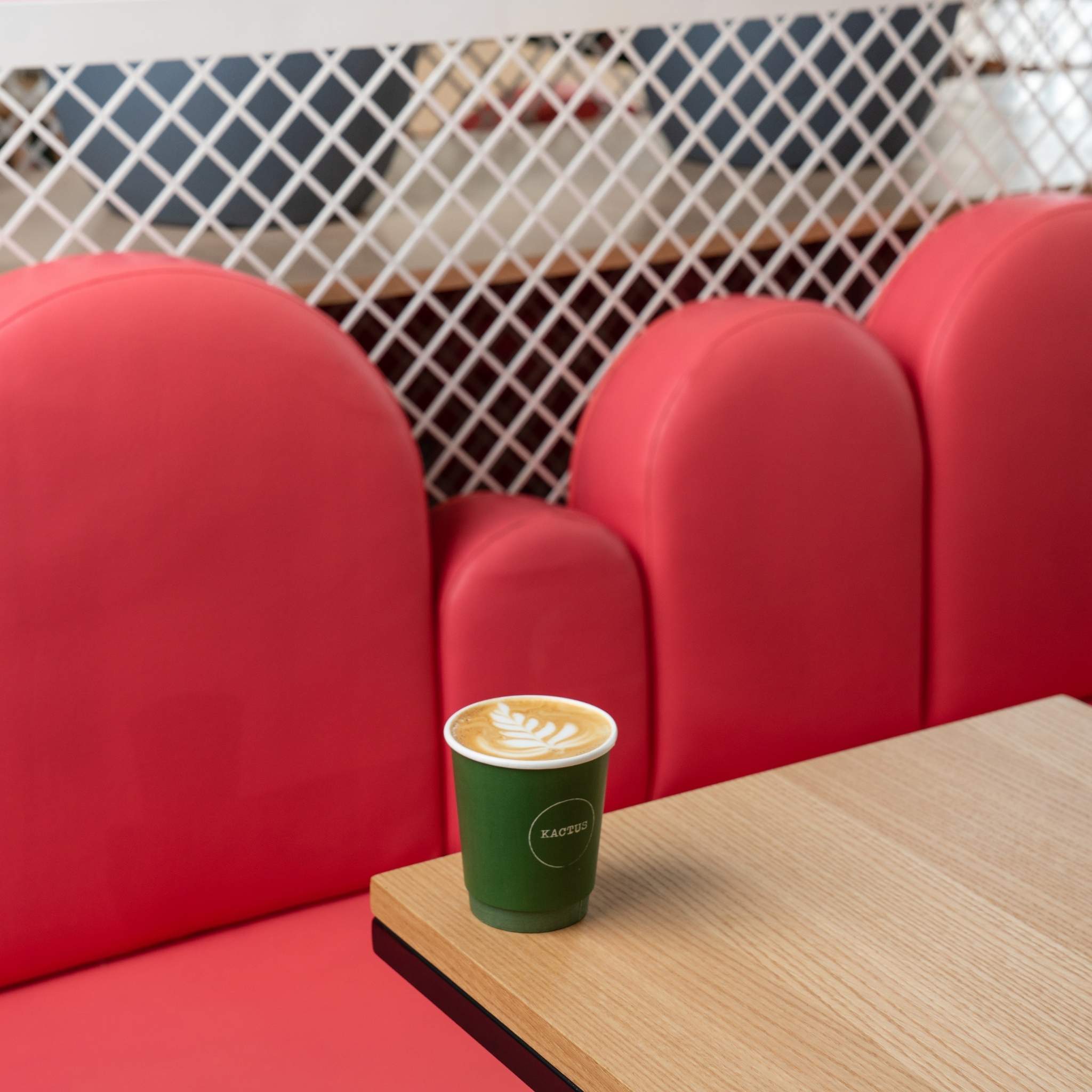
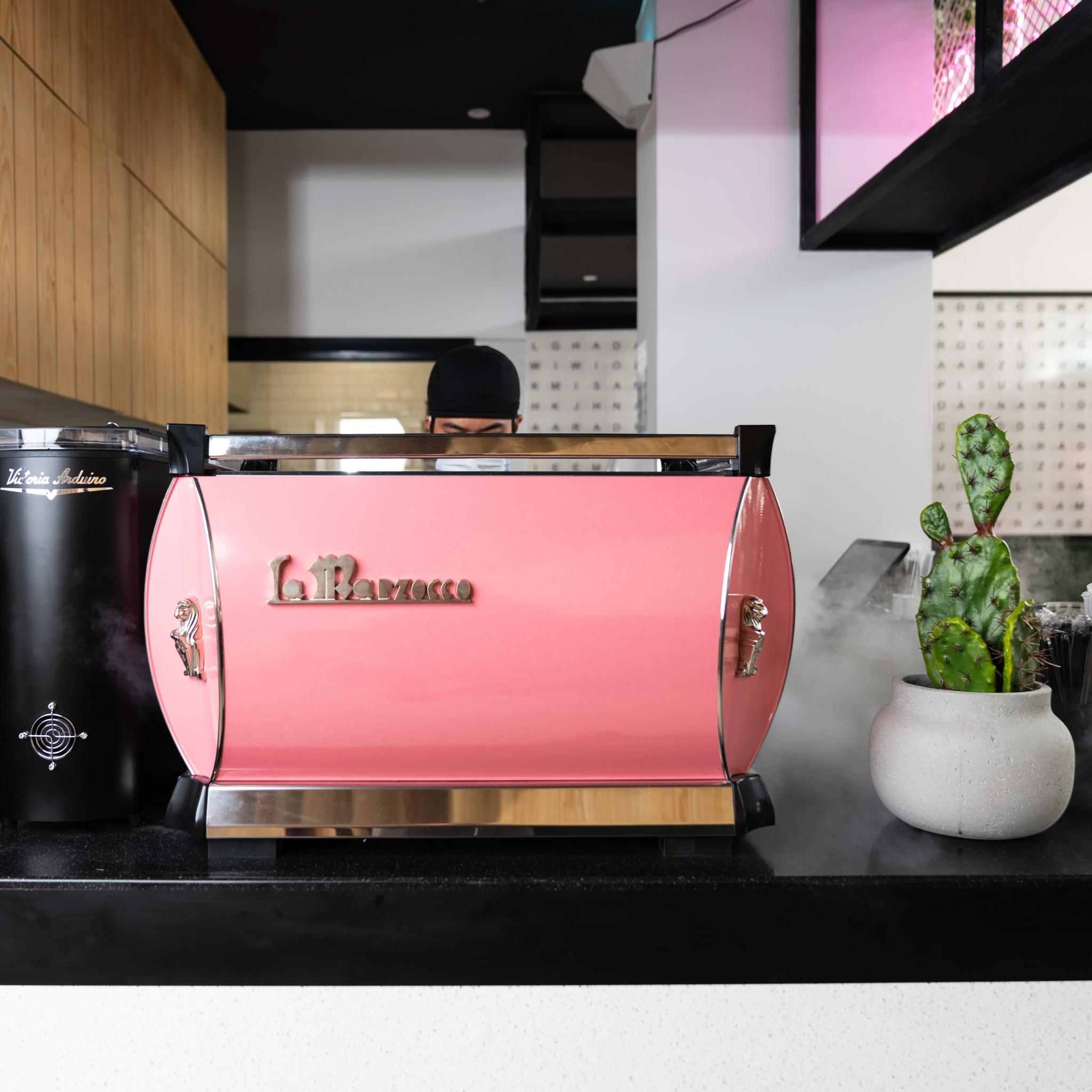
Unique features
Various fun features throughout Kactus encourage interaction and provide clever illusions and photographic opportunities for social media platforms. The mirror-clad ceilings create playful reflections whilst the crossword wall allows patrons to find their names in the pools of letters on the walls. Neon cacti lights adorn the walls of the café. The café entrance is designed as a pink vending machine door that provides an element of excitement and joy upon arrival.
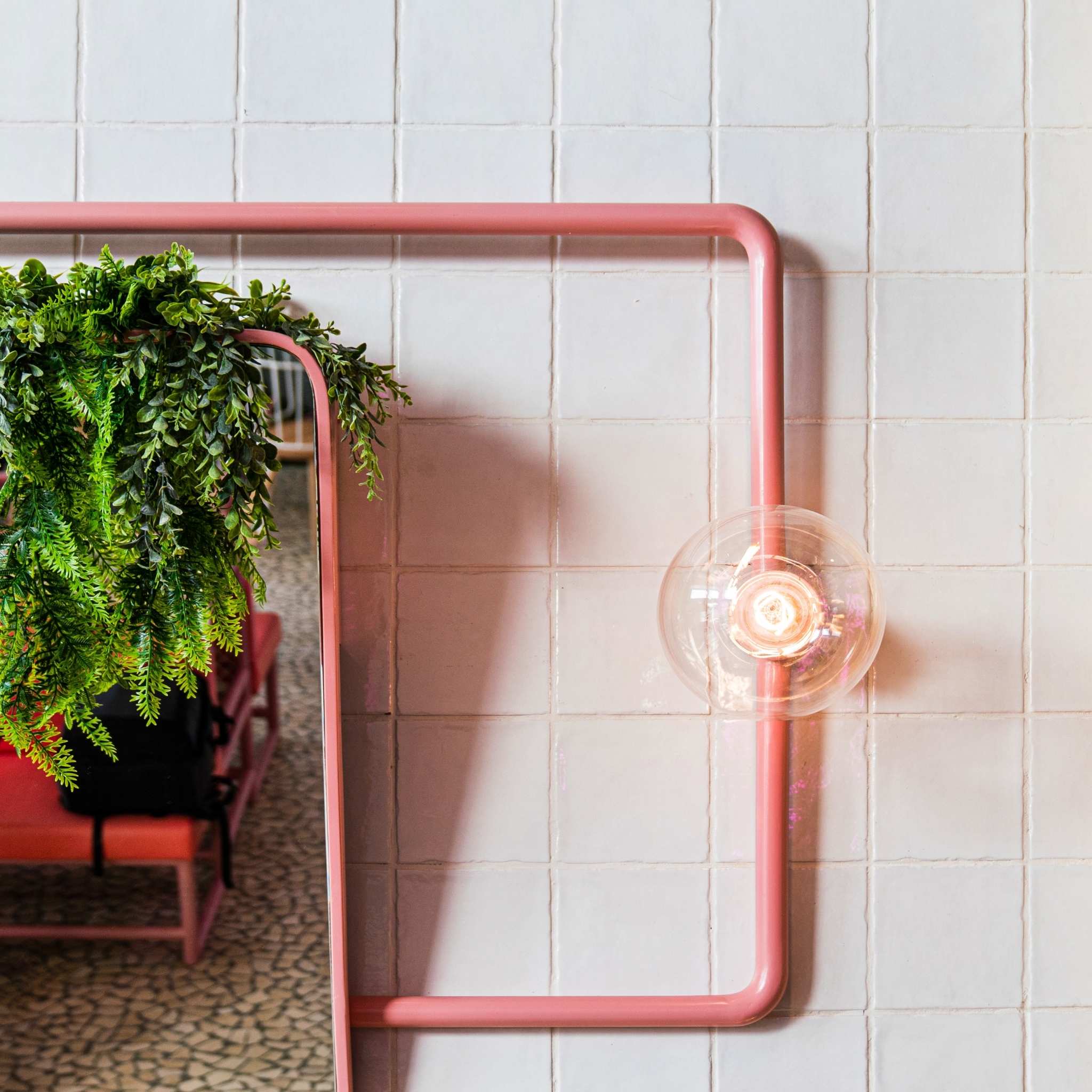
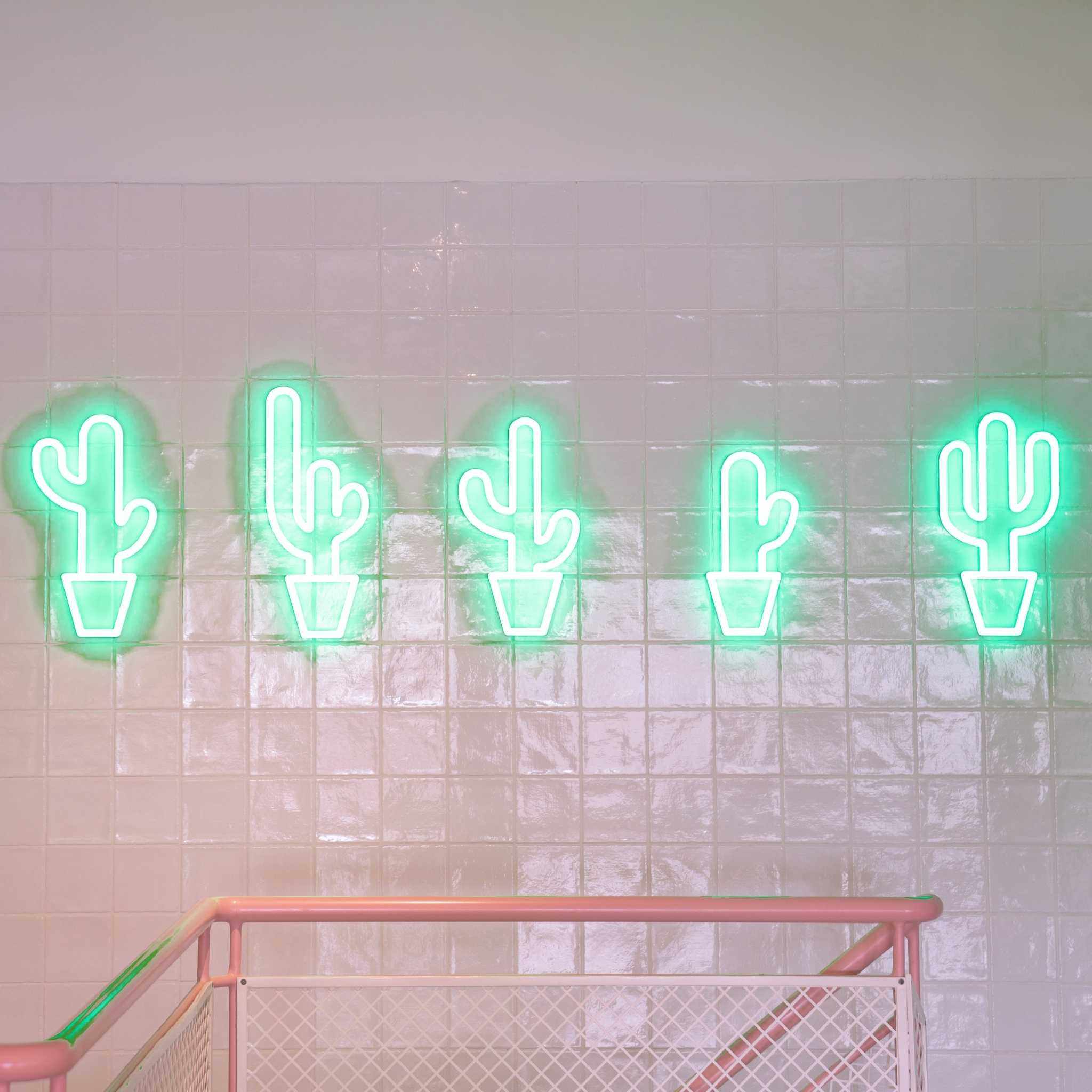
Material selection
4SPACE has chosen multi-texture materials and used polished oakwood, steel, leather, and terrazzo throughout. The colours chosen are calm vintage hues of pink and green. Various complementary-coloured neon signs adorn the walls, and verdant plans hang fluidly from the beamed ceilings.
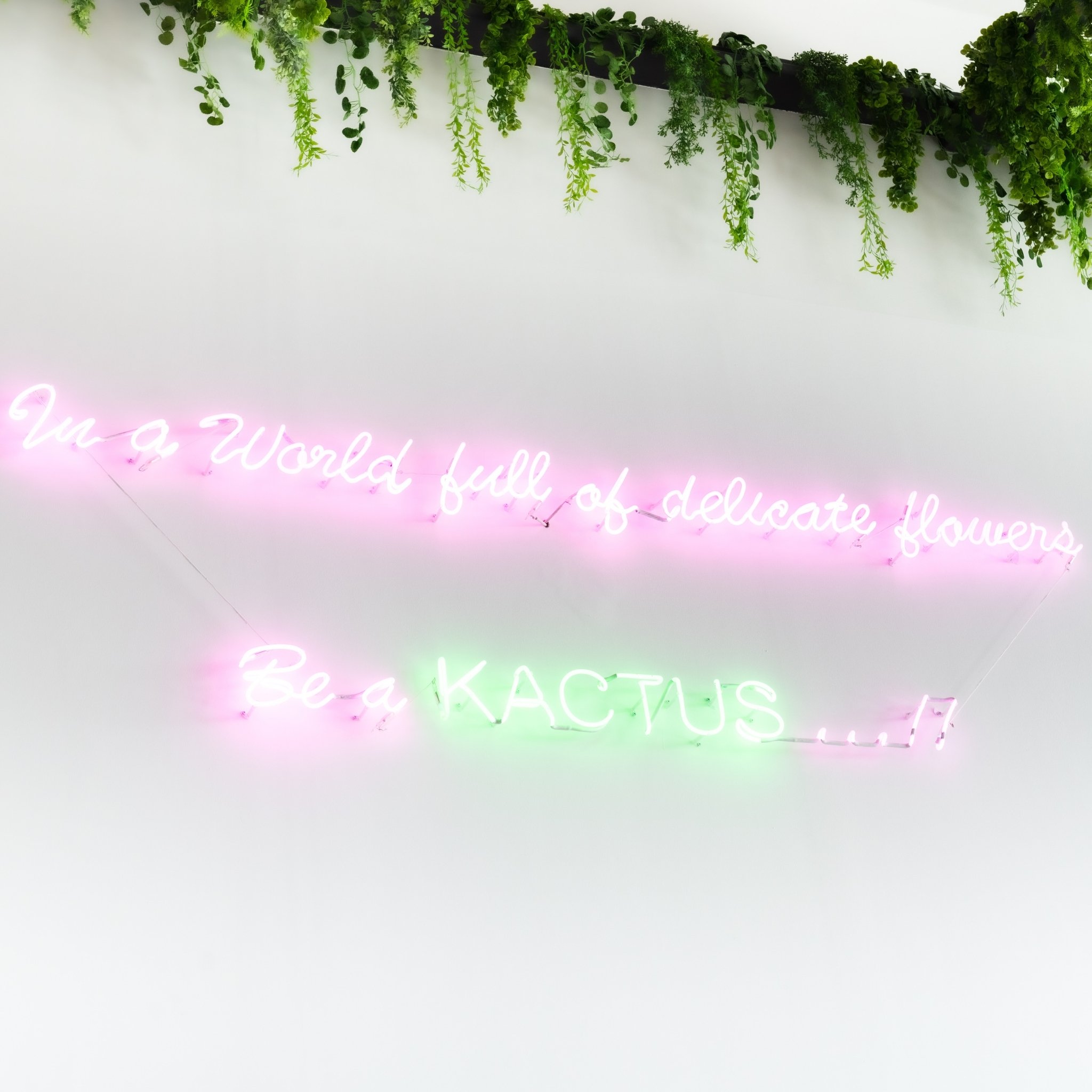
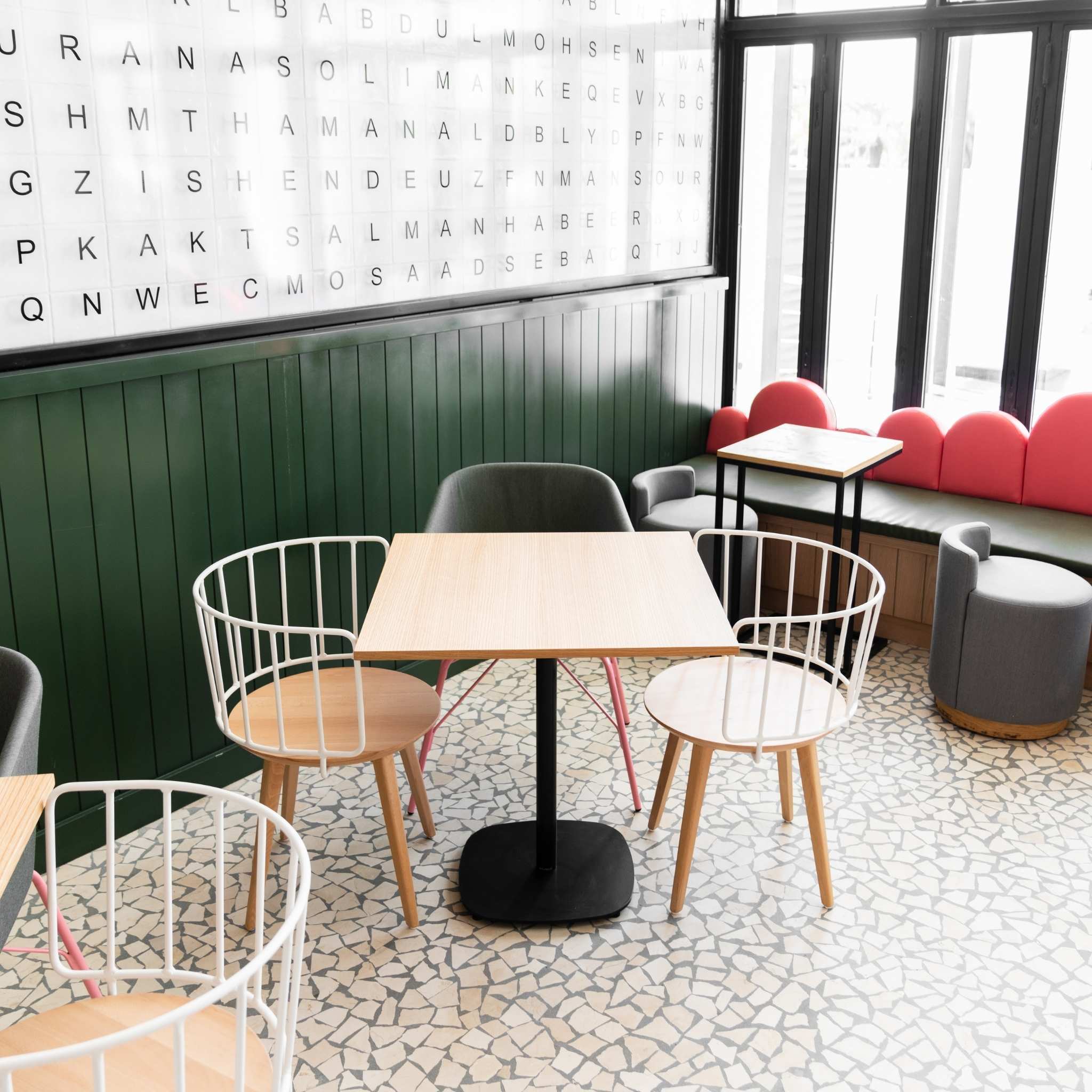
Furniture chosen
Furniture is minimalistic, and much has been taken from the 'interiors 360' collection. Two hand-crafted banquette seating arrangements are shaped like oversized bunny-ears cacti in pink leather.
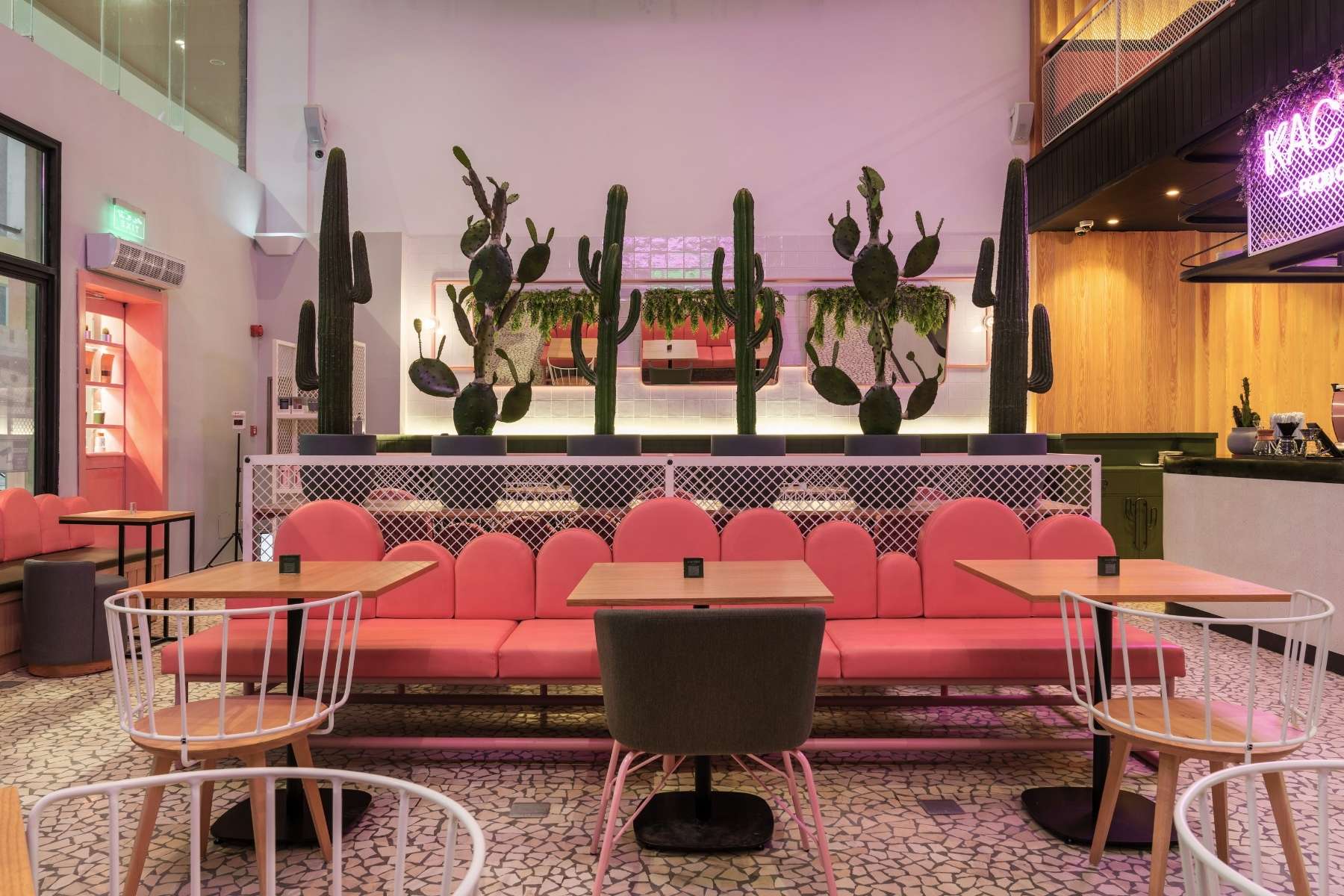
The standout of this project and why
Kactus provides an inclusive and fun setting for people from diverse, multicultural backgrounds. The contemporary and ultra-modern design encourages interaction between people and on social media. The eye-catching façade and retro branding which was designed by the 4SPACE branding team is a significant statement on a busy sand-coloured Riyadh street.
About 4SPACE Design
Originally established in Damascus in 2001, founders, Firas Alsahin and Amjad Hourieh, moved their practice to Dubai to be at the centre of this vibrant market. The emirate’s booming growth in the commercial sector was an impetus for the firm to explore all the opportunities in the design industry. Overcoming an uphill battle, 4Space Design has gone on to create noteworthy projects in the UAE. Eschewing quantity for quality, profile of the project and relationship with clients, the studio credit its people’s distinct ideas strategic business development.
If you’d like to feature your product news here, get in touch to find out more.
If you’d like to become SBID Accredited, click here for more information.
This week’s instalment of Project of the Week series features a stunning and unique restaurant design by 2021 SBID Awards Finalist, Bishop Design by Paul Bishop.
SBID Awards Category: Restaurant Design
Practice: Bishop Design by Paul Bishop
Project: Carna
Location: Dubai, United Arab Emirates
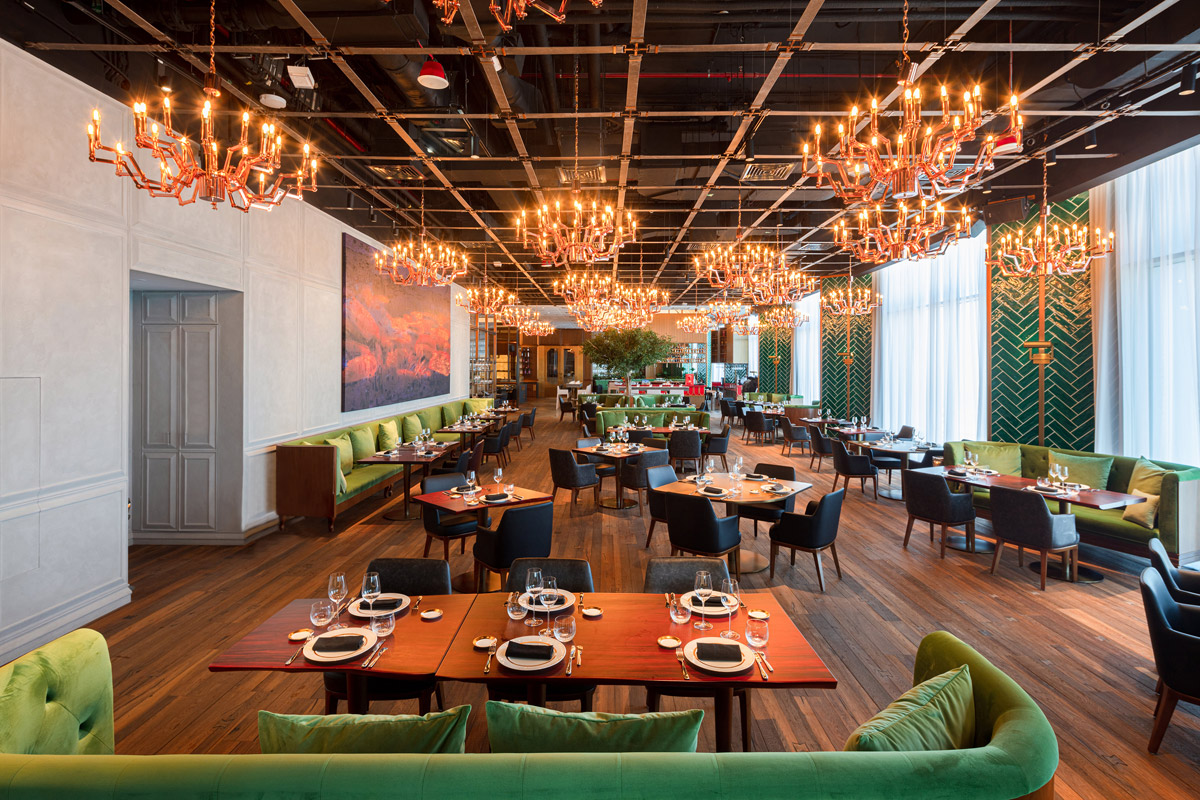
What was the client's brief?
The brief for Carna was simple, yet the end result is breath taking. Discovered on the 74th floor SLS Hotel & Residences, Carna was to be a contemporary steakhouse and immersive meat experience.
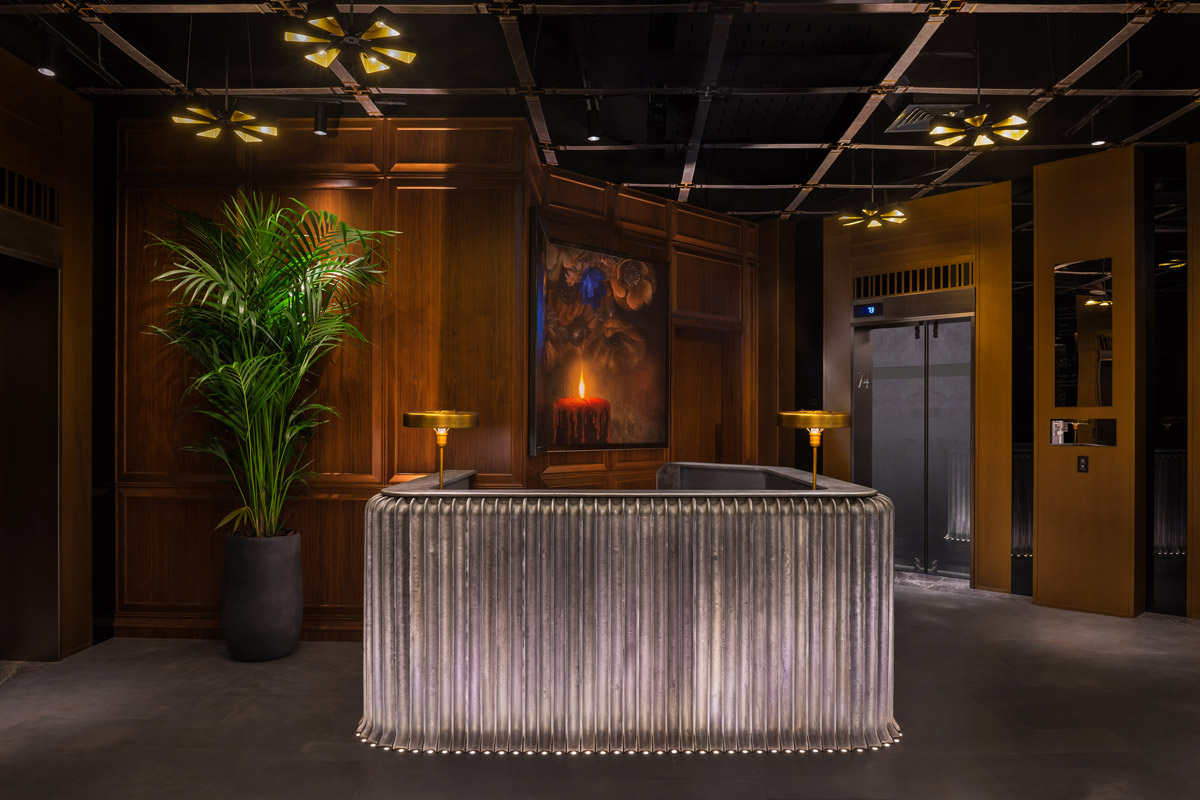
What inspired the design of the project?
Meat is art, from preparation through to first taste, and it’s this story we aimed to capture through the interior. We appreciate the butcher to be a respectable symbol of society; a community monarch. They satisfy the most famished, and bring their unique skills to the table to fulfil the deepest of cravings. Their ancient trait is passed down through generations, and it’s this authentic craftsmanship that seethes through every crevice.
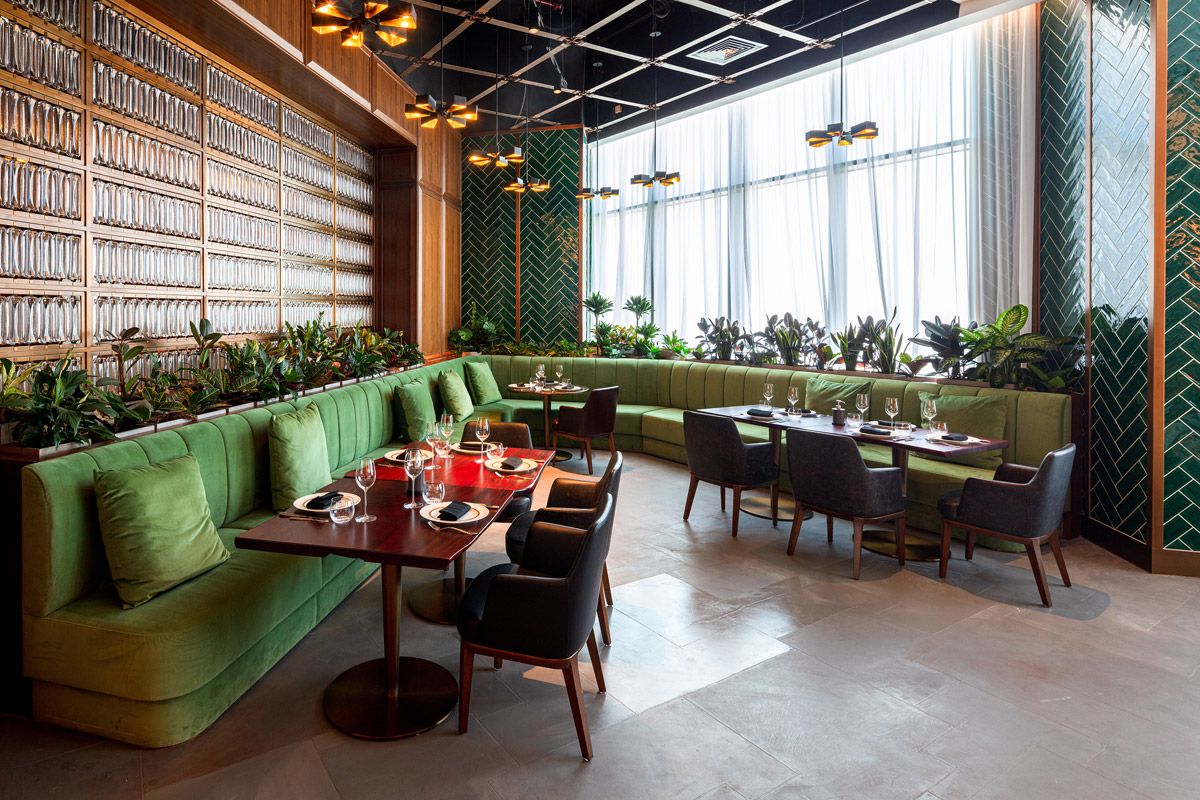
What was the toughest hurdle your team overcame during the project?
The sheer volume of space is jaw-dropping, and posed challenges at the onset, yet no corner has been left untouched. It’s strong, sensual and tantalizing of all the senses.
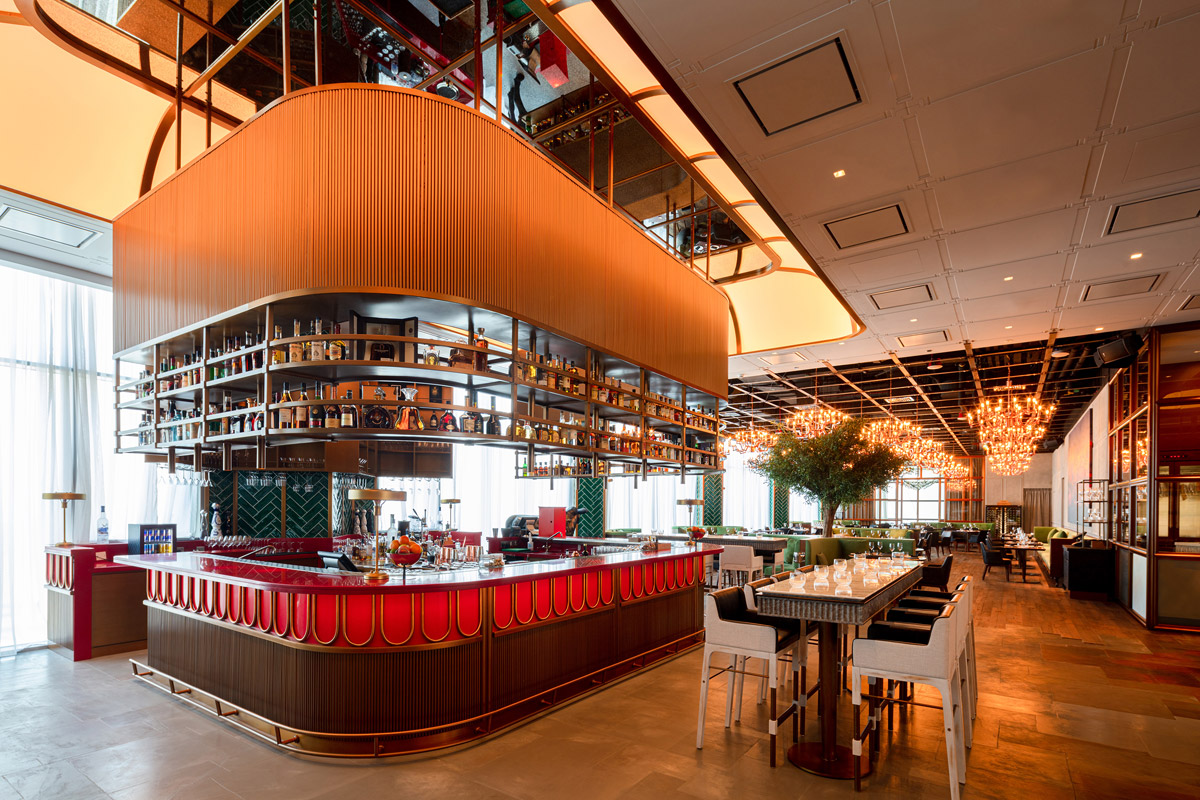
What was your team’s highlight of the project?
On the left resides a theatrical bar where seductive red provides a colour bomb to an architectural wardrobe otherwise dressed in shades of green and brown. Hand cut green tiles provide the backdrop to a magnificent showcase of rustic brass finishes which elegantly display the bar's liquor sensations.
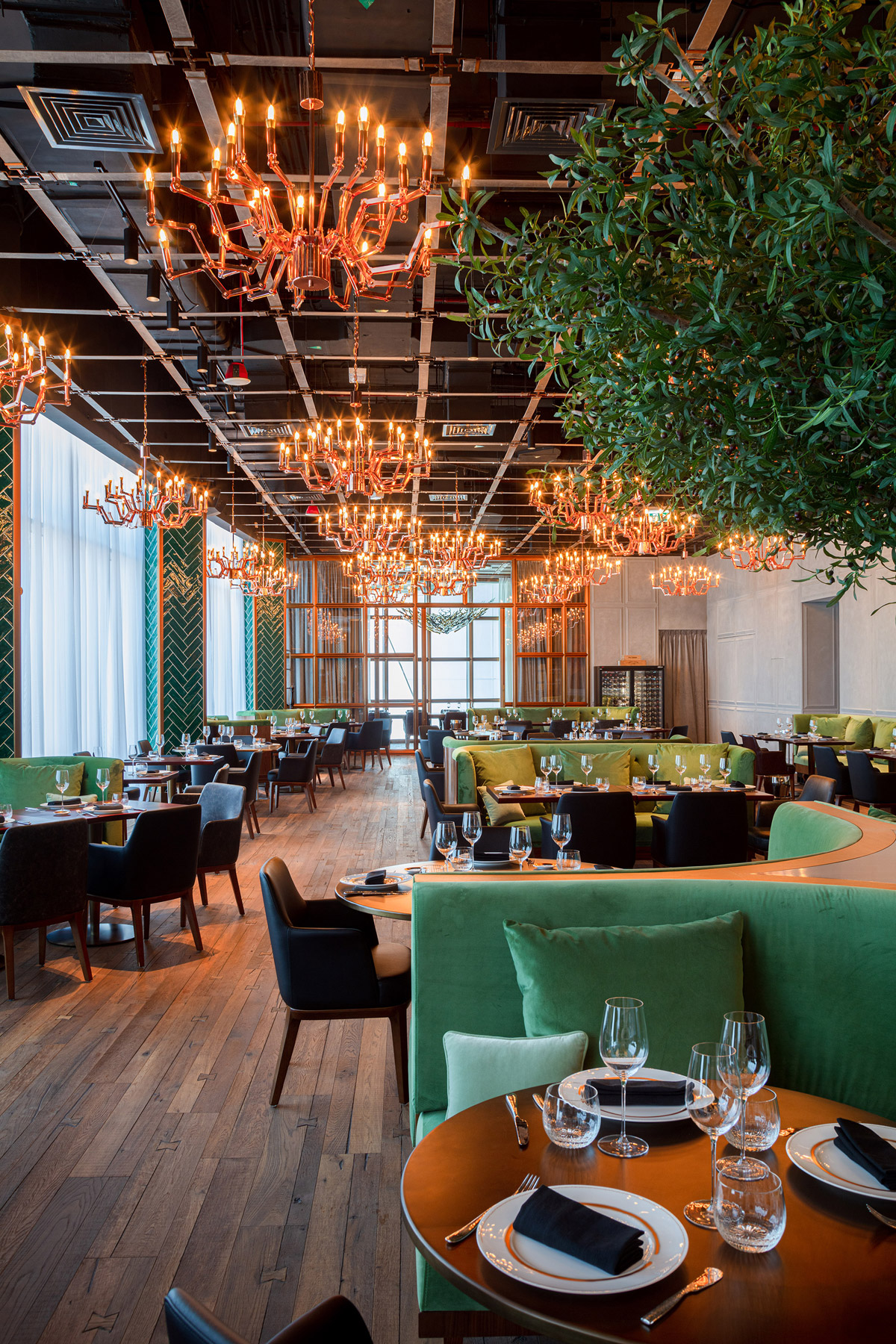
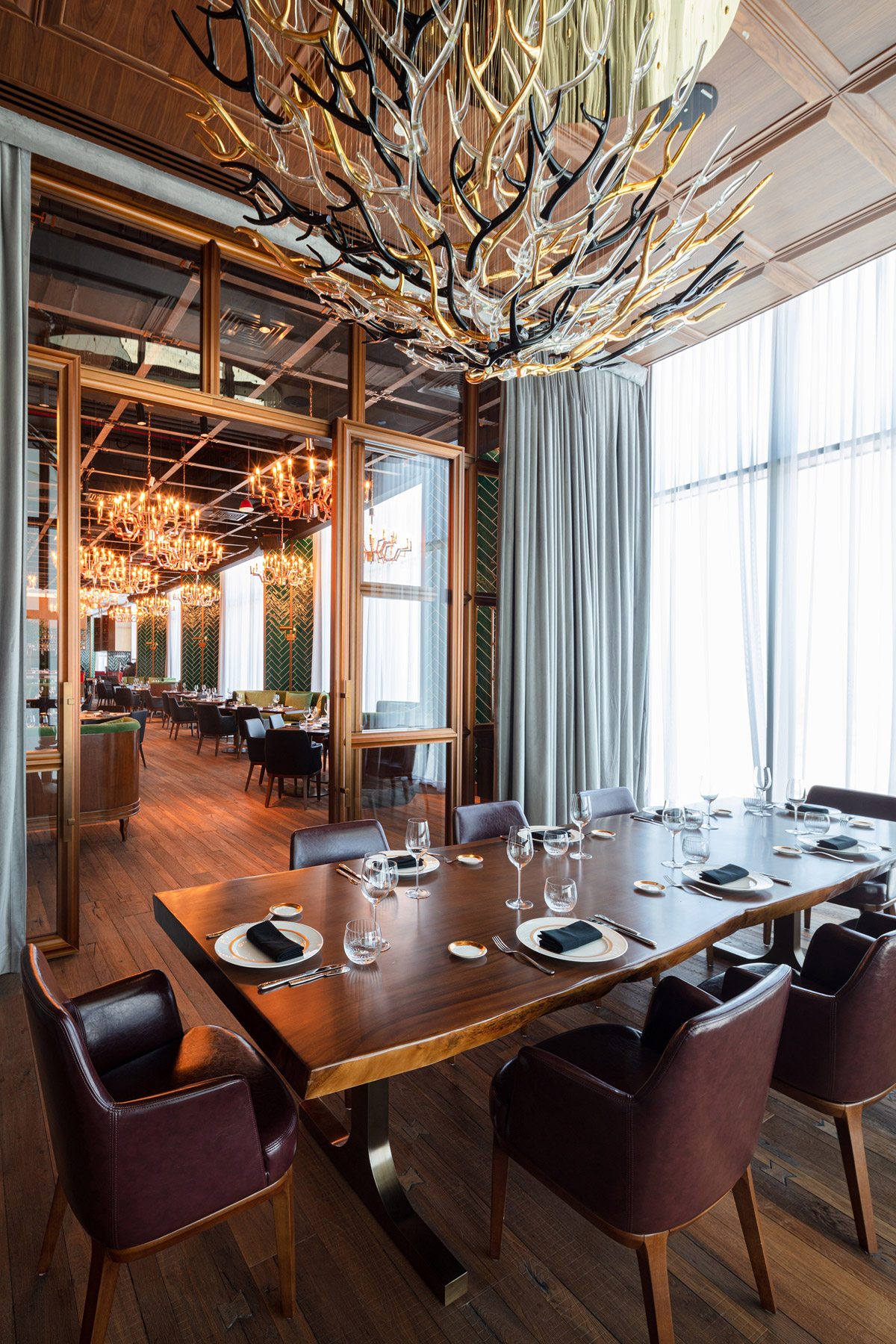
Why did you enter this project into the SBID Awards?
The SBID Awards celebrate the best in design and it is events like this that continuously motivate our team to create iconic experiences all over the world.
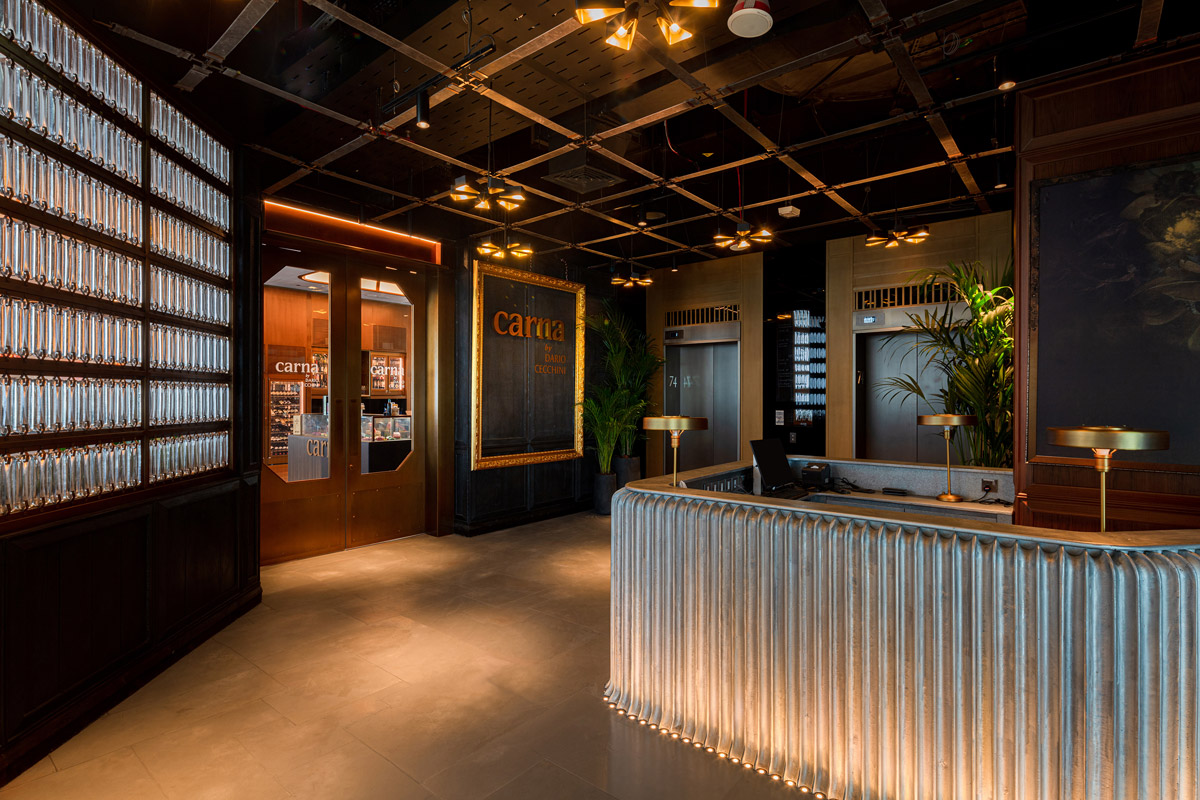
Questions answered by Paul Bishop, Owner and Founder, Bishop Design by Paul Bishop.
In this week's interview with 2021 SBID Awards winners of the Restaurant Design category, design command share their tips on designing hospitality interiors with user experience in mind and talk about using natural materials in interior design projects.
SBID Awards Category: Restaurant Design
Practice: design command
Entry: Mickeys Beach Bar and Restaurant
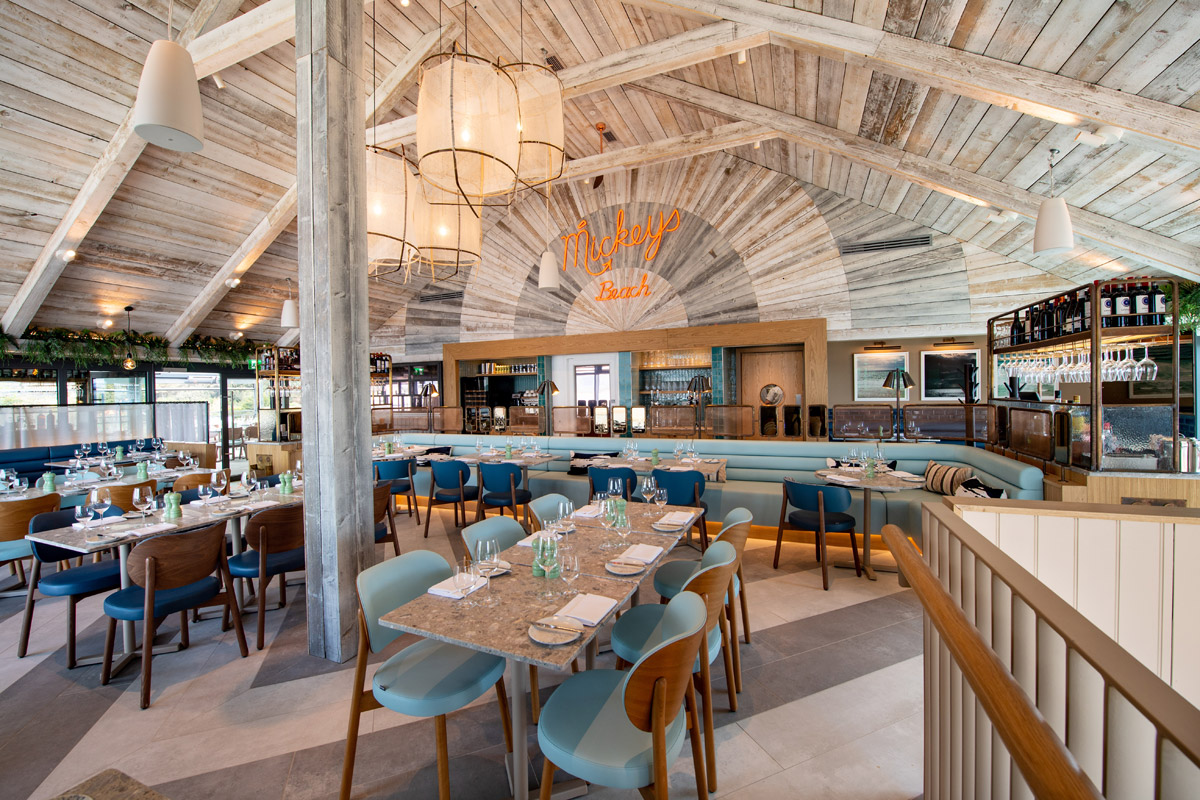
How important is it to enter the SBID Awards & receive industry recognition for your work? What are the benefits?
Extremely important for us as an Interior Design Company that mainly specialise in hospitality design. To receive the recognition after the difficult years or 2020 and 2021 is an amazing achievement. Being recognised by SBID Awards introduces you to new contacts and you feel like part of a hospitality family.
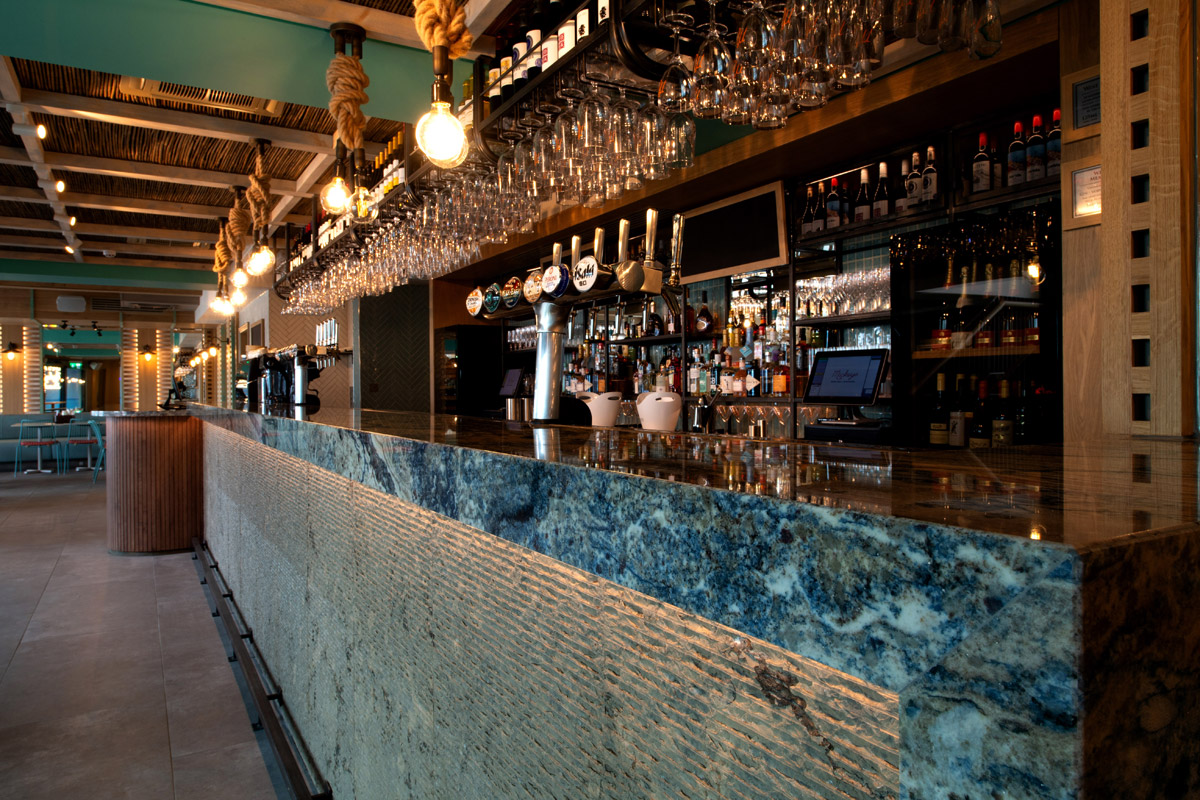
What do you think made this particular design an award winner?
We didn’t follow current trends and mainly focused on reflecting the amazing views and this was the inspiration for all ff&e selections and the colour palette. We think this made this restaurant's interior design unique.
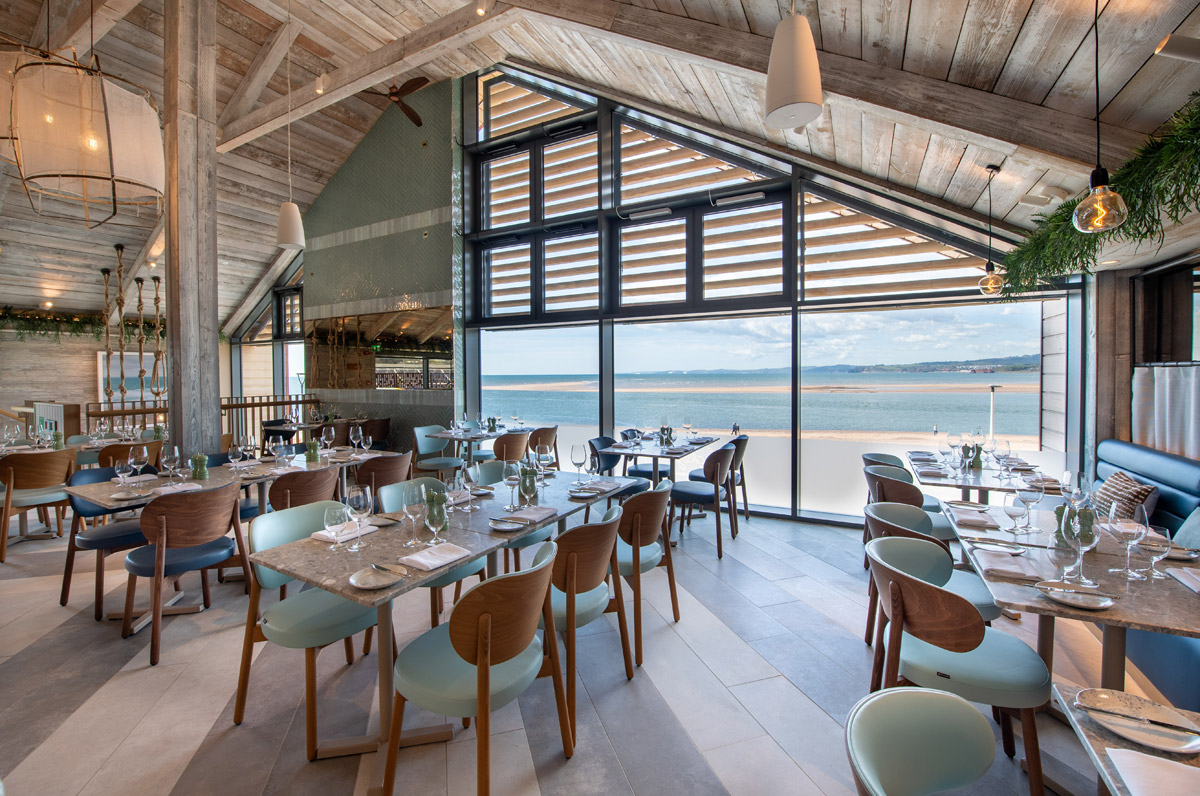
When working on a hospitality project, how do you incorporate the end user’s experience into the overall vision and functionality of the interior?
The Interior has to be both captivating and a comfortable place to dine. Equally important is how it works operationally for staff as they use the space on a daily basis and we want to have an interior that they are proud to showcase.
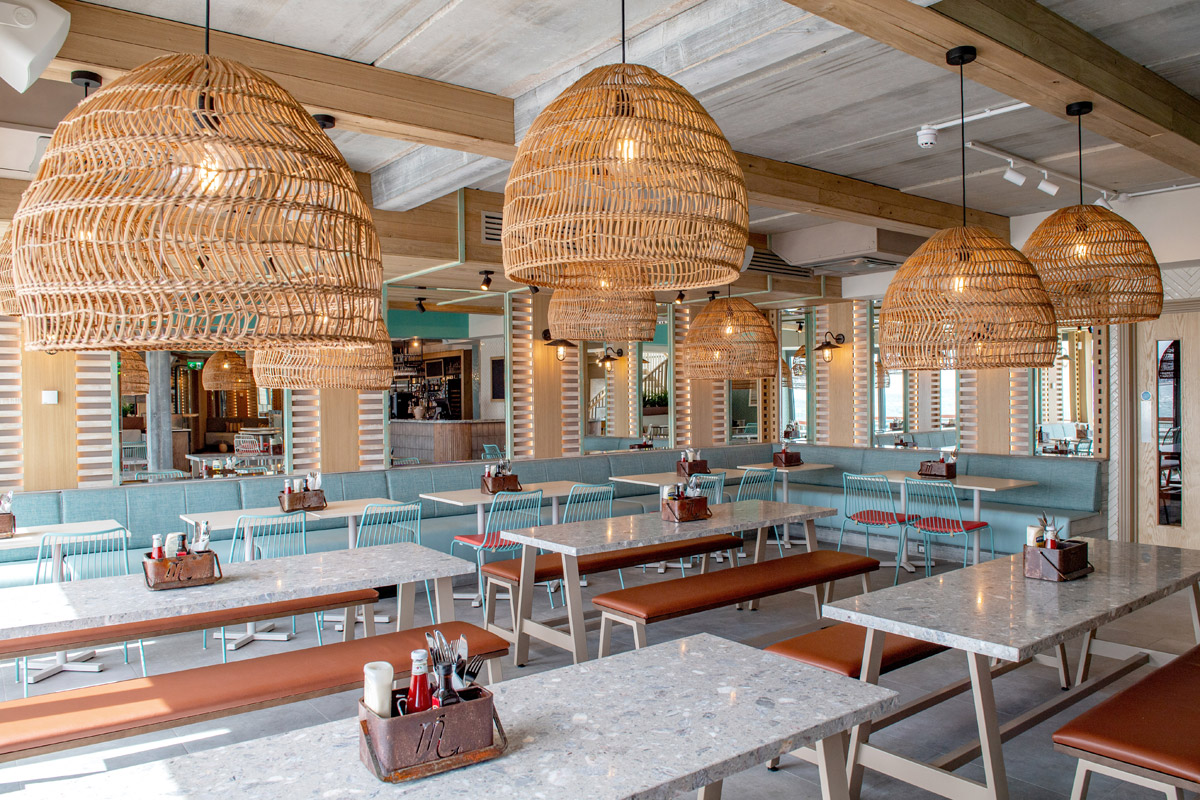
Do you often work with natural or unconventional materials, such as stone, rope, reclaimed timber? What made you choose these materials, and are there any particular considerations when working with them?
We like to work with natural materials on most of our projects as we find they add more contrast and interest overall, whilst also being environmentally friendly.
We wanted to reflect the coast and surroundings as much as possible and chose a range natural materials to express this throughout. When choosing these materials it is important that you apply them to the correct areas within the space.
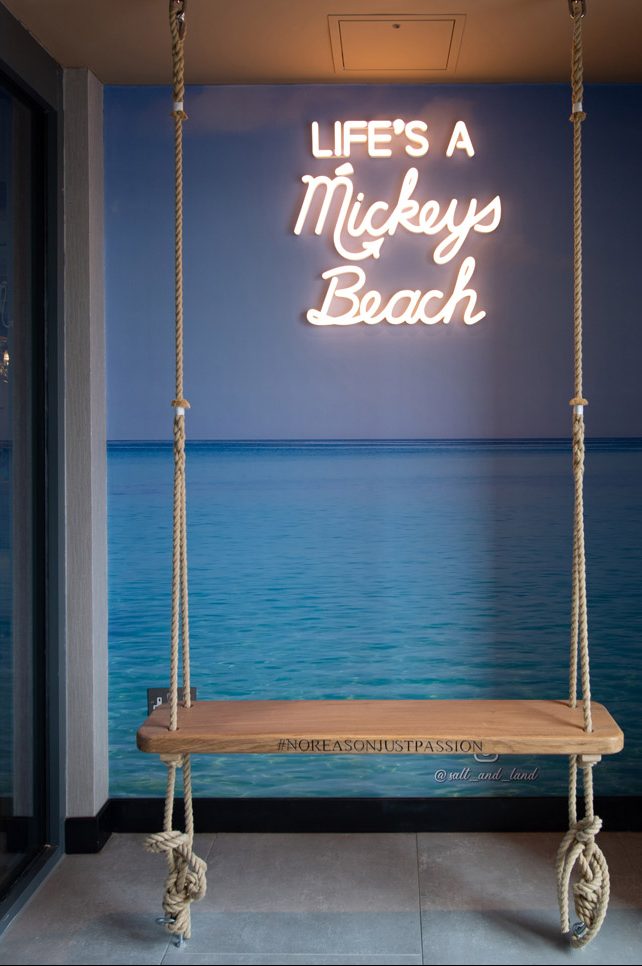
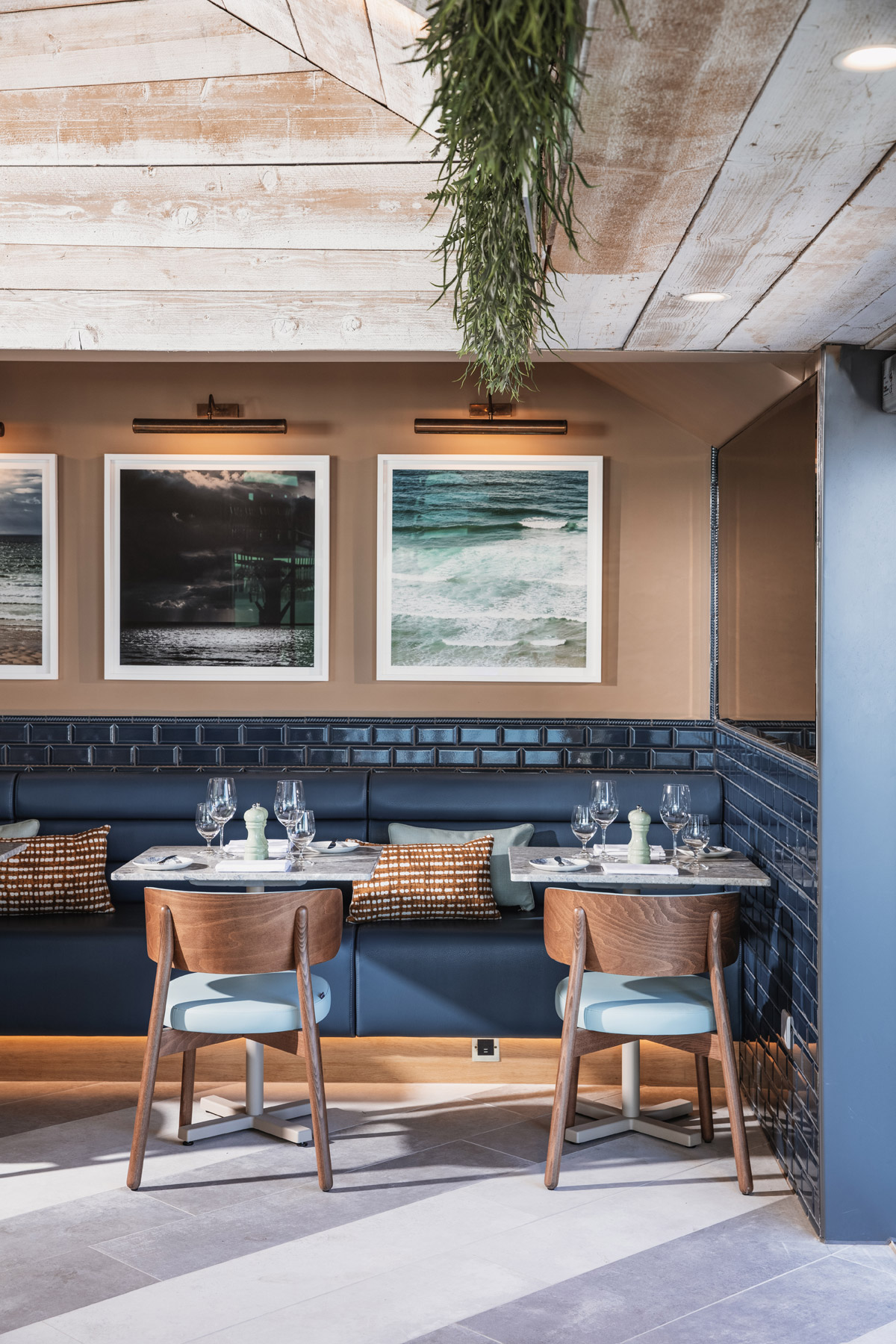
Now that you’ve won an SBID Award, what are the next steps? Is there anything new you are excited to be working on?
It was a big surprise and we are still taking it all in and looking forward to new opportunities in hospitality design for 2022. We are looking forward to working on new restaurant and hotel designs. I began my career in hotel design and am excited to bring that passion full circle.
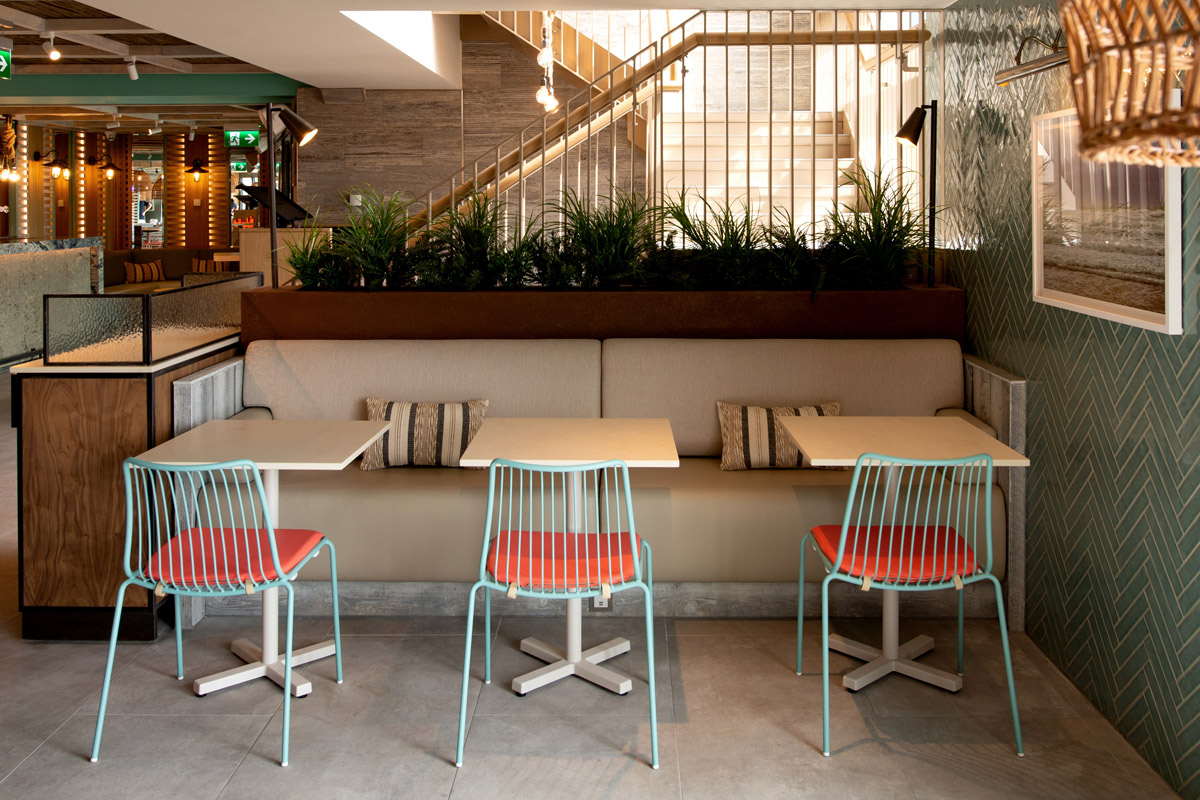
What advice can you give to young designers starting out in the design industry?
Always believe in yourself and no matter how much experience you have never dismiss an idea - it could be the best one for that particular project.
Questions answered by Clare McDonald, Founder & Creative Director, design command.
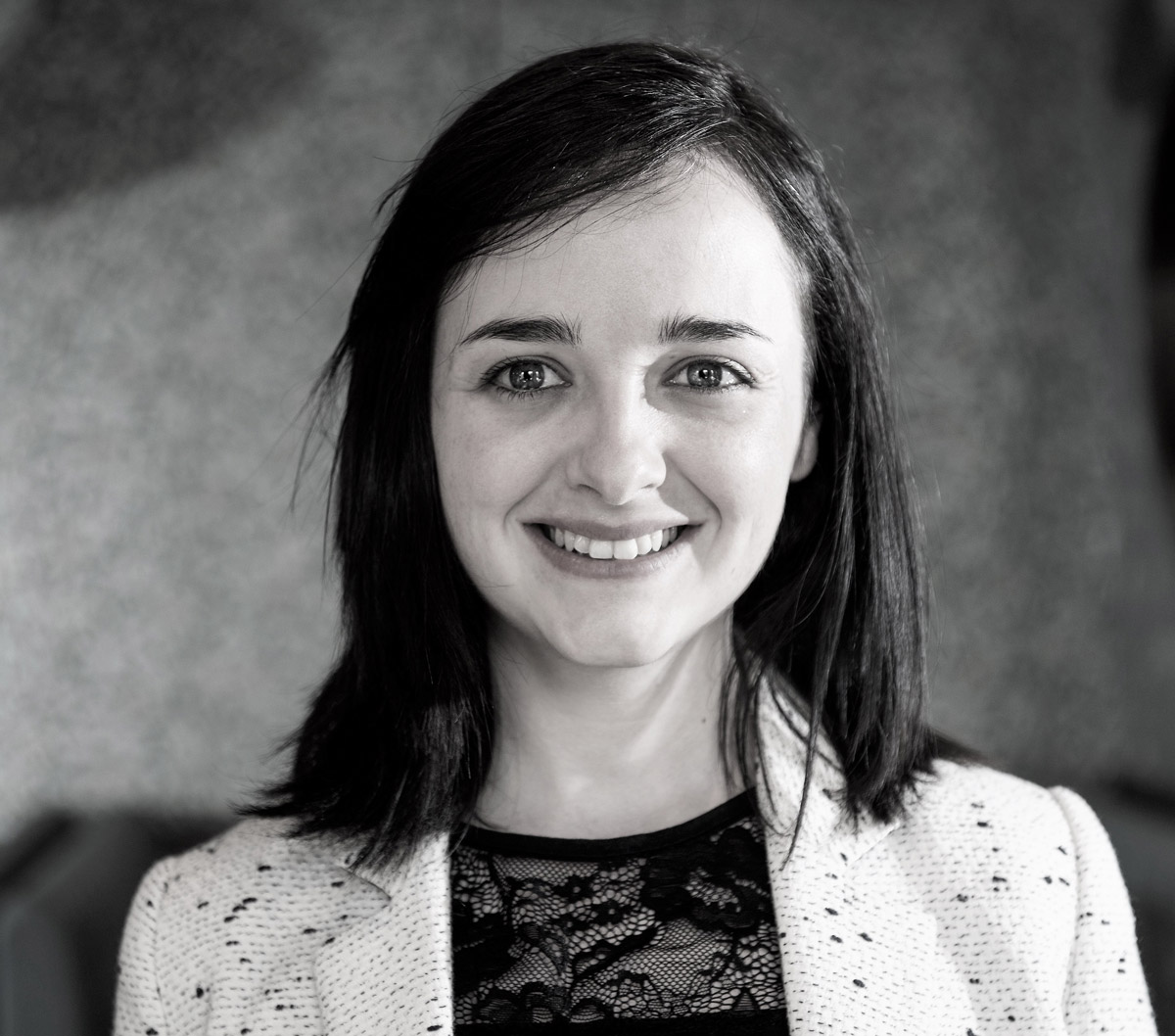
Design Command is a multi-award winning London & Hertfordshire based Interior Architecture Studio founded in 2013 by Clare McDonald. Clare brought over 13 years expertise in hotel and restaurant interiors to projects across Europe; designing 5 star hotels and over 50 restaurants, as well as student hotels, high-end residential schemes and boutique offices. Design Command has quickly grown to several designers working on hospitality projects throughout the UK and abroad - offering the experience and flair to realise your design ambitions.
This week’s instalment of Project of the Week series features a CGI design of a transformable restaurant-bar venue by 2021 SBID Awards Finalist, 4SPACE Design.
PAPA Dubai is an exciting 1,580 square meters dining and entertainment destination in the vibrant Atrium complex, the epicenter of riverside Al Habtoor City. PAPA Dubai will take its visitors on an extraordinary culinary and mixology journey through nine glorious bars, each themed with a unique concept. Comfort and soul food are at the very heart of the dining experience. The fascinating bars have been developed in collaboration with Moscow and Dubai's top bartending figures.
The venue transforms from a sophisticated and immersive dining experience to a chic nightlife venue with DJs and entertainment as evening moves to night. From a quiet dinner with friends to one of the city’s best vibes - feel the energy of this unrivalled sensory-driven experience. PAPA Dubai will host some of the world's most courageous bartenders vying to show off their avant-garde skills throughout the year.
PAPA Dubai is made up of little ‘boulevards’ including the Rum Station, Champagne Avenue, Gin Point, Vodka Lane, Tequila Road, Mezcal Street, Sake Alley, Wine Square, Whiskey Square, and a VIP Lounge called High gate. Each of the nine distinctive bars has been carefully considered and designed by inimitable 4SPACE in a collaboration with Papa's founder Natalia Freys.
SBID Awards Category: CGI & Visualisation
Practice: 4SPACE Design
Project: PAPA Bar
Location: Dubai, United Arab Emirates
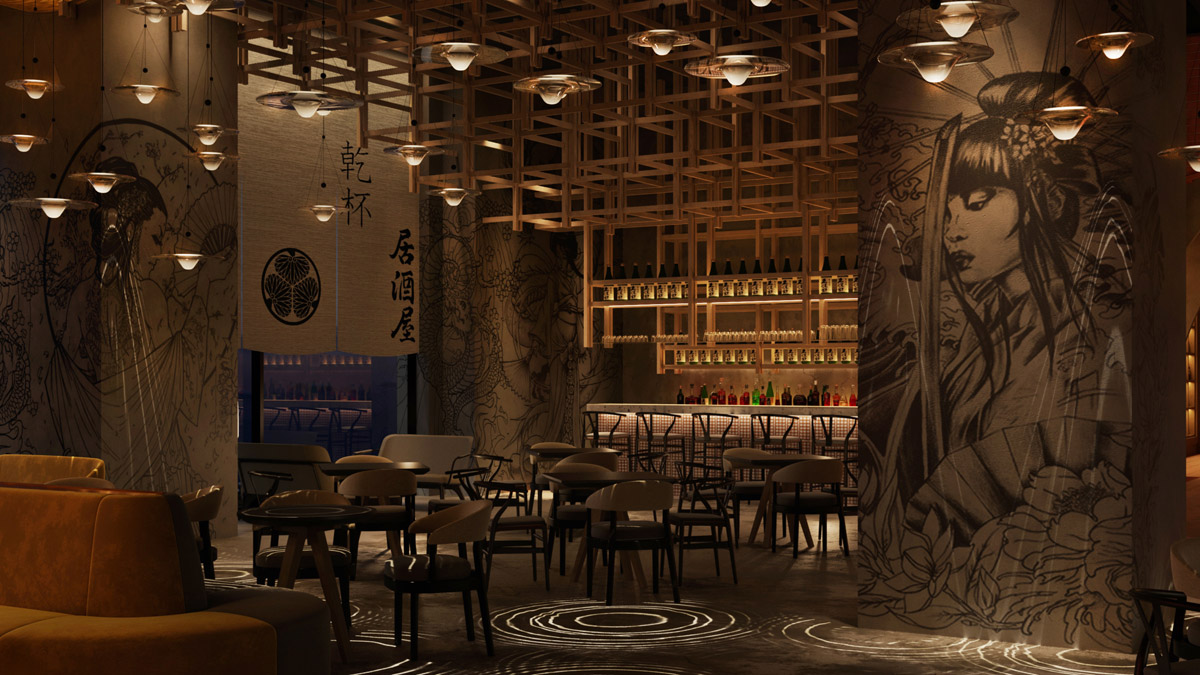
What was the client's brief?
To design a dining and entertainment destination as a Sensory experience, an urban playground of avant-garde cocktails, world-class cuisine, and irresistible beats.
- 9 bar concepts with avant-garde mixology under one roof and to host world’s top bartenders.
- Space with a mood that changes with its visitors, from a quiet spot with friends to a non-stop party venue offering hand-selected music by its internationally-renowned DJs.
- A venue which is able to evolve as the energy rises and the tempo picks up.
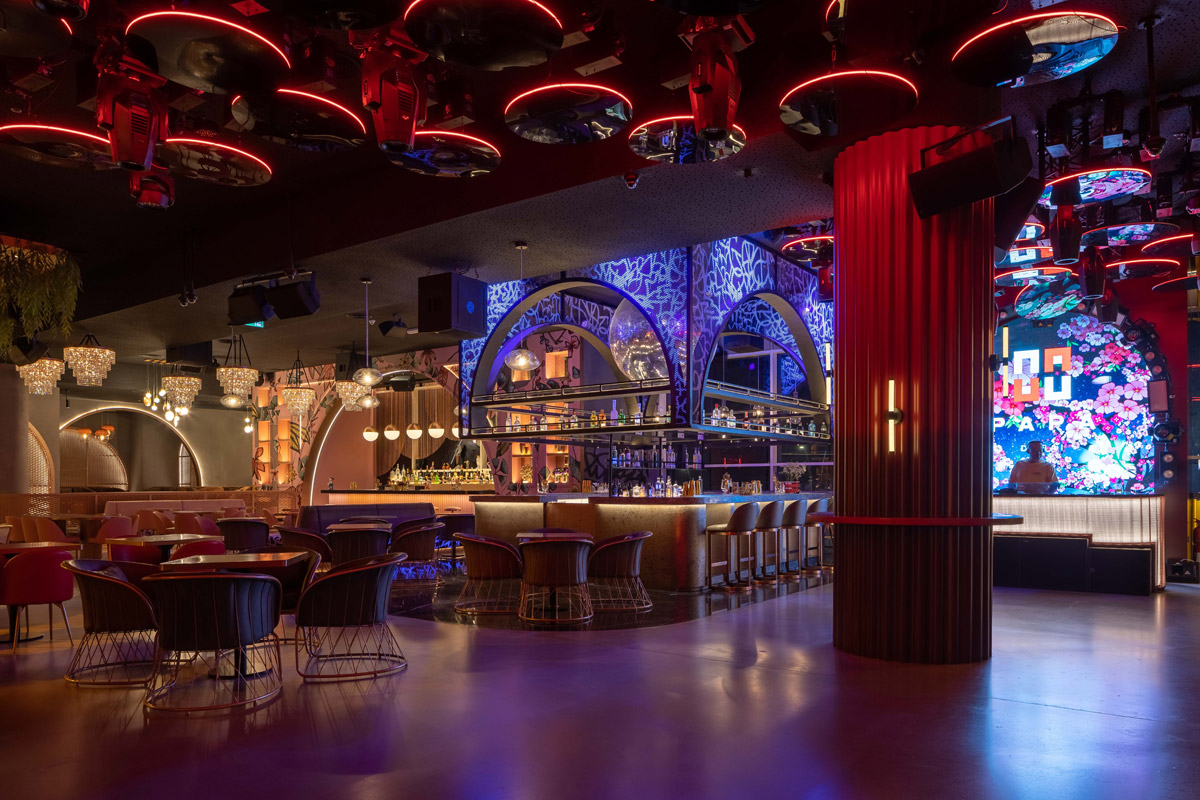
What inspired the design of the project?
The Arched boulevard. To create a cohesive Bar-village feel and to achieve one narrative that wraps around the venue, archways in different finishing are used throughout the expansive space. They create a unified design between each of the bars to form little ‘boulevards’.
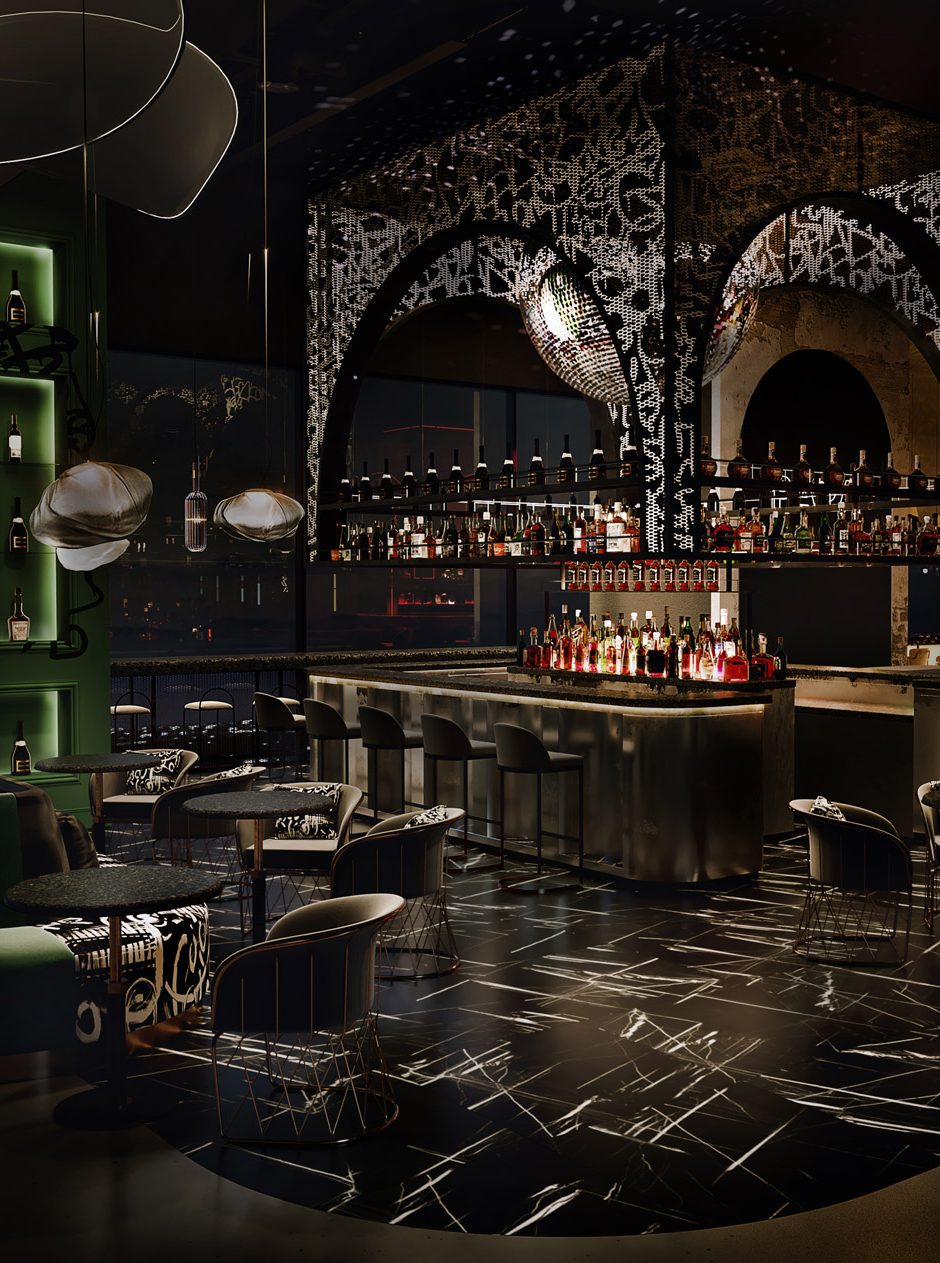
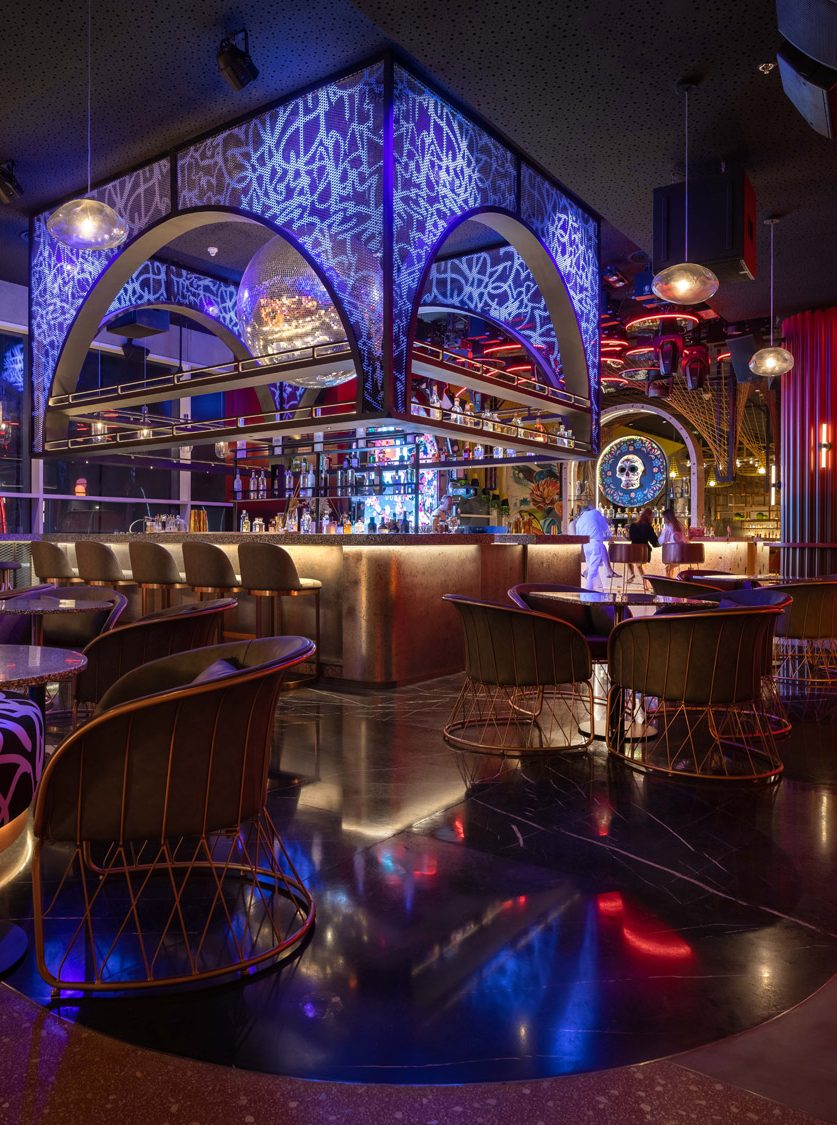
What was the toughest hurdle your team overcame during the project?
4SPACE allowed two months for the design and another five months for the fit-out and transformation. There were various challenges because of the sheer variety of materials required for each bar, the complex mechanical, electrical, and plumbing (MEP) requirements, and the acoustic challenges that take the bars from soulful eateries to exciting night venues.
Another challenge that 4SPACE had to overcome are the different terrazzo surfaces that were designed and installed throughout Papas. Cleverly, designers sourced authentic materials and graffiti artists to allow for fully cohesive individuality. The piece de resistance is the nine thoroughly different concepts within one narrative.
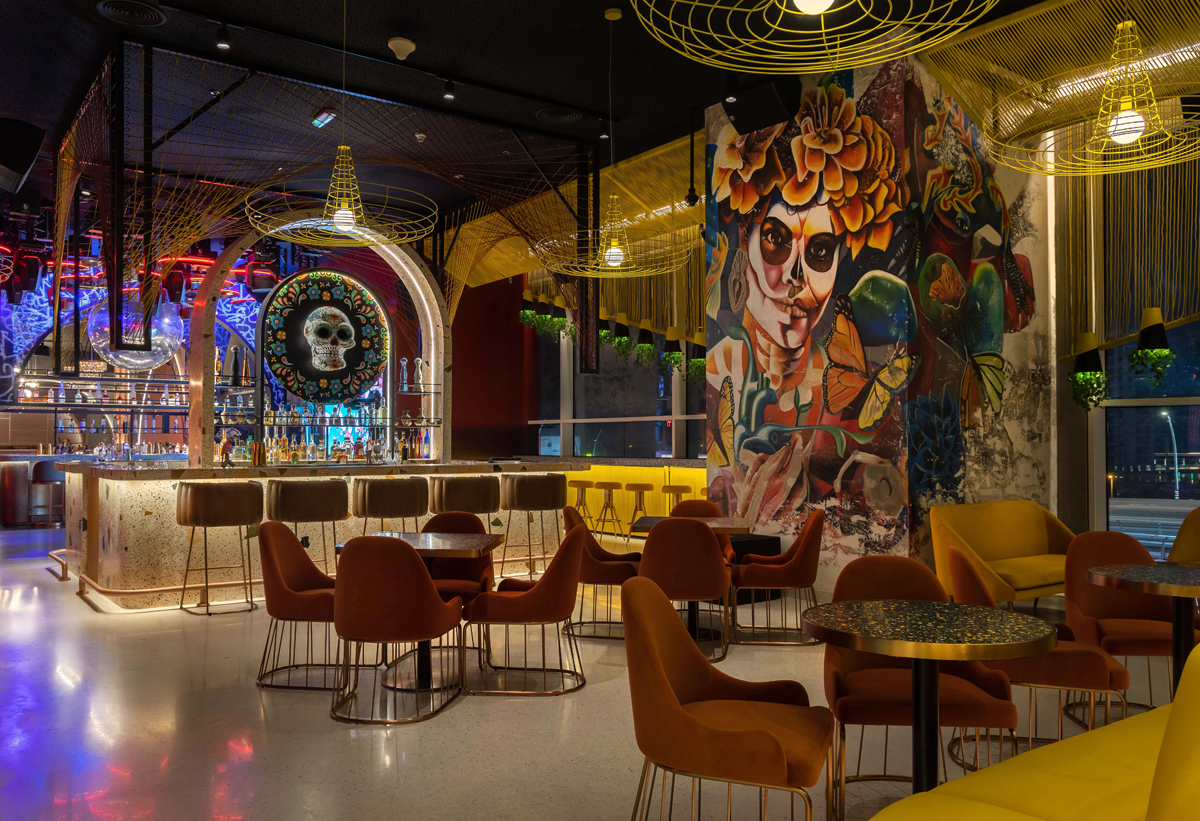
What was your team’s highlight of the project?
The Entrance. It has an impressive, eccentric entrance with red pipe and greenery installation that hangs from the ceiling and customized carpet below.
The transformation. The venue is designed with the ability to transform. As the evening draws to a close, you can dine in style at a chic restaurant. As night time falls over the city the restaurant metamorphoses into an elegant party venue.
Integrated into the design are both architectural lighting and entertainment lighting, providing the ability to have 5 different scenarios of the lighting ambience based on time and experience required.
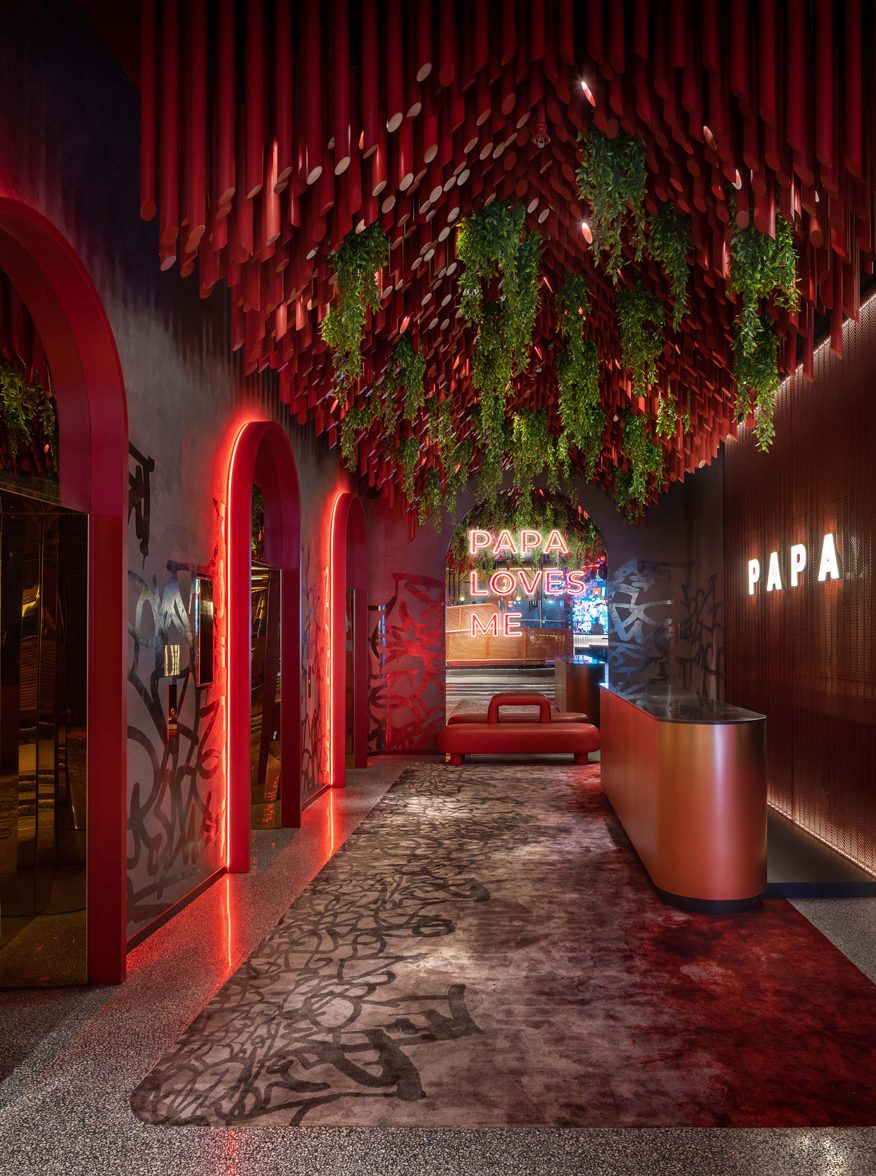
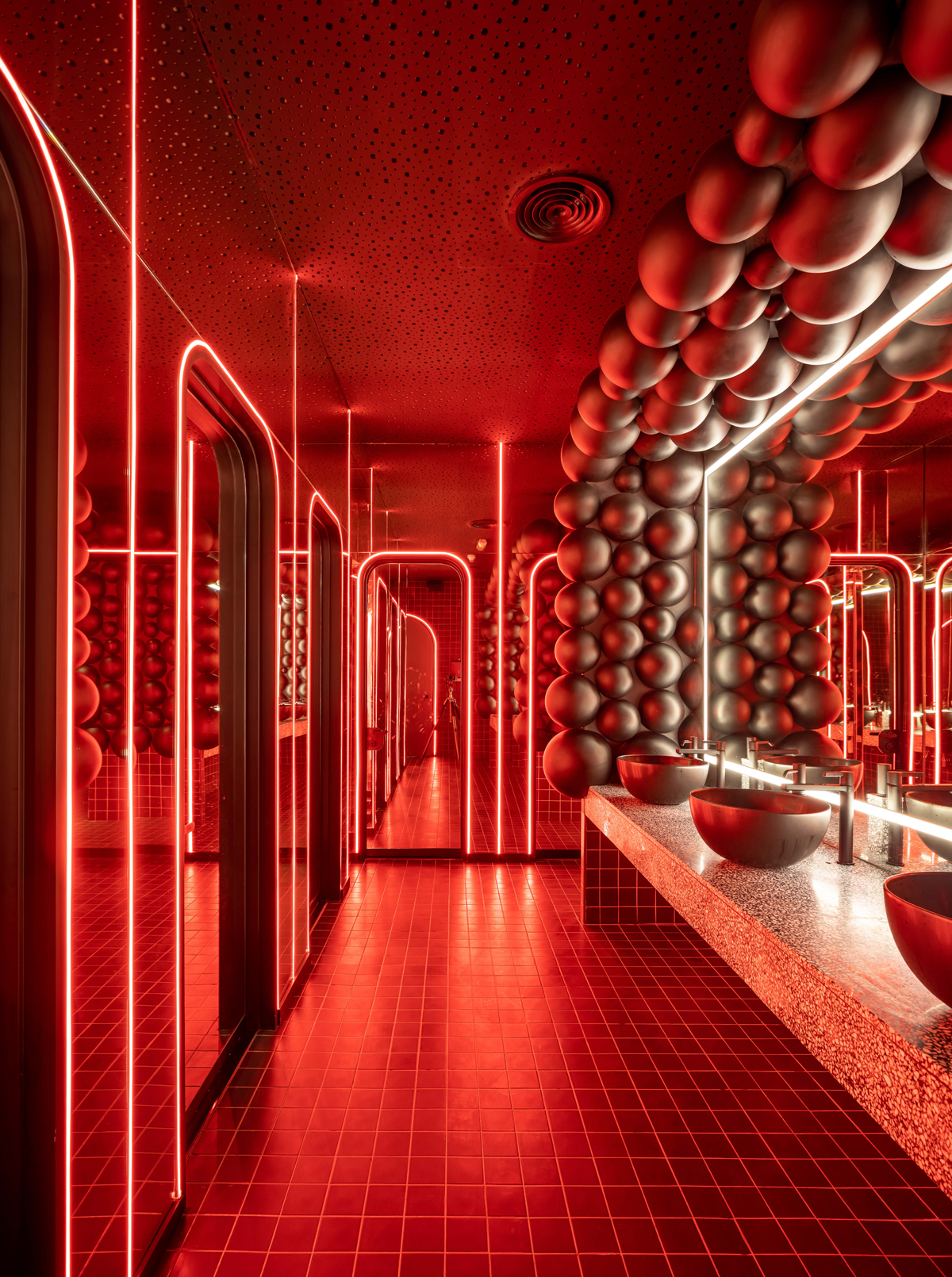
Why did you enter this project into the SBID Awards?
We've been participating in the SBID Awards yearly and it has been our practice ever since. We trust SBID for its ethics and transparency. We believe that through the SBID platform, our designs gain global recognition and give us the chance to connect with peers, press, and potential clients around the world. We became part of the international design community with new audiences on a global scale.
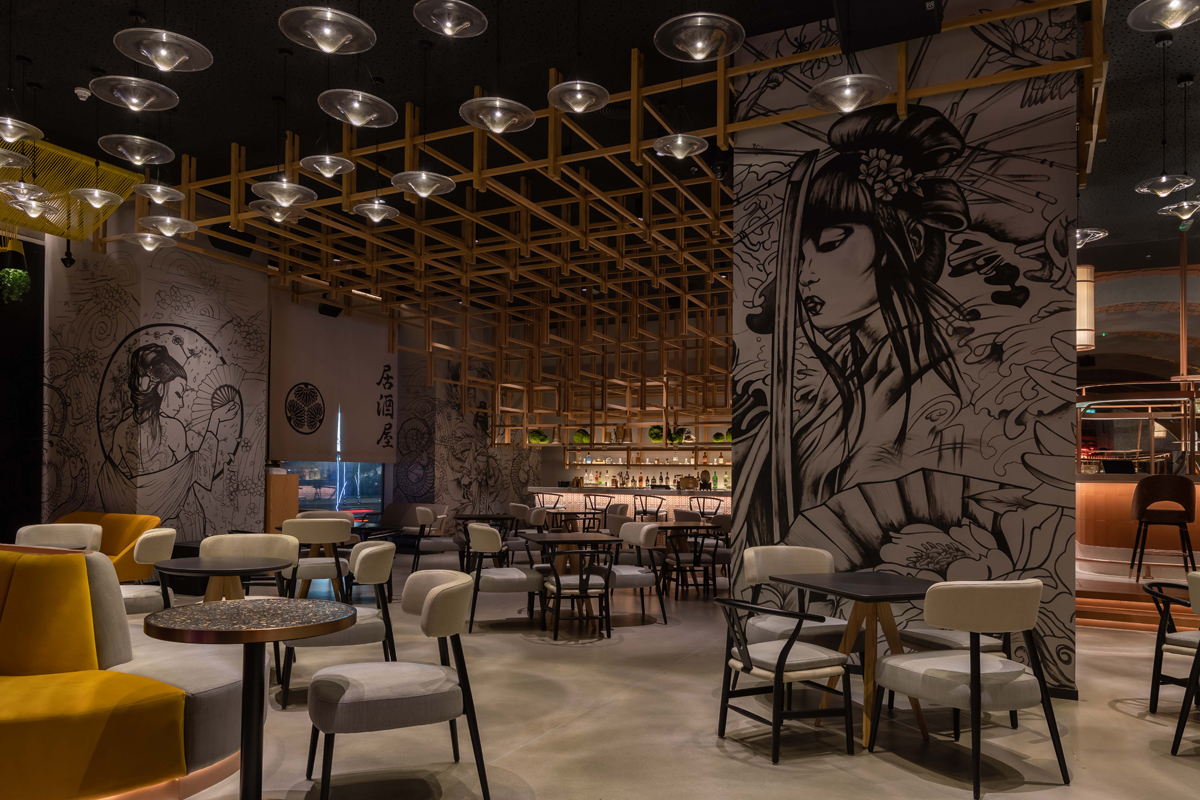
The CGI project and photos from the completed venue, compared:
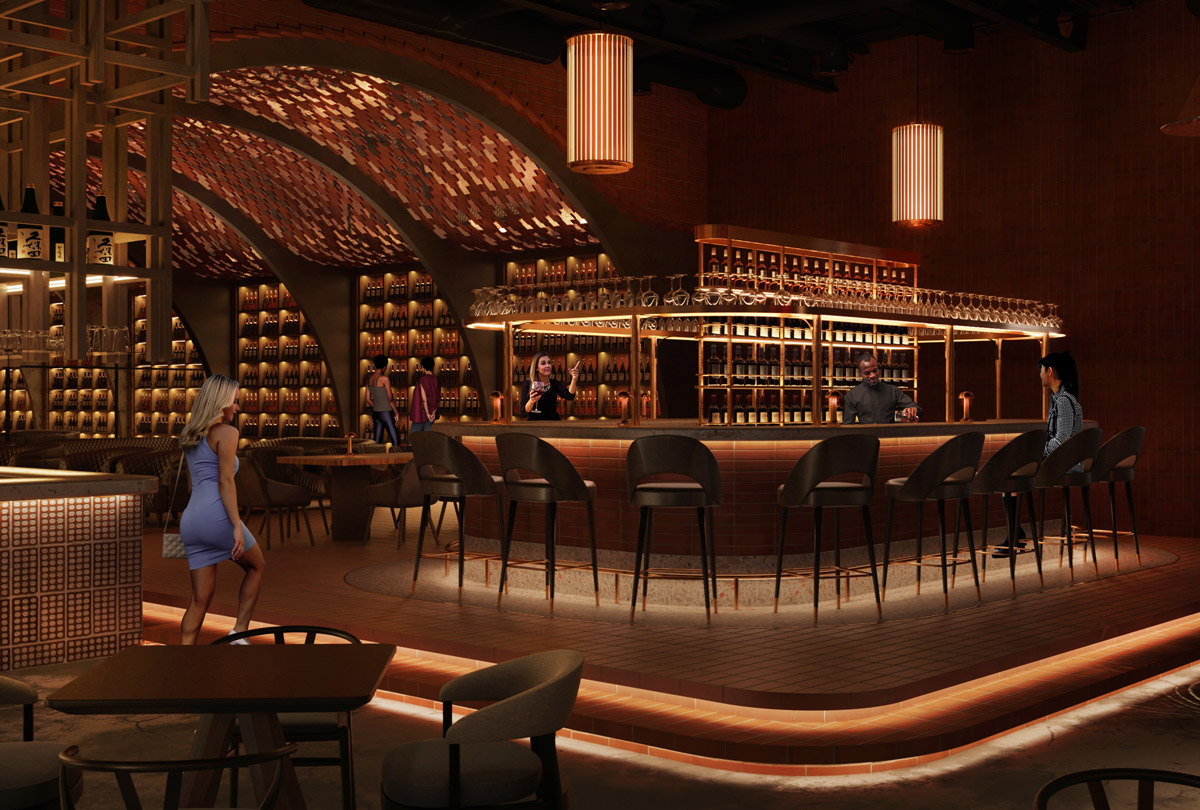
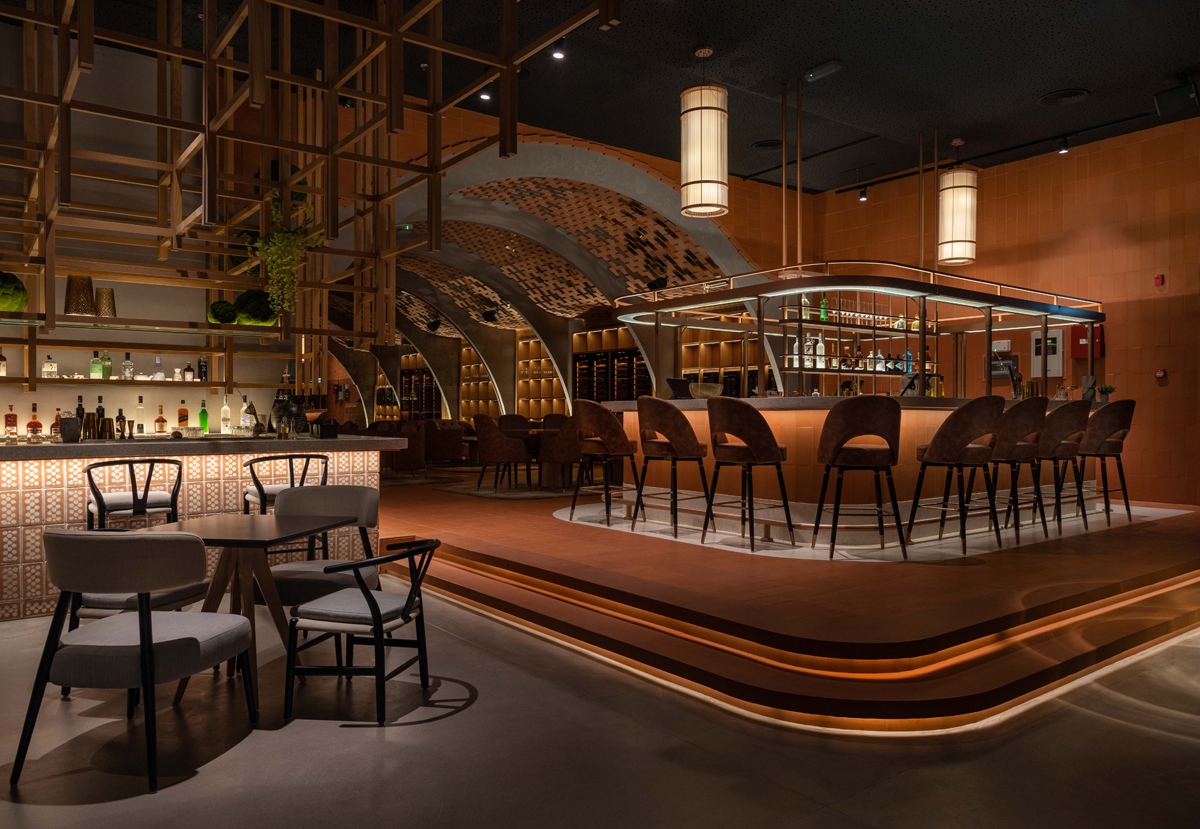
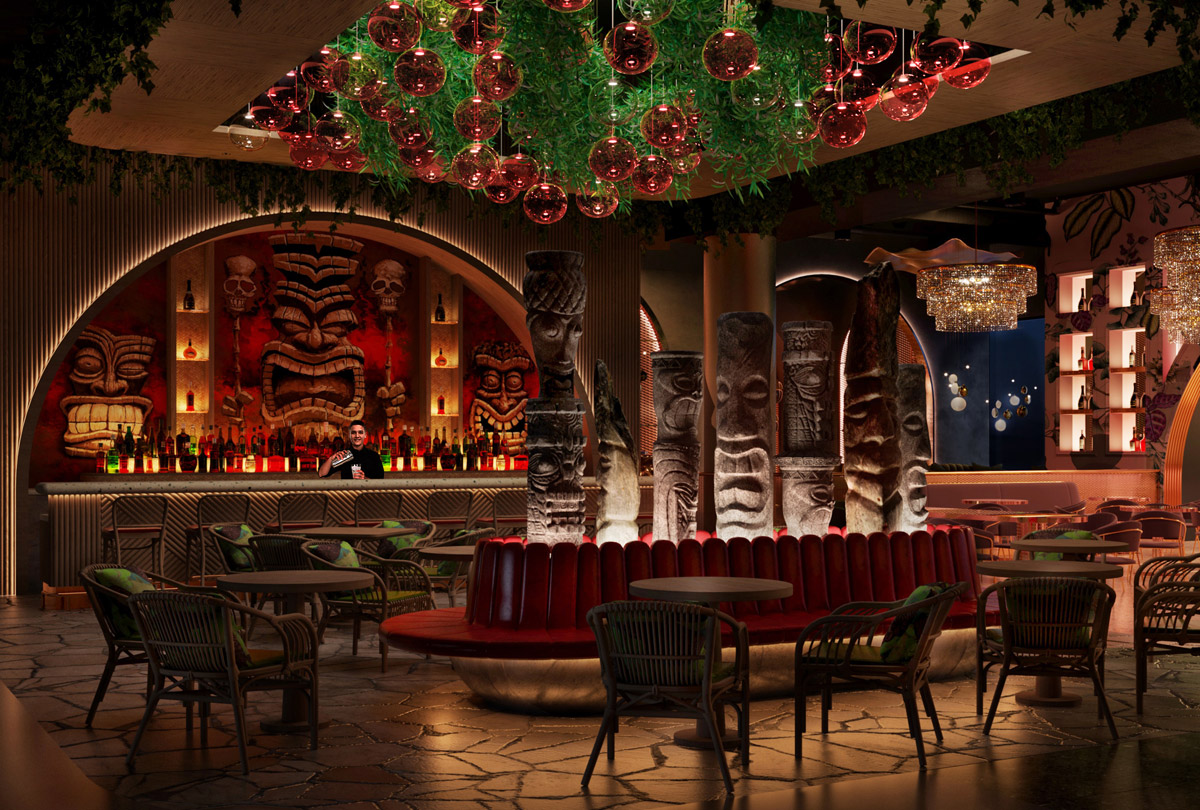
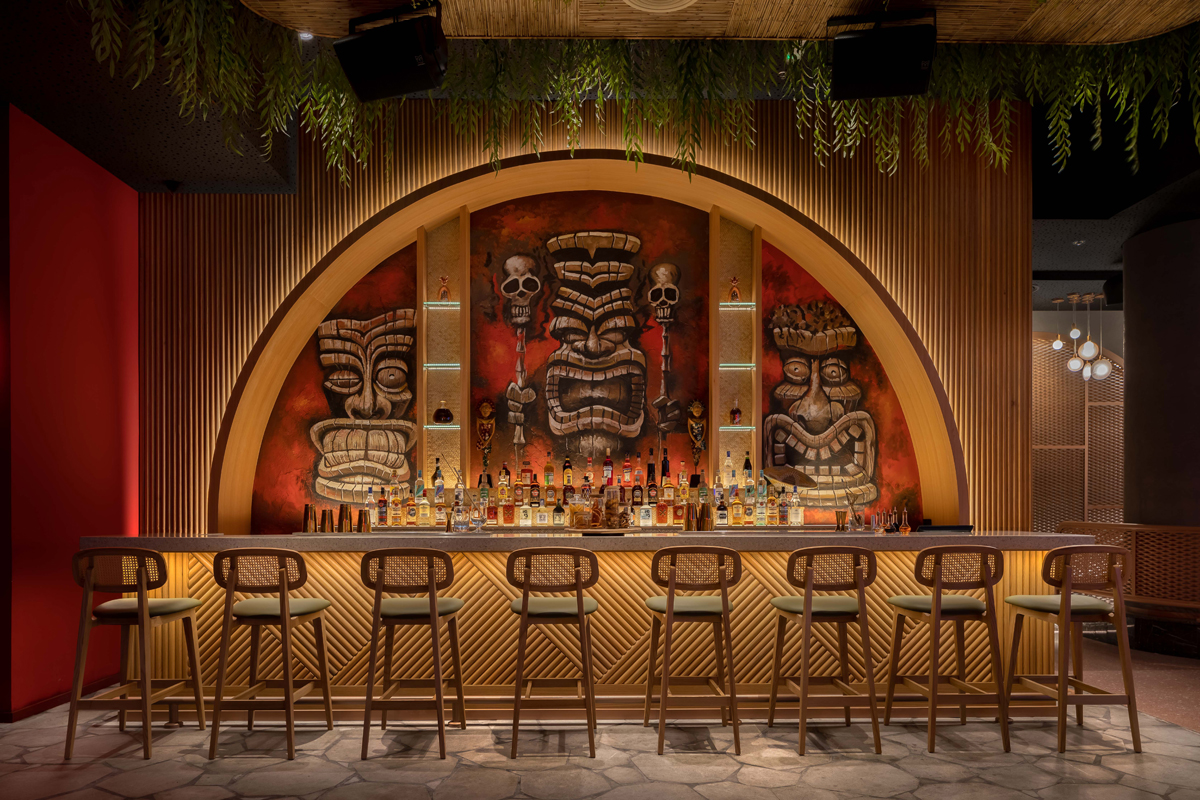
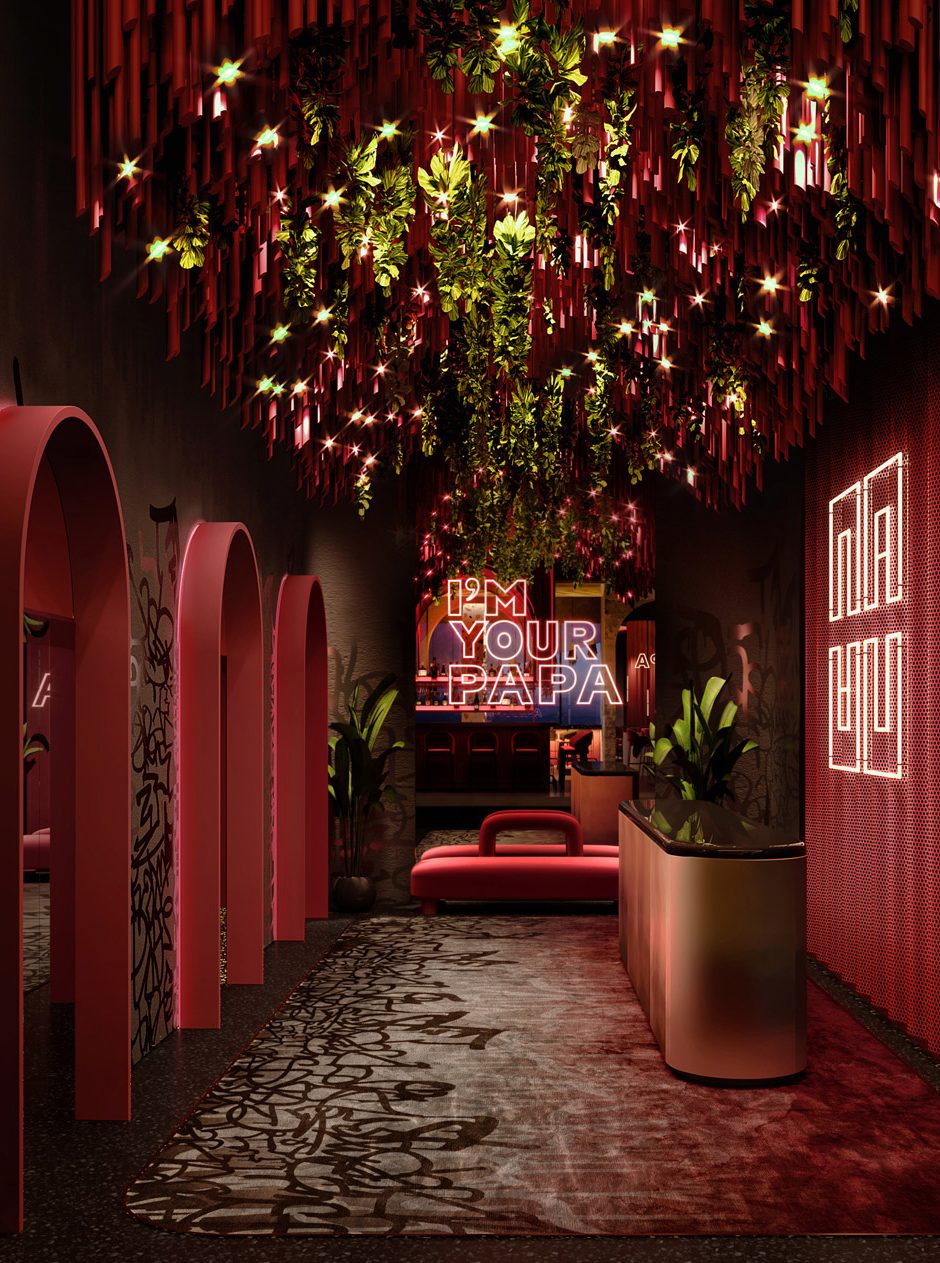

Questions answered by Mr. Firas Alsahin, Co-founder and Design Director, 4SPACE Design.
This week's instalment of Project of the Week interior design series features an arty biophilic Oriental restaurant design by 2021 SBID Awards Finalist, Deckora Design.
Yakuza is the most buzzed-about Asian restaurant of Lisbon set at the ground floor of Hotel AVANI AVENIDA and offering the best selection of creative sushi in town. Deckora Design assisted the wider Minor hotel group in shaping a refined yet eccentric environment featuring fine walnut details, polished stone superficies
and hand-painted art murals.
The original commercial space, situated amid a dense urban context in the back yard of a busy high street, represented a challenge of great complexity for the designers due to the lack of natural light. The tailored made labour of Deckora Design’s team transformed a difficult space into the trendy Oriental restaurant of the Portuguese capital where art and biophilic design play a crucial role.
SBID Awards Category: Restaurant Design
Practice: Deckora Design
Project: Yakuza Restaurant
Location: Lisboa e Vale do Tejo, Portugal
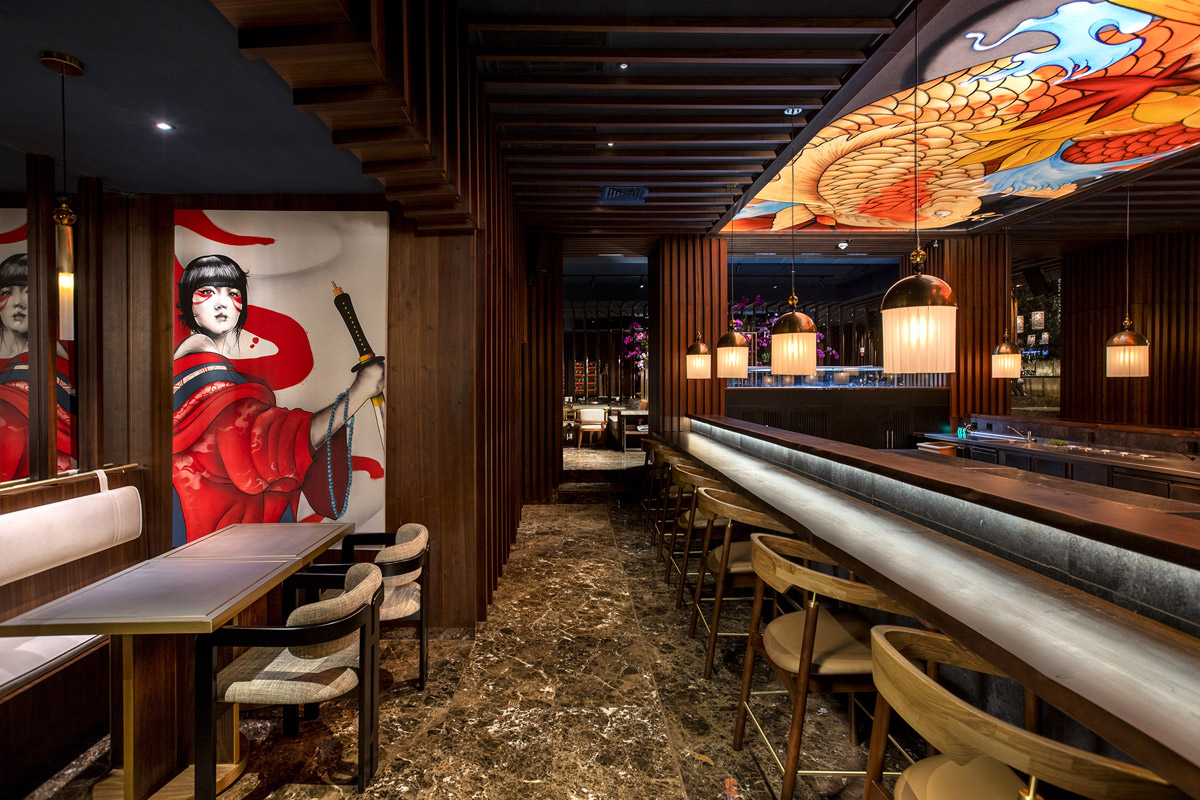
What was the client's brief?
The brief is the creation of a cosy yet seductive interior where dark fittings, comfortable furniture and warm lighting contribute to a truly unique experience for the guest.
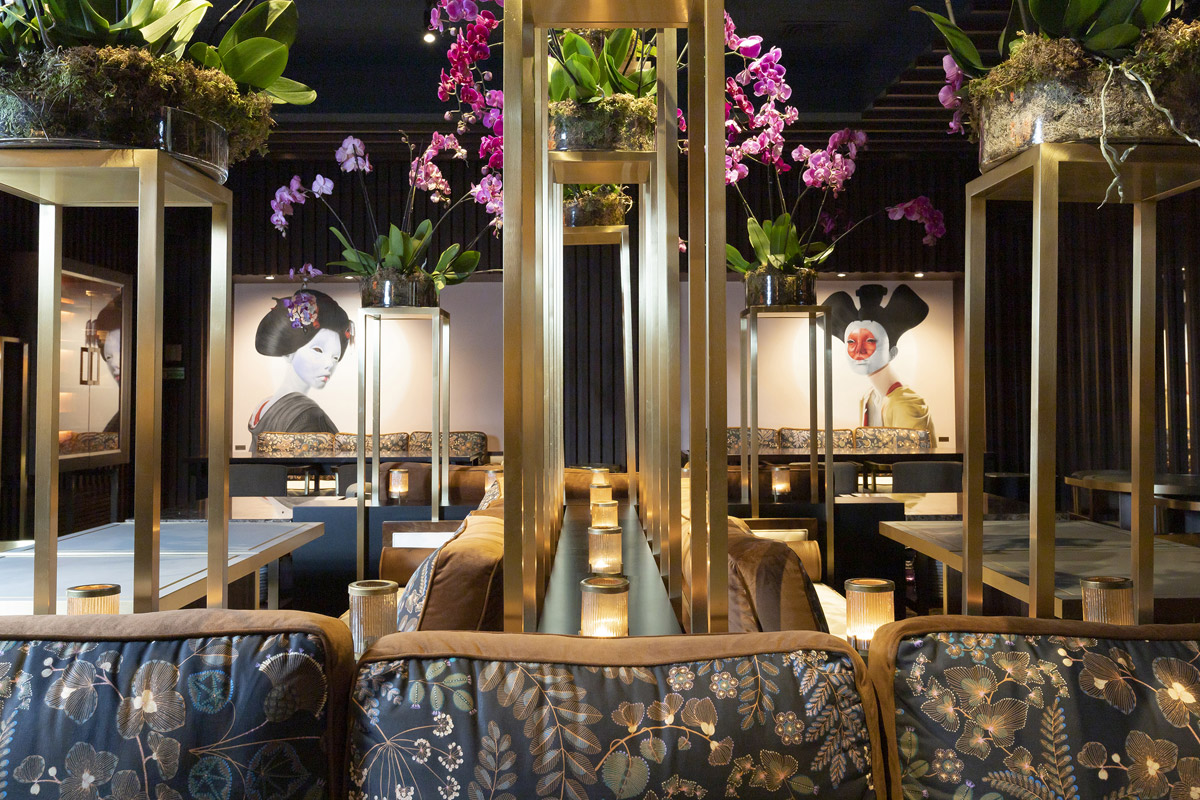
What inspired the design of the project?
The project's holistic approach, rooted in systematic design research, is considering all aspects of the environment: from architecture and lighting, to furniture and art. The concept was a modern and irreverent reinterpretation of the Japanese restaurant. The overall emblematic proposal shows how good quality design, and the successful transformation of a space, can have a successful impact and provide an authentic experience that goes beyond dining.
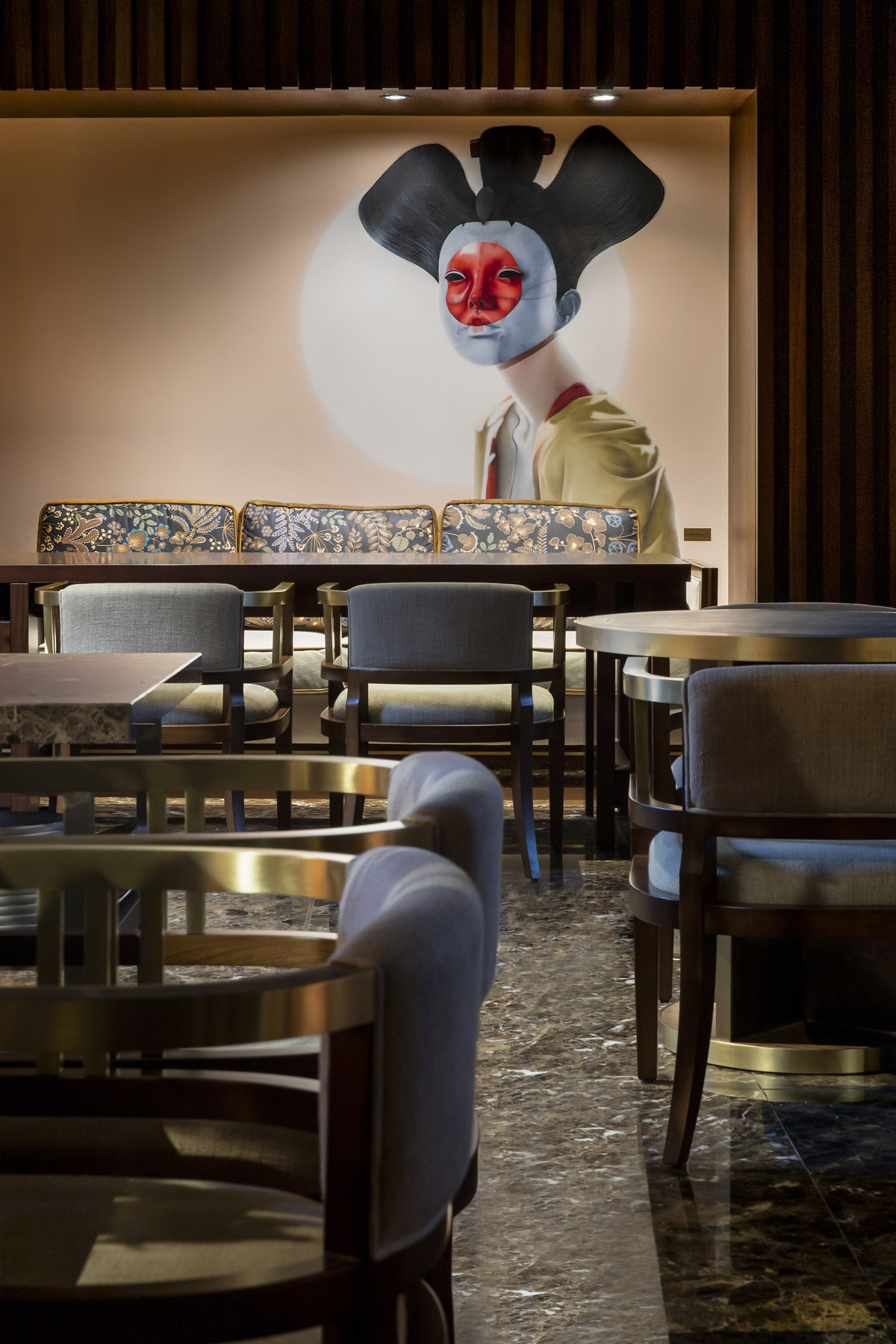
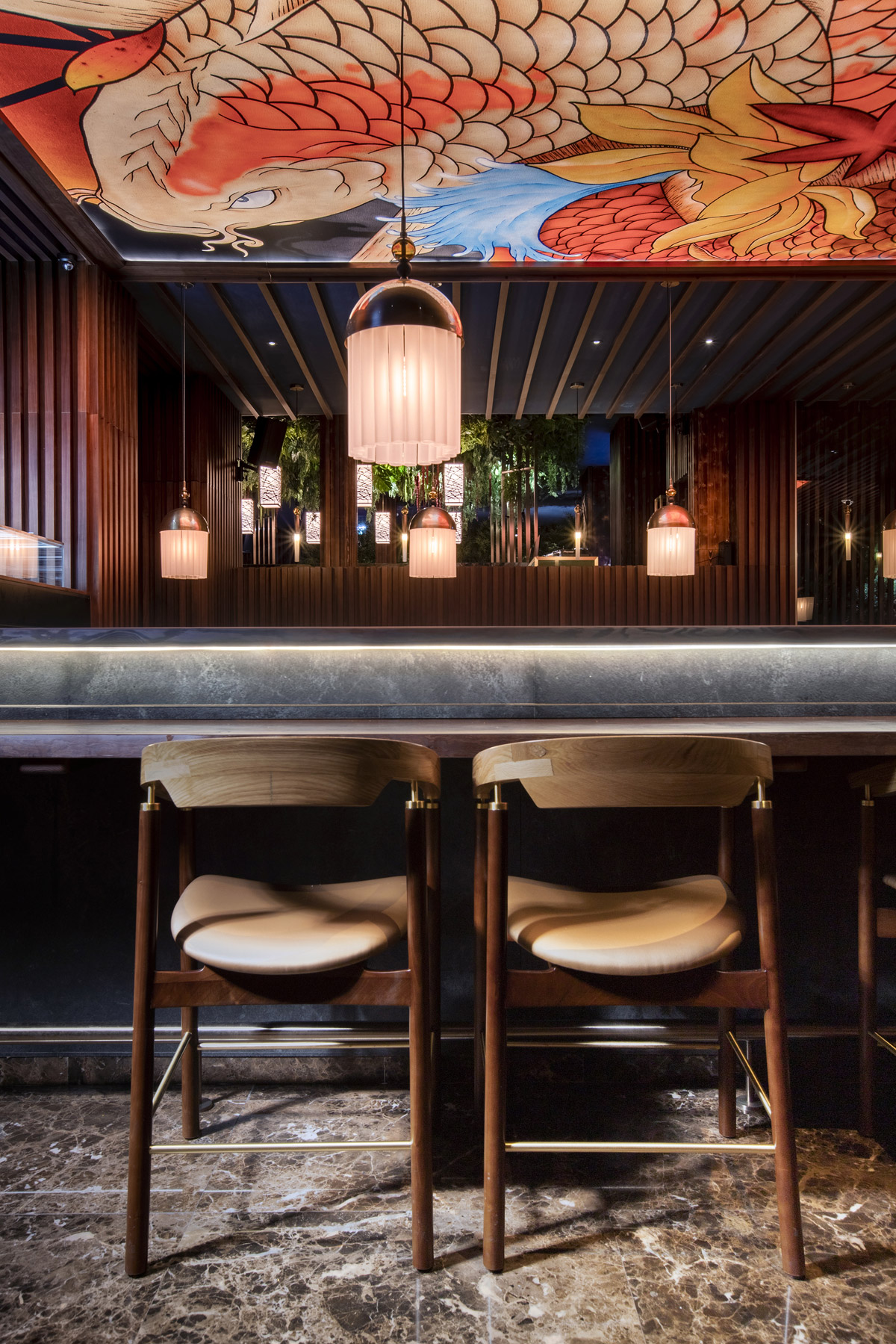
What was the toughest hurdle your team overcame during the project?
Yakuza Restaurant represented a great challenge, starting from the location situated amid a dense urban context with lack of natural lighting. Deckora Design delivered a flawless design enhancing the intrinsic characteristics of the property. The design team managed to exceed the expectations of the different stakeholders by respecting budget constraints and demanding deadlines during a world pandemic. The final outcome satisfied the client's complex brief and requirements, integrating motifs and key elements of the pre-existing Yakuza brand into a new, unique and innovative concept.
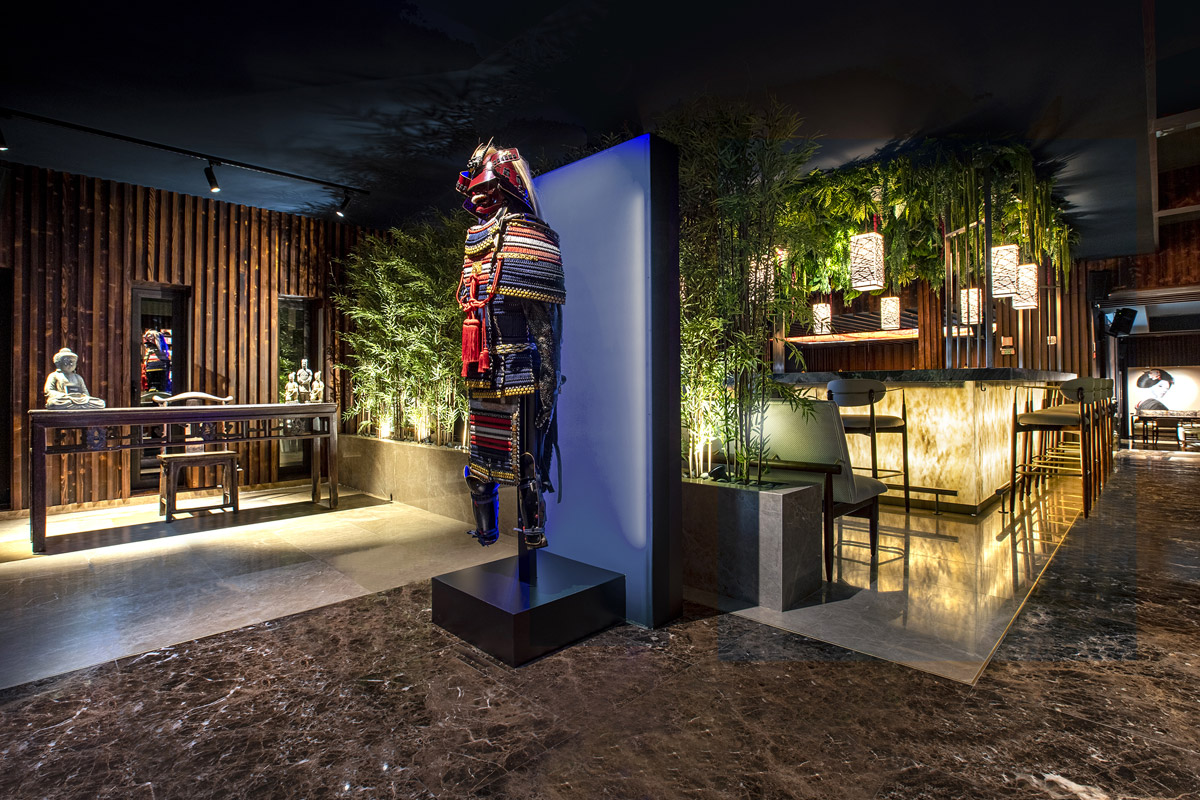
What was your team’s highlight of the project?
Art played an important role in the project; we commissioned hand-painted murals from the local artists. Art is also present in the main highlight of the project and the main attraction of the commercial space - the sushi counter, a 5x10 meters rectangular central artefact representing the beating heart. The austerity of the walnut louvers and the rigorous central slate are juxtaposed to the playfulness of the backlit ceiling canvas. This distinctive piece of art, hand painted by the urban artist Smile, is characterised by vibrant tones and portrays a huge Japanese koi, providing indirect lighting to the entire room.
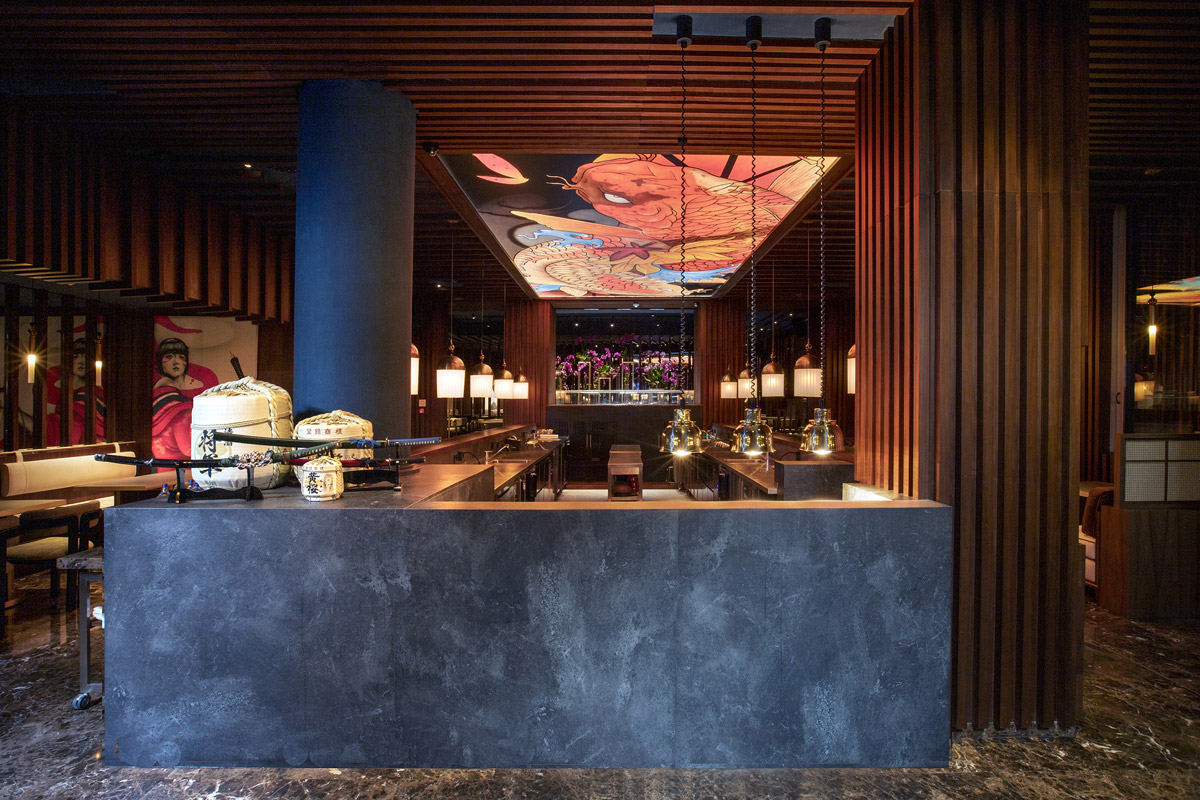
Why did you enter this project into the SBID Awards?
The SBID Awards is one of the most influential and well organised awards in the Architecture and Interior Design industries. Being part of this programme is definitely something to be proud of, and being a finalist is already a great reward for us after the great amount of care and time our project required. I also believe that getting personally involved, contributing to the community and being exposed to the work of other colleagues is an important part of our professional development.
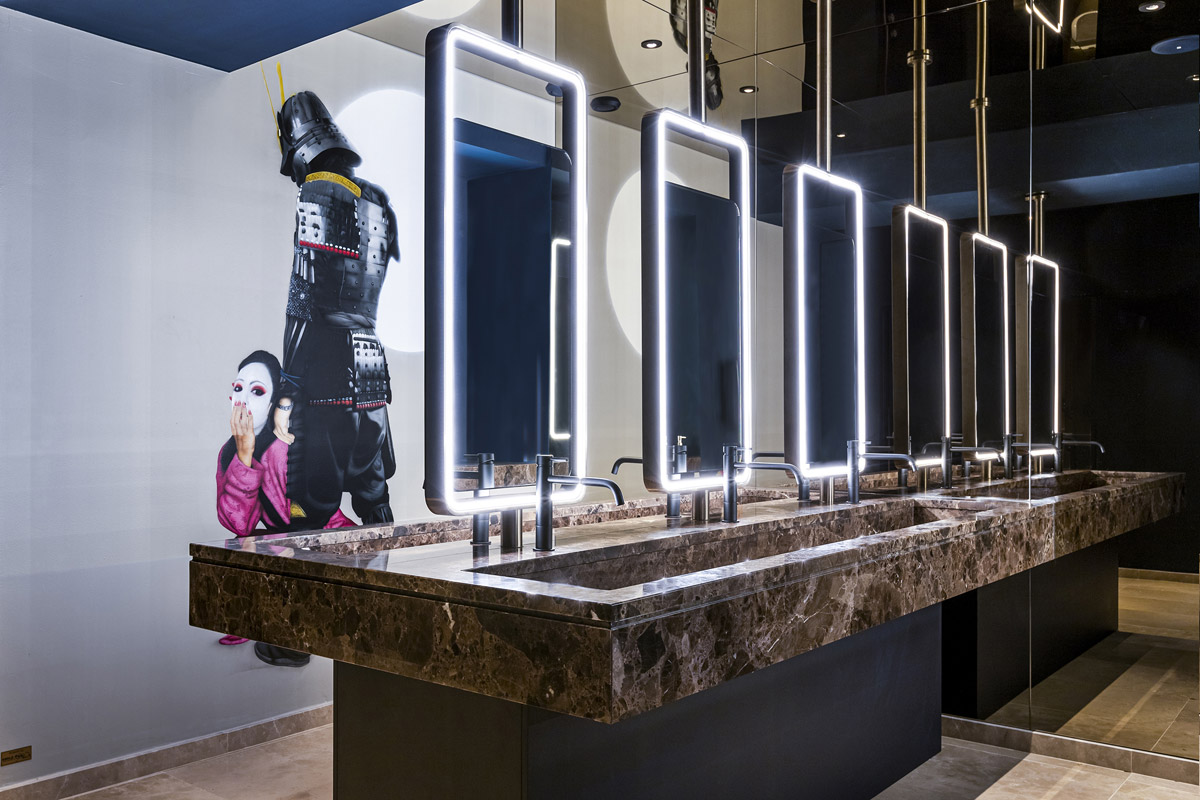
Questions answered by Camilla Degli Esposti, Director, Deckora Design.
Multi-award-winning interior designers, Ellis Design Studio have designed the new flagship Electric Shuffle venue at the iconic London Bridge, located in the very heart of central London. The venue comprises over 8,000 sqft of space, located directly under the concourse of London Bridge Station within five historic Victorian brick vault arches. Ellis Design Studio have converted these grand and atmospheric vaults into a spectacular new venue, comprising two show stopping bars and 10 shuffle table play spaces.

The venue has been meticulously designed to deliver a dramatic, experiential and conceptual space, showcasing the spectacular Victorian architecture still present below London Bridge station. The design takes inspiration from the location of the venue at London Bridge and its function as a major transport hub. This idea of connectivity and dynamism are explored within the design with nods to both the transport aesthetic and the Art Deco period as a golden age of travel.
The main bar design comprises beautifully complex triptych of arches designed to regress telescopically into the geometry of the existing brick archway. The bar includes a layering of hand painted finishes, bespoke wallpapers and custom designed joinery and metalwork detailing. The bar’s design was inspired by the movement of light as it regresses through tunnels. This idea fuses the electrical-inspired aesthetic of Electric Shuffle with the train & transport inspired elements of the scheme.

The second bar comprises a series of elongated sinuous arches, creating a sense of dramatic verticality within the space. The bar sits as a focal point stretching between the last two arches and its design was inspired by the complex arrangements of vaults and arches frequently seen in railway station architecture. Custom made chrome hemispheres set within the hand painted, illuminated arches are suggestive of over-sized rivets and the industrial-inspired ribbed timber and metal strapping details pay homage to the railway inspired aesthetic.

Custom designed lighting and bespoke designed materials reference Electric Shuffle’s Art Deco aesthetic but have been reimagined and overlaid with nods to elements of train & transport inspired aesthetics. Elements such as the dramatic oversized brass chandeliers, which run throughout the venue, have been custom designed by the Studio to pay homage to the iconic lighting found in grand railway concourses of the 20th Century.

Bespoke timber joinery has been designed to run as a central band wrapping the perimeter walls of the venue. This provides a visual and physical framework to the spaces as well as lending a sense of rhythm and continuity. The panelling, which utilises a mixture of ribbed timber, pleated velvets, metal meshes and textured glass, is reminiscent of the forms found within vintage train carriage detailing.

As part of the brief, the beautifully designed shuffleboard tables have been further evolved by the Studio to suit the complex geometry of the venue’s architecture. The shuffle table design is inspired by the aesthetic of the grand ocean liners, on which the game had its original heyday, a design which perfectly complements the design inspiration of the London Bridge scheme. Curvilinear forms in the timber and decorative copper pipework reinforce the Art Deco aesthetic along with inlaid copper details, leather upholstered detailing and laser cut metal elements, which bring together a mix of classic and contemporary, Deco and industrial.
A new dramatic cantilevered metalwork feature, which includes pleated velvet and mesh detailing, has been custom designed for the venue to support lighting and enclose & enhance the tables, reinforces the transport inspired aesthetic.

The idea of connectivity and dynamism are further explored through the use of dramatic wall mural art within the venue. The large-scale hand painted work takes inspiration from the Futurist art movement and in particular pays homage to a school of early 20th Century British artists who worked under the banner of ‘Vortism’. Their work was inspired by the kinetic energy brought to transportation through the use of electricity and the Studio has taken inspiration from this idea of movement electrification and energy.
“The essence of the interior design for Electric Shuffle London Bridge has been inspired by the energy, excitement and the age of early electrical experimentation fused with the dynamism of the early 20th century transport hubs, and the beauty & lustre of the golden age of train travel, all set against dramatic sweeping historical Victorian brick vault arches of London Bridge Station” - Alan Ellis, MD at Ellis Design Studio.

The Studio has created a beautifully designed, dramatic and conceptual interior to form an engaging and original, multi-layered scheme.
Ellis Design Studio weaves together clear design narratives in their work through an artisanal approach, focused on meticulous detailing and beautiful craftsmanship. The Studio works with a range of experts with experience across a vast array of fields including lighting & furniture designers, fine artists, ceramicists, glassblowers, metalworkers and artisans to name a few. Consequently, their work is imbued with a sense of provenance, uniqueness and a carefully crafted element of storytelling.

The Studio has been shortlisted and won several prestigious design awards for its work in the hospitality sector including being shortlisted for a Design Week Award 2020 and recently winning two prestigious Restaurant & Bar Design Awards 2020.
About Ellis Design Studio
Ellis Design Studio is a multi-award-winning Interior Design studio specialising in hospitality interior design projects. The studio was founded in 2017 with a team who have extensive experience across restaurants, bars, 4- & 5-star luxury hotels, private members clubs and experiential / competitive socialising venues.
If you'd like to feature your project on SBID, get in touch to find out more.
To become an accredited member of the SBID, click here.
The revolutionary ultra-compact surface, Dekton® by Cosentino has been specified at the trendy Kol restaurant in Marylebone, London. Opened in October 2020 by former Noma Mexico chef Santiago Lastra, his debut restaurant Kol brings together Mexican cuisine with local British produce, including shellfish from Scotland's shoreline and foraged ingredients from Kent's woodlands. Kol offers a set menu of unique, thoughtfully curated dishes with plenty of flavour, such as short rib with quince mole, and squash sorbet with rattlesnake chilli.
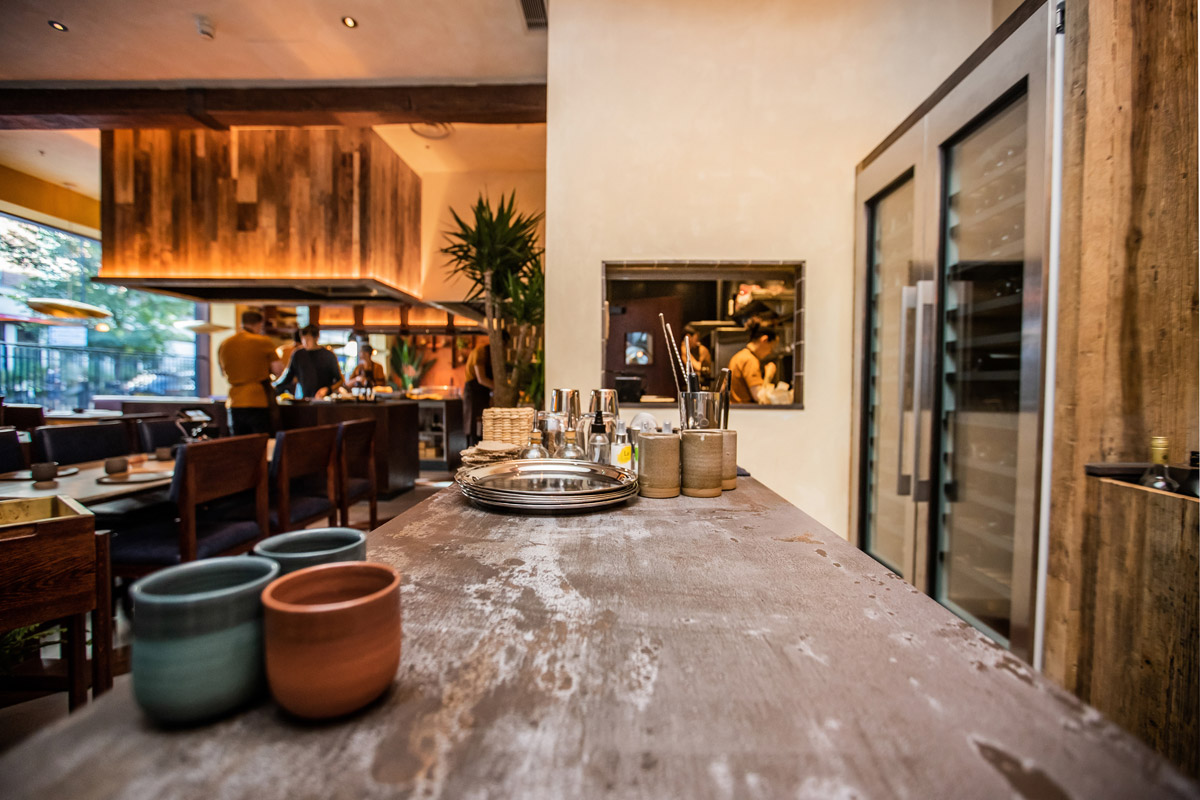
Designed by A-nrd Studio, Kol's distinctive open plan layout with its kitchen as the central focus pays homage to Mexico with its warming, vibrant colour palette, while also incorporating a sense of pared back, minimalist Scandinavian design with plenty of wooden elements, straight lines and foliage. Spanning across two levels and five hundred square meters, the restaurant also boasts a mezcal bar on the ground floor, for serving up Mexican cocktails and spirits to guests.
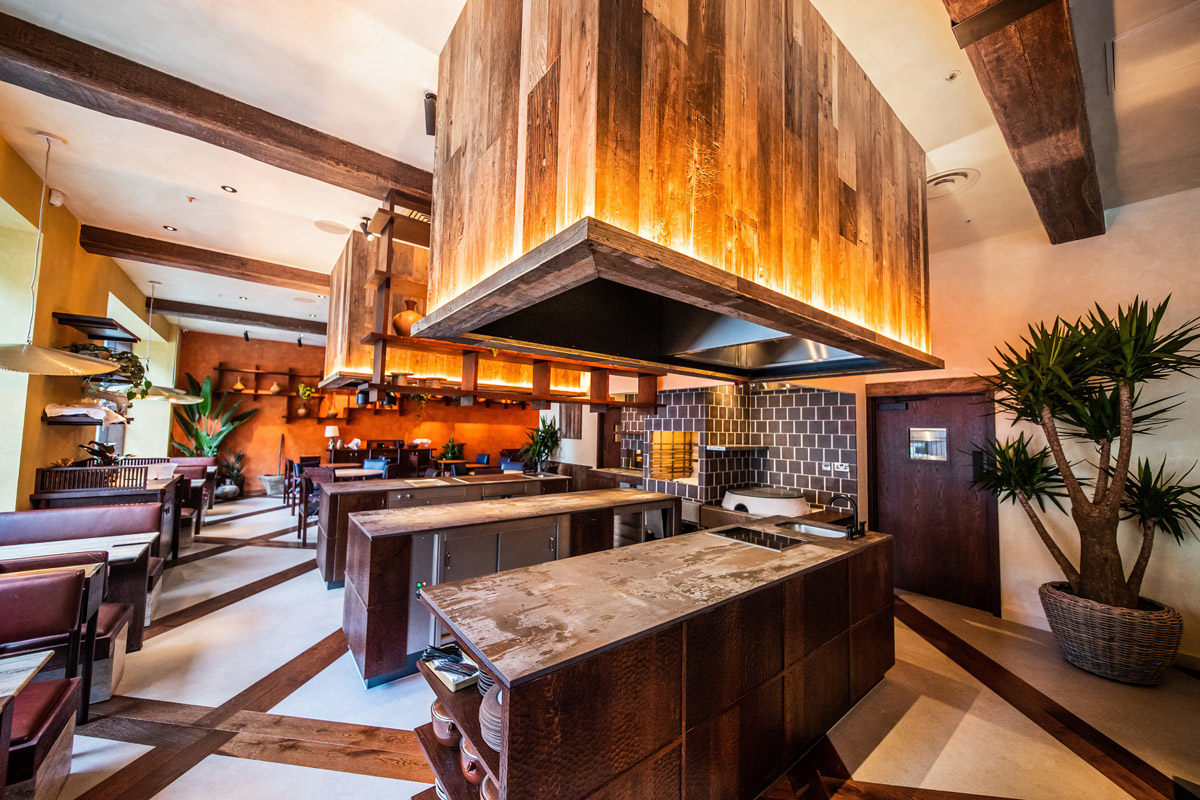
Fabricated by LBS Enterprises Ltd, bestselling Dekton® Trilium, made from up to 80% of recycled materials, was the surface of choice throughout the restaurant's kitchen and serving areas. Showcasing a mixture of colours inspired by volcanic rock, Dekton® Trilium's intense and irregular accents of black and grey and its matte finish result in a rich and varied surface design, with an appearance that alters depending on the angle of the light on the surface.
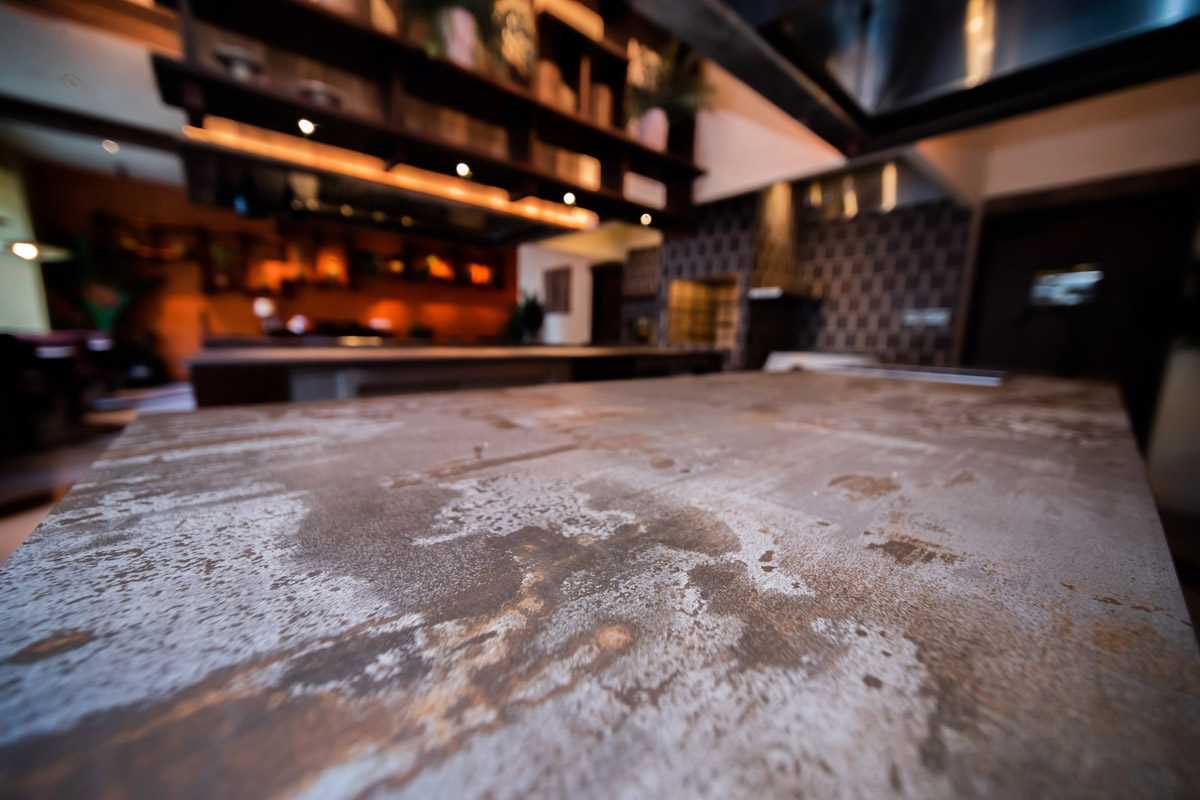
"Dekton was always the surface of choice for my new Kol restaurant in Marylebone, London," says Santiago. "Its technical properties exceed the other options available and there is so much choice when it comes to the look and feel of the surface; it was difficult to choose a colour! We decided that Dekton Trilium was perfect for helping to convey the relaxed yet fun feel that we wanted in the restaurant - plus, we loved the fact that Dekton Trilium is made from 80% recycled materials. I am so pleased with how Trilium has brought the open-plan restaurant kitchen design to life, and its durability is second to none."
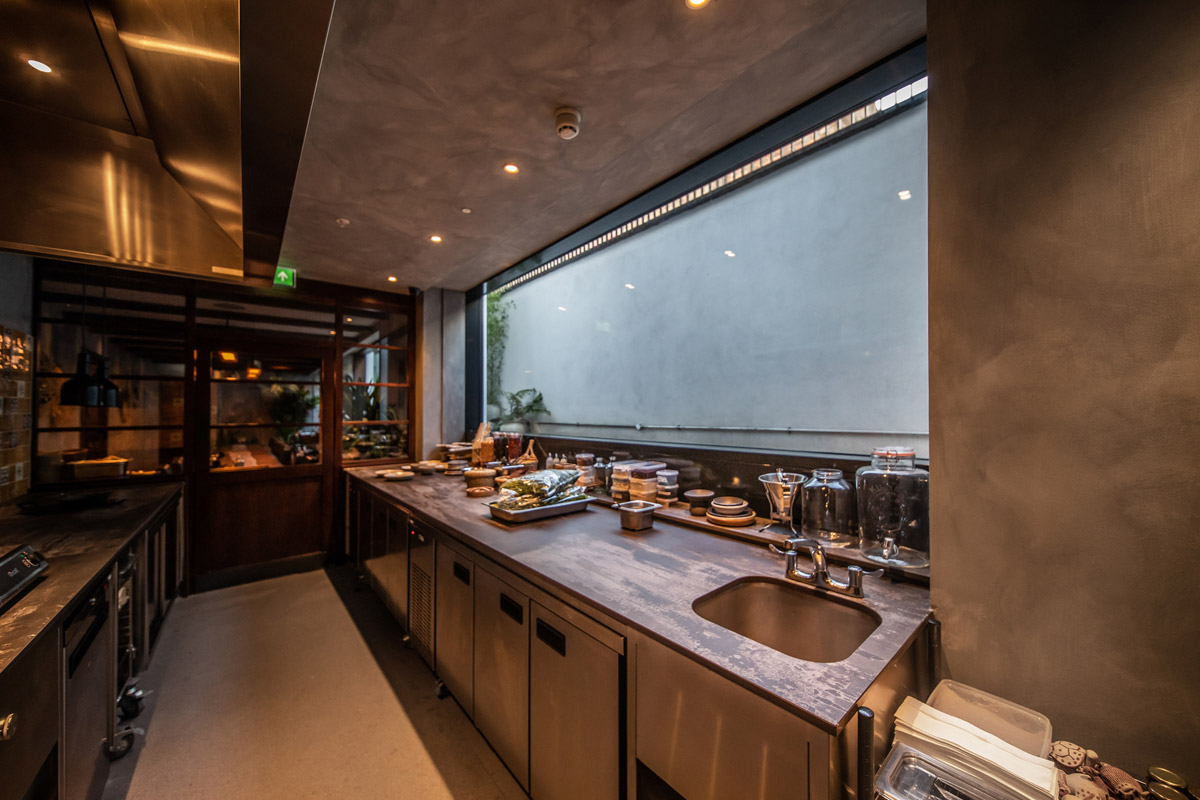
As with all Dekton® designs, Dekton® Trilium boasts superior technical properties, such as high resistance to UV rays, scratches, stains and thermal shock, and very low water absorption. Made from a sophisticated mixture of the raw materials used to make glass, next-generation porcelain surfaces and quartz surfaces, Dekton® is suitable for a variety of different projects, including worktops, flooring and wall cladding, both inside and outside. Dekton® Trilium is also available in Dekton® 4mm Slim, which combines the technical and mechanical features that Dekton® is known for with a much thinner (4mm), lighter (10 kg/m2), and manageable format for installation - ideal for wall, door and furniture cladding.
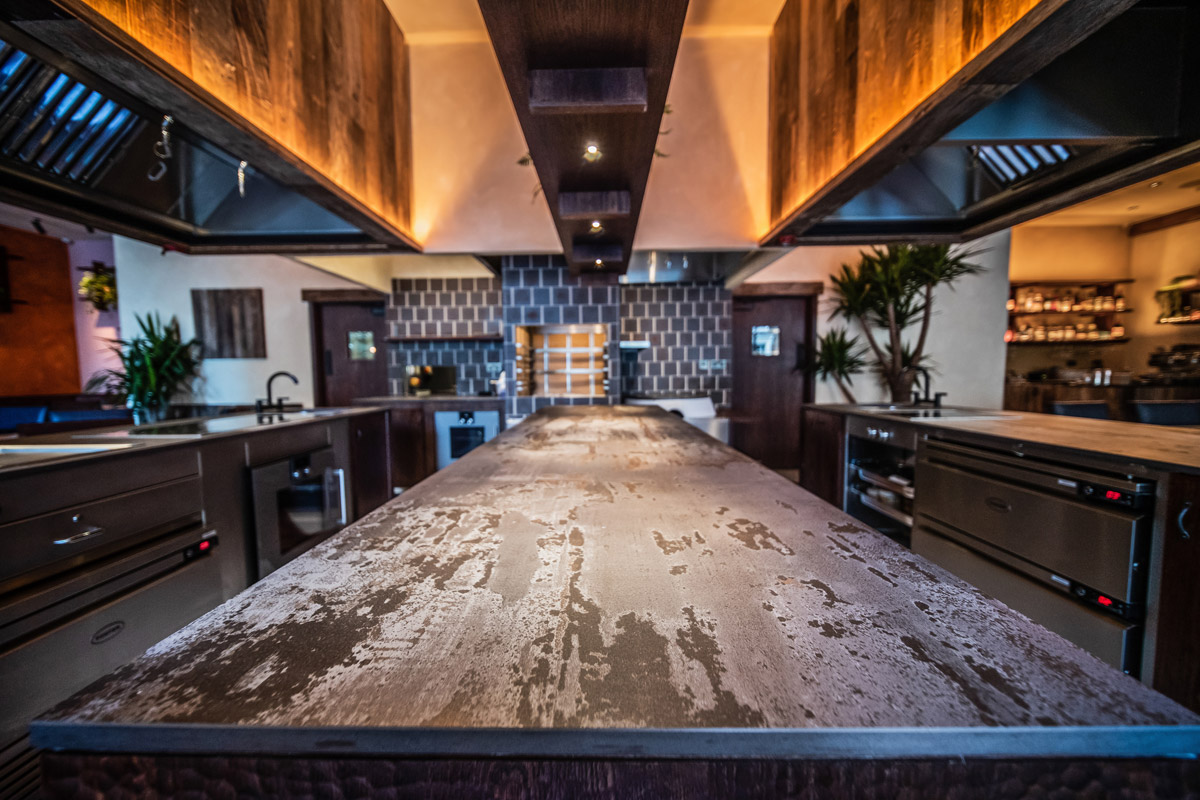
In addition, carbon neutrality has been achieved for the entire life cycle of Dekton® (from cradle to grave), covering Scopes 1, 2 and 3, from the extraction of the raw material, to the use of the product and the end of its life. This recognition, obtained through emission reduction and compensation projects certified by the United Nations, confirms the good practices of Cosentino Group in terms of sustainability and environmental management.
Image credits: Bircan Tulga, Black Edge Productions.
About Cosentino
Cosentino Group is a global, Spanish, family-owned company that produces and distributes high value innovative surfaces for the world of design and architecture. It works together with its clients and partners to provide with solutions that offer design and value, and inspire the life of many people.
If you’d like to feature your product news here, get in touch to find out more.
If you’d like to become SBID Accredited, click here for more information.
This week’s instalment of Project of the Week series features a renovation project of a Victorian Eatery by 2021 SBID Awards Finalist, Blue Sky Hospitality.
MAGENTA restaurant, bar, and private dining, have been created from the conversion of a 19th century bank building, located on the corner of Euston and Belgrove road, just across St Pancras and Kings Cross train stations.
What if… in 1880, British engineers and scientists from the St Pancras Coal, Steel and Gas industries had decided to create their own eatery? Enlisting help from the large community of Italian immigrants based around Kings Cross, they would have built a venue celebrating ‘La Dolce Vita’ with an authentic, local British identity. A place for libations and celebrations of everyday life, until it closed, swept away by the turmoil of time.
What if… 141 years later, the premises were renovated and updated with a modernist sensibility and reopened… transformed into a giant art installation? A bar and restaurant within an indoor pergola of Victorian industrial architecture, dressed in a palette of coal, steel and oak, upholstered with magenta wool and anthracite leather. An evocative space where thousands of butterflies, flutter overhead, in shimmering hues of pink and silver, to a cinematic soundtrack punctuated by atmospheric bird songs. The result might look, taste, and feel like what “MAGENTA” is today.
SBID Awards Category: Restaurant Design
Practice: Blue Sky Hospitality
Project: Magenta
Location: London, United Kingdom
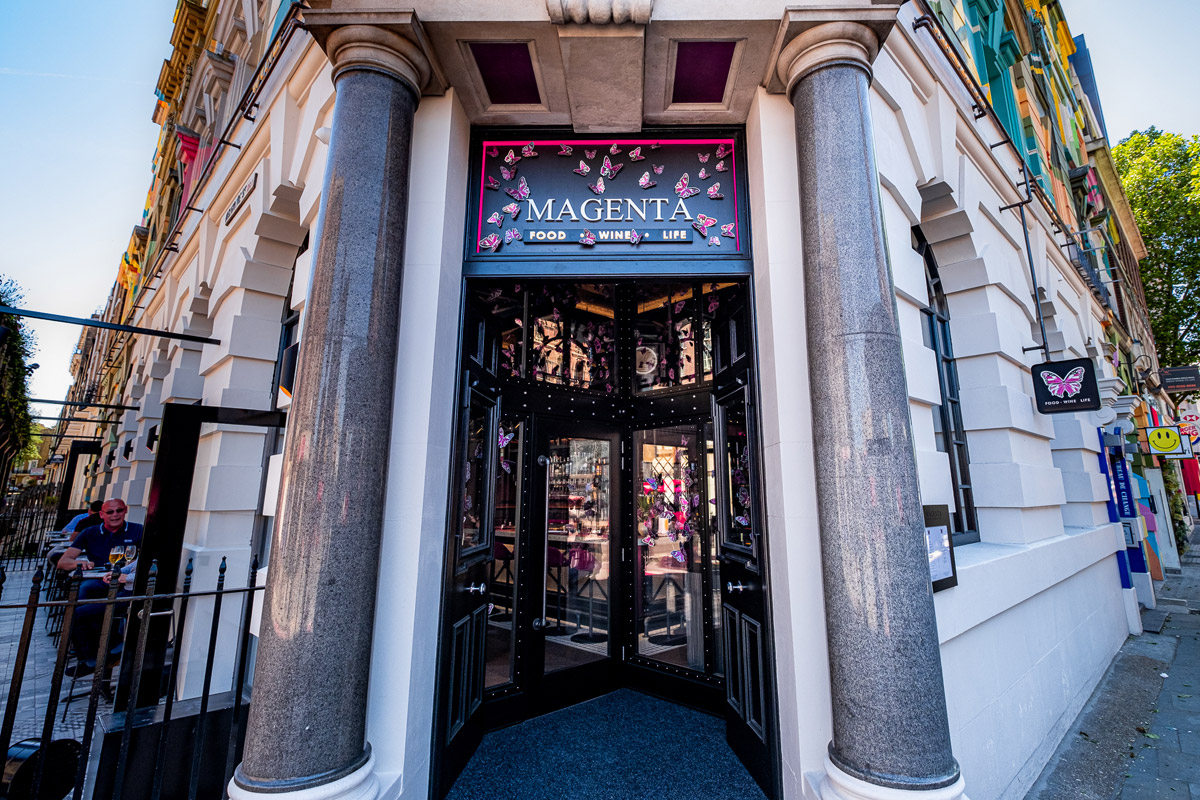
What was the client's brief?
The brief was to convert an existing bank within a 19th century building into a restaurant and bar with a design that will optimise the internal volume and reduce impact of constraints, draw inspiration from its location, provide a joyful environment for staff and customers, offer a unique, memorable social space and enhances the neighbourhood of Kings Cross- St Pancras.
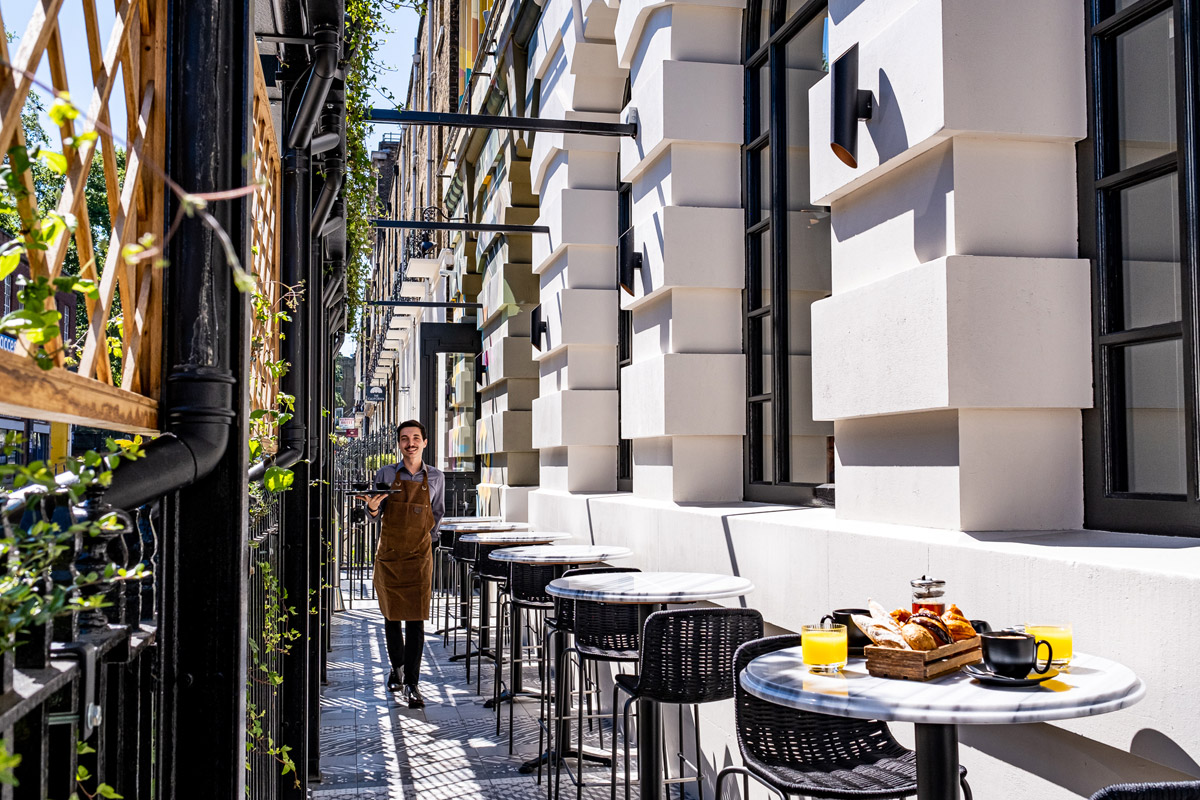
What inspired the design of the project?
The main inspiration for the design was a story about Kings Cross in 1880 - blending facts and fiction.
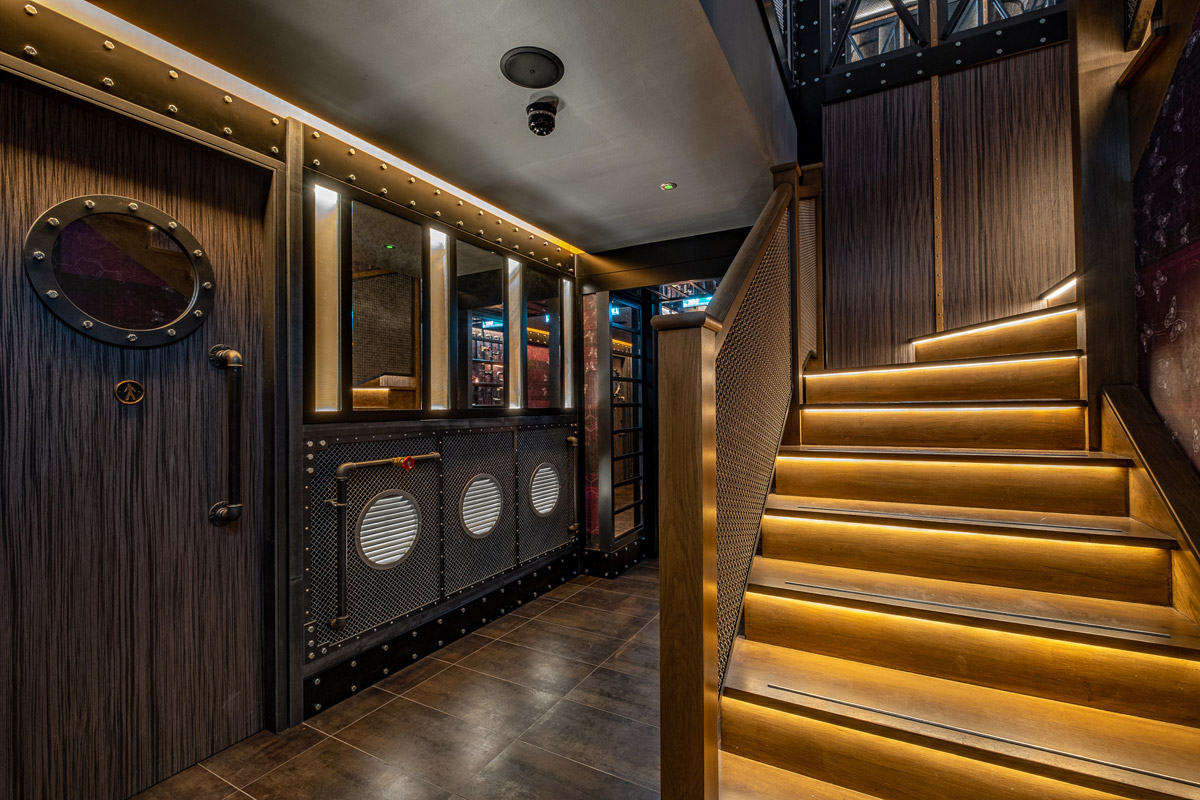
What was the toughest hurdle your team overcame during the project?
The most challenging part of the brief was optimising the internal layouts to make it efficient to operate and provide a pleasant customer experience…while respecting the period architecture of the façade.
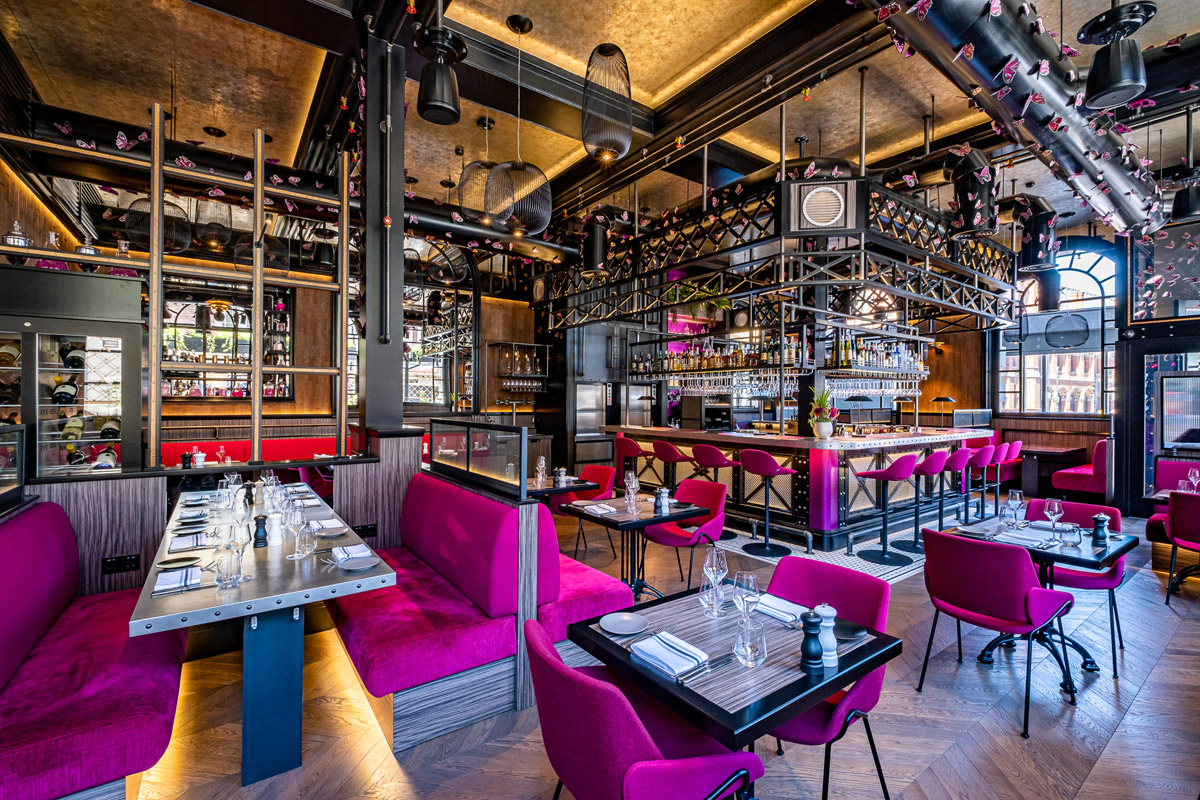
What was your team’s highlight of the project?
The most exciting part of the project was the creation of a ceiling art installation using 5,000 metal butterflies.
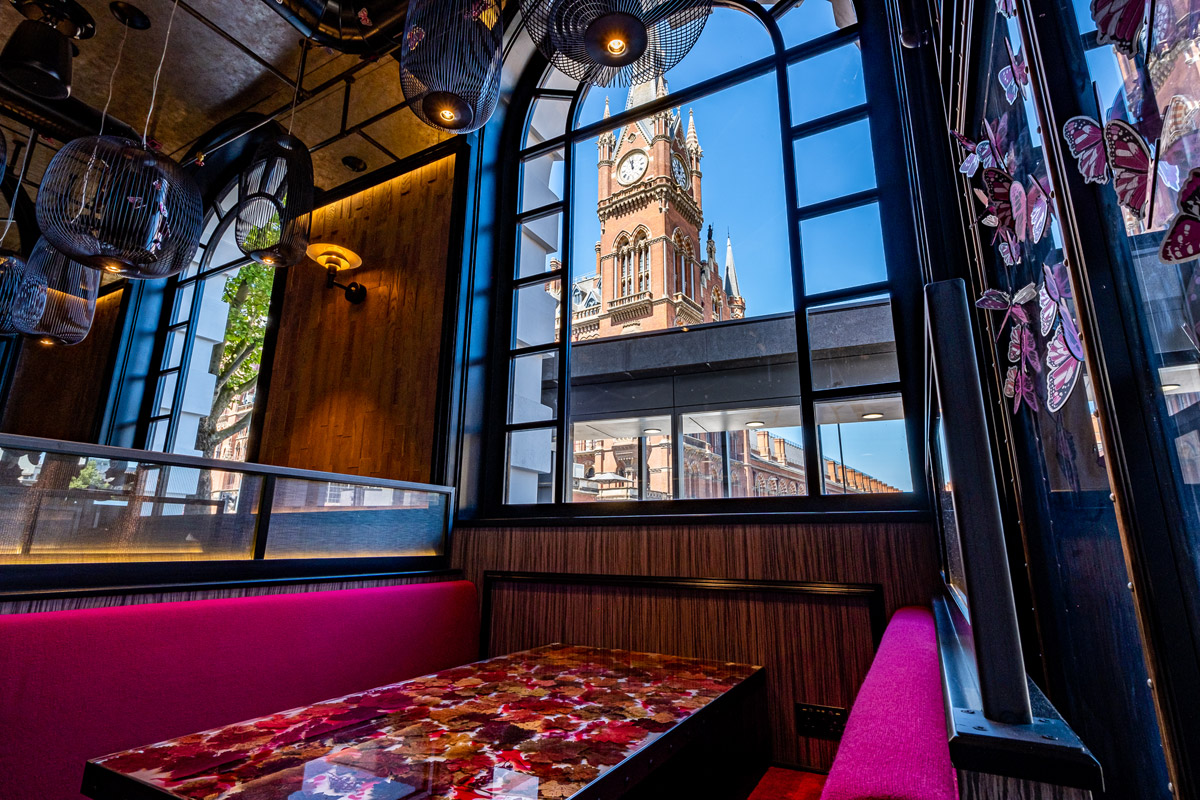
Why did you enter this project into the SBID Awards?
It is always an exciting experience to enter awards, however given the calibre of work and entries into these global awards, it makes it even more special.
Questions answered by Henry Chebaane, Creative Director, Blue Sky Hospitality.
